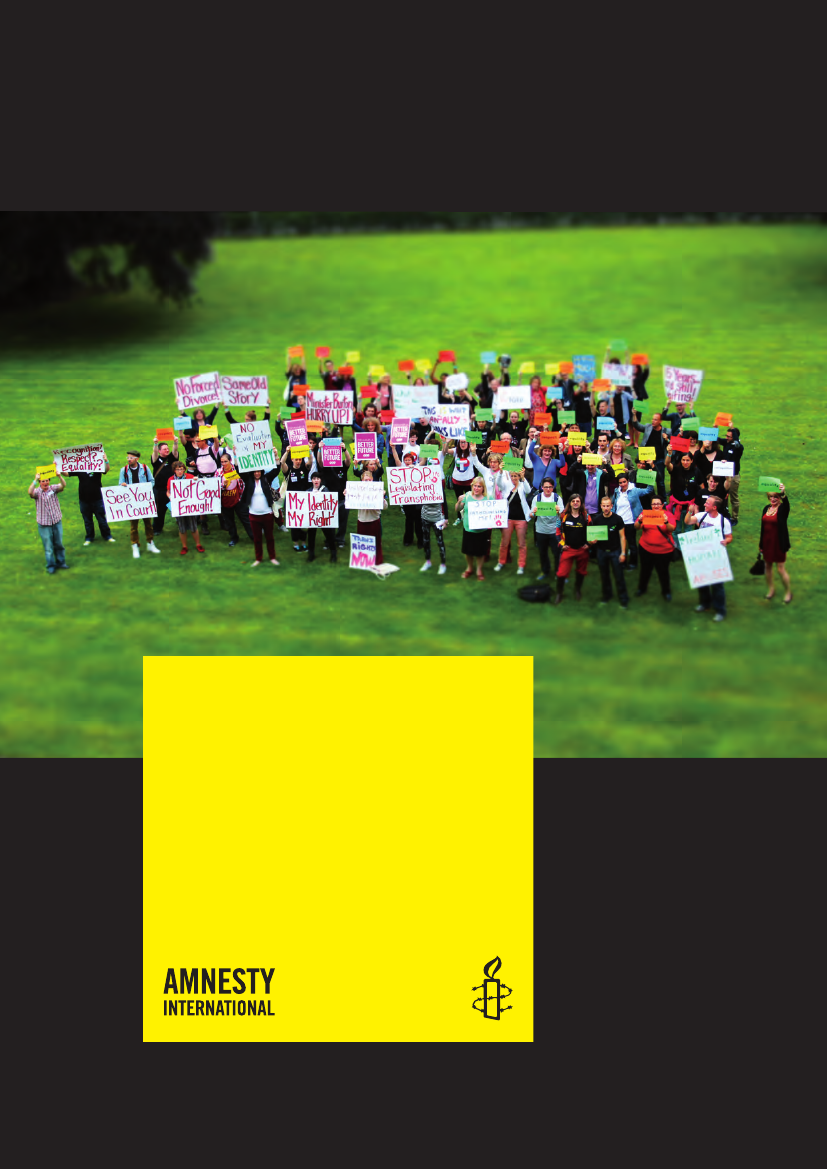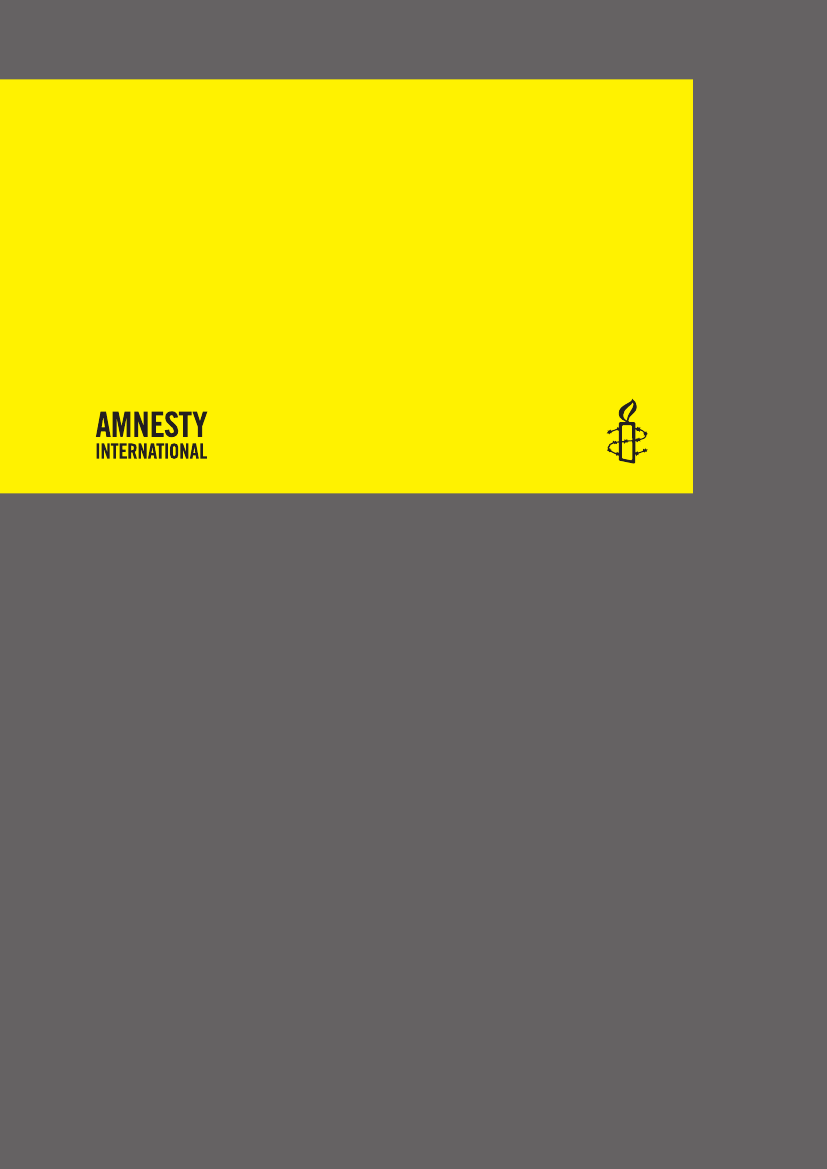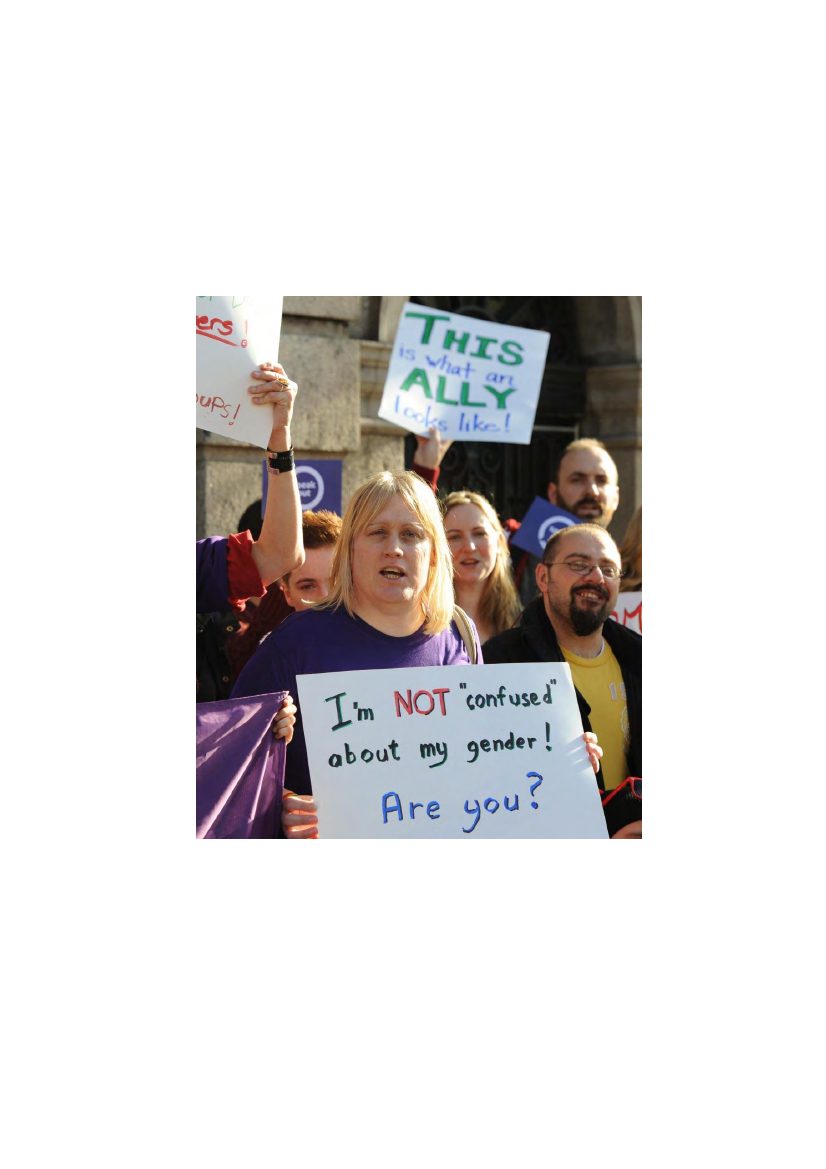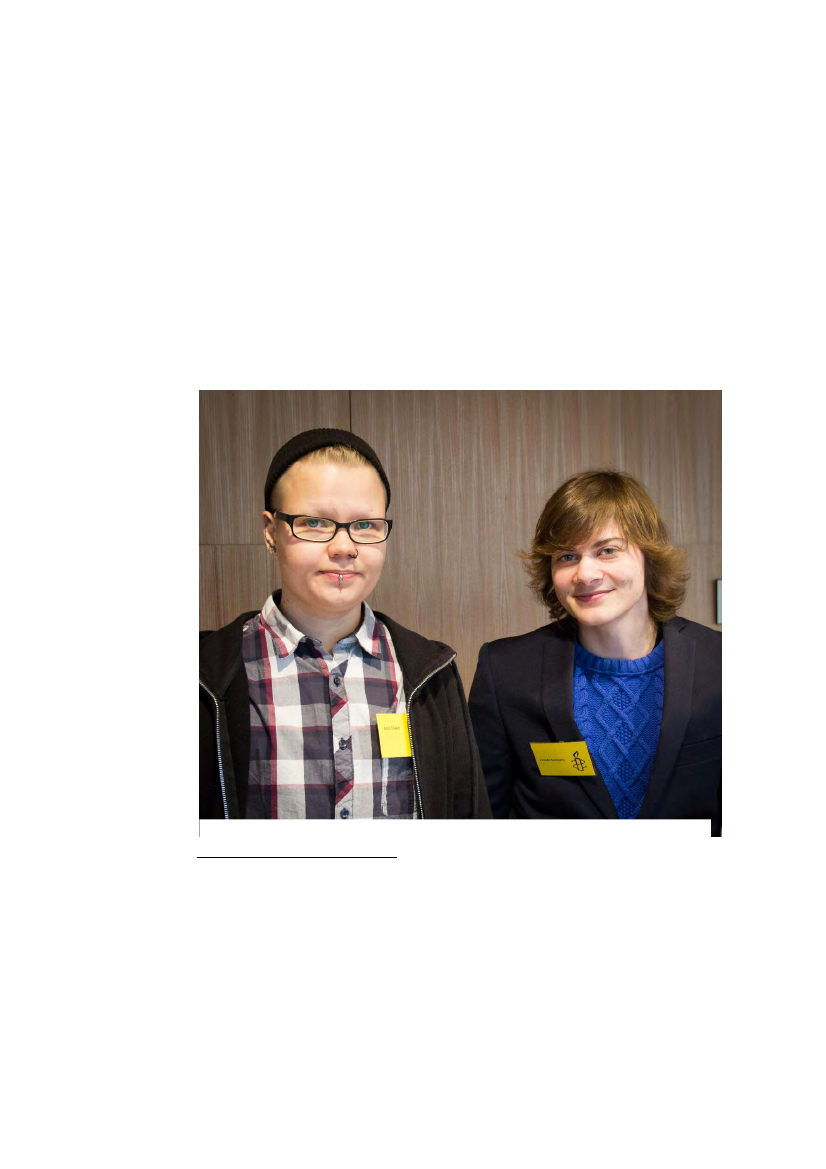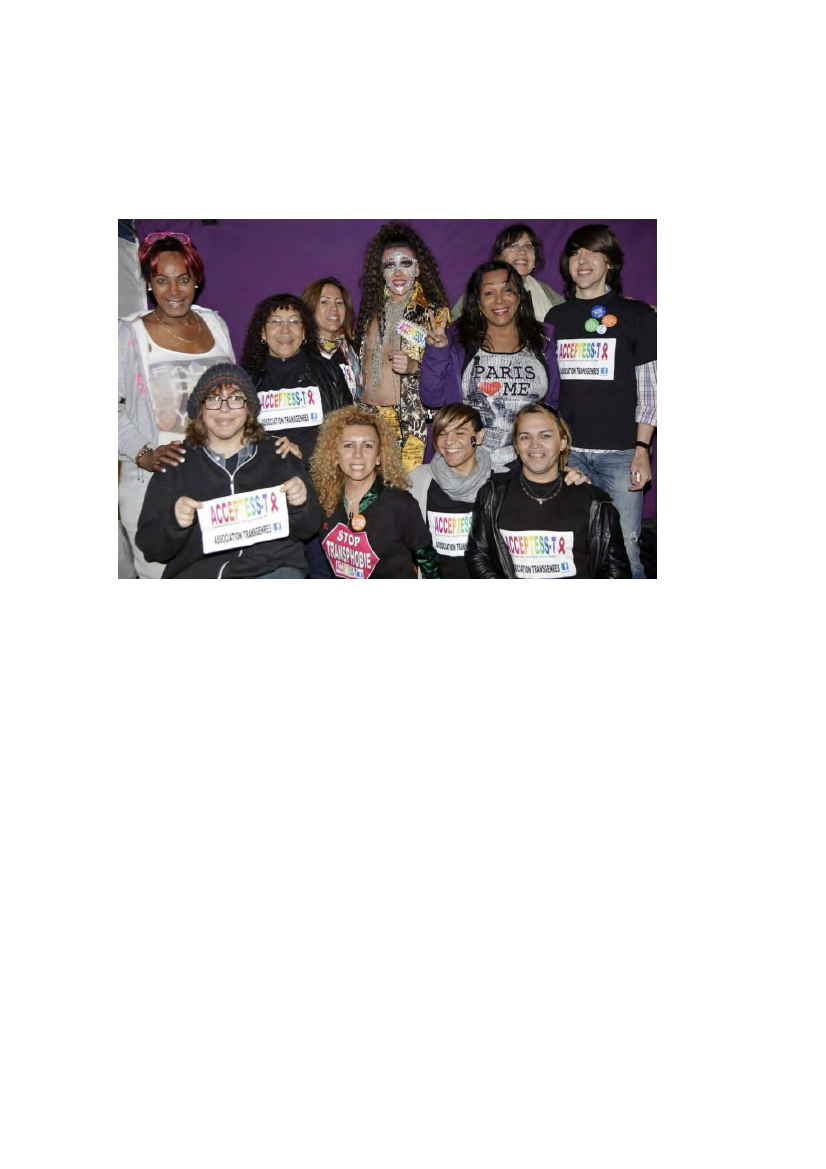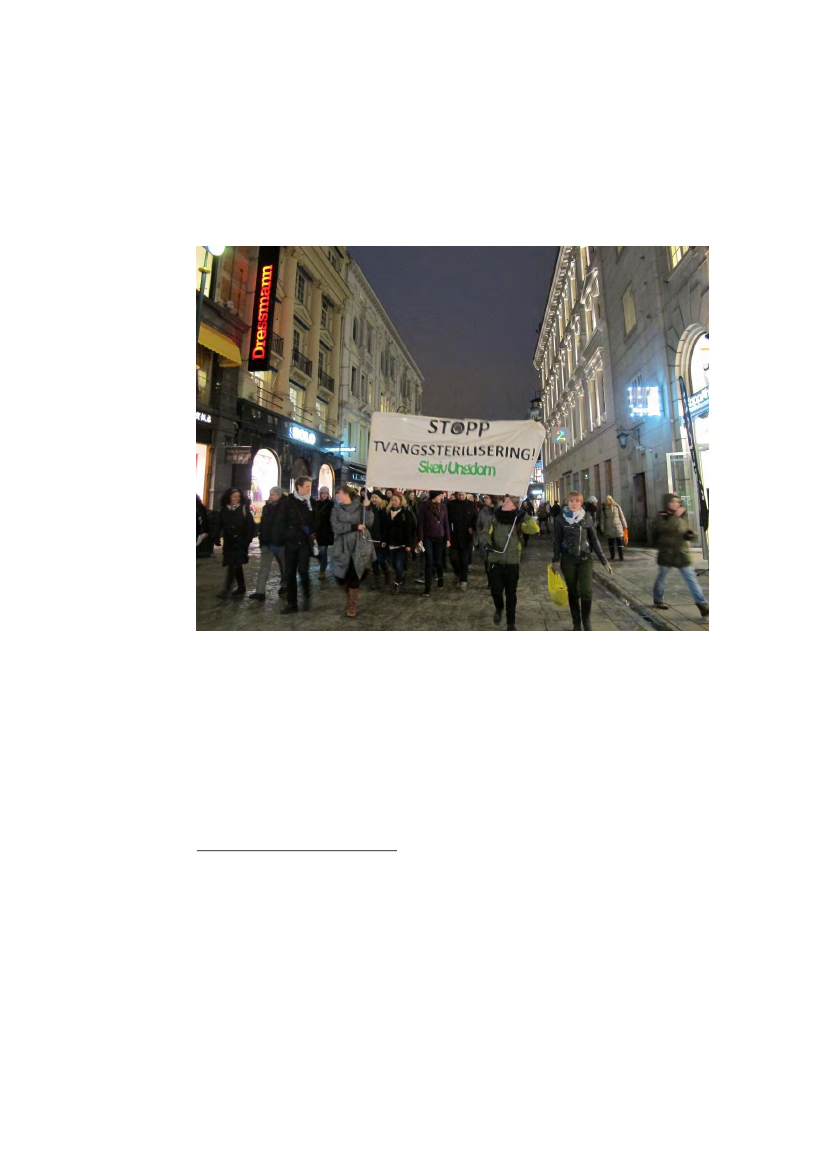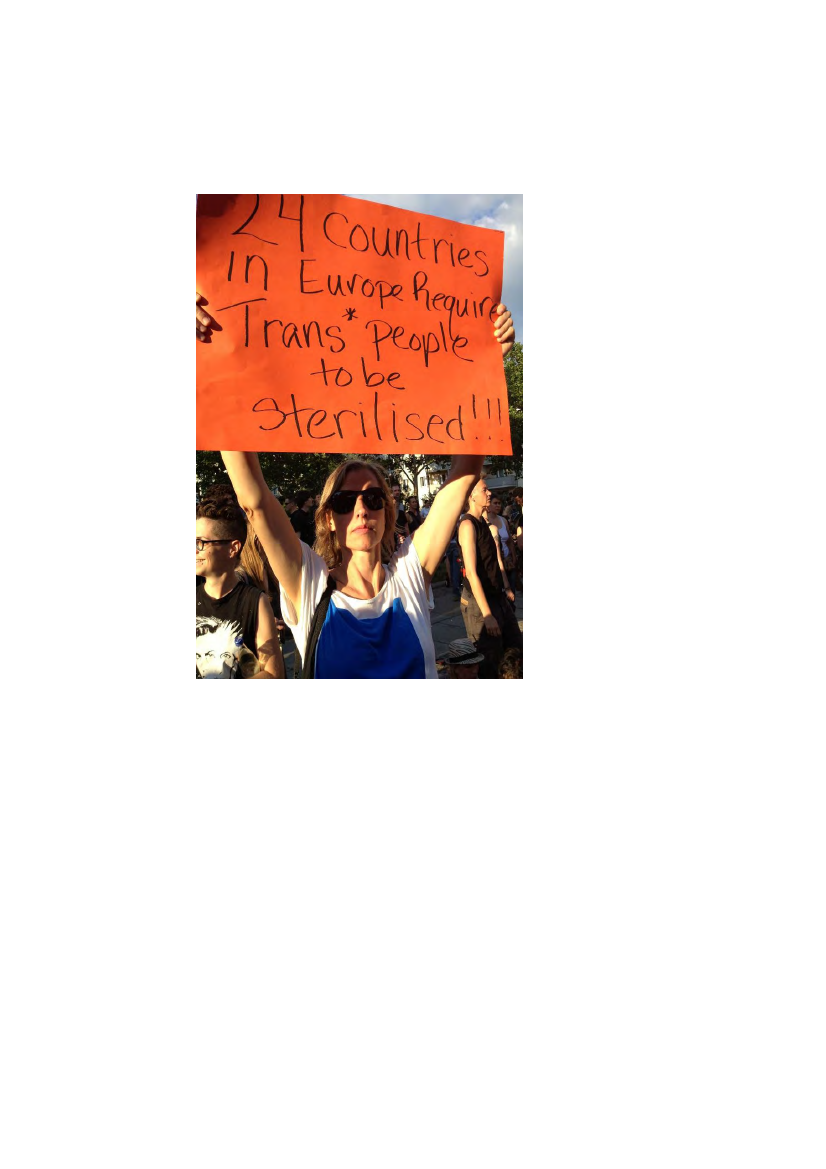Sundheds- og Forebyggelsesudvalget 2013-14
SUU Alm.del Bilag 263
Offentligt
THE STATE DECIDESWHO I AMLACK OF LEGAL GENDER RECOGNITIONFOR TRANSGENDER PEOPLE IN EUROPE
Amnesty International is a global movement of more than 3 million supporters,members and activists in more than 150 countries and territories who campaignto end grave abuses of human rights.Our vision is for every person to enjoy all the rights enshrined in the universaldeclaration of human rights and other international human rights standards.We are independent of any government, political ideology, economic interest orreligion and are funded mainly by our membership and public donations.
First published in 2014 byAmnesty International LtdPeter Benenson House1 Easton StreetLondon WC1X 0DWUnited Kingdom� Amnesty International 2014Index: EUR 01/001/2014 EnglishOriginal language: EnglishPrinted by Amnesty International,International Secretariat, United KingdomAll rights reserved. This publication is copyright, but maybe reproduced by any method without fee for advocacy,campaigning and teaching purposes, but not for resale.The copyright holders request that all such use be registeredwith them for impact assessment purposes. For copying inany other circumstances, or for reuse in other publications,or for translation or adaptation, prior written permission mustbe obtained from the publishers, and a fee may be payable.To request permission, or for any other inquiries, pleasecontact [email protected]Cover photo: The Rally for Recognition was organised by TEA(Trans* Education and Advocacy) at DCU, Dublin, September 2012.� Alison McDonnell
amnesty.org
CONTENTSCONTENTS ..................................................................................................................3INTRODUCTION ...........................................................................................................6A. What are gender identity and expression? .................................................................9B. How many transgender people live in Europe? ........................................................11C. Discrimination against transgender people because of their gender identity ...............11D. Aims and methodology .........................................................................................15E. Terminology ........................................................................................................161. LEGAL GENDER RECOGNITION AND HUMAN RIGHTS ..............................................181.1 The rights to private life and to recognition before the law ......................................201.2 The right to the highest attainable standard of health and to be free from cruel,inhuman and degrading treatment .............................................................................211.3 The right to marry and to found a family and the right to family life ........................261.4 The best interest of the child ..............................................................................271.5 Intersex people ..................................................................................................282. LEGAL GENDER RECOGNITION IN EUROPEAN COUNTRIES .....................................302.1 Denmark ...........................................................................................................302.1.1 Current laws and practices ...........................................................................312.1.2 Medical requirements: the psychiatric diagnosis .............................................322.1.3 Hormone treatments and surgeries ................................................................342.1.4 Sterilization ................................................................................................362.1.5 Consequences of current law and practices ....................................................372.1.6 Opportunities for changing laws and practices ................................................392.2 Finland .............................................................................................................40
2.2.1. Current policies and practices ..................................................................... 402.2.2. Medical requirements: the psychiatric diagnosis ............................................ 412.2.3 Other medical requirements: hormone treatment and sterilization .................... 432.2.4 Other requirements: change in marital status ................................................. 442.2.5 Consequences of current law and practices .................................................... 452.2.6 Opportunities for change.............................................................................. 472.3 France ............................................................................................................. 492.3.1. Case law ................................................................................................... 492.3.2 Current practices and requirements .............................................................. 502.3.3 Consequences of the current practices .......................................................... 532.3.4 Opportunities for changing laws and practices ................................................ 562.4 Ireland ............................................................................................................. 582.4.1. Case law and practices ............................................................................... 582.4.2 Consequences of legislative gaps and current practices ................................... 602.4.3 Opportunities for changing laws and practice ................................................. 642.4.4 The General Scheme of the Gender Recognition Bill 2013 .............................. 652.5. Norway ............................................................................................................ 702.5.1 Current laws and practices ........................................................................... 702.5.2 Medical requirements: the psychiatric diagnosis ............................................. 712.5.3 Other medical requirements: hormone treatment and surgeries ........................ 732.5.4 The sterilization requirement ........................................................................ 752.5.5 Consequences of current practices ................................................................ 762.5.6 Opportunities for changing laws and practices ................................................ 772.6 Other Countries ................................................................................................. 79
2.6.1 Belgium .....................................................................................................792.6.1.1 Current law and practices ..........................................................................792.6.1.2 Consequences of current practices and discrimination ..................................812.6.1.3 Opportunities for changing laws and practices .............................................822.6.2 Germany ........................................................................................................832.6.2.1 Current laws and practices ........................................................................842.6.2.2 Change of name: the minor solution ...........................................................852.6.2.3 Change of legal gender: the major solution ..................................................862.6.2.4 Opportunities for changing laws and practices .............................................893. CONCLUSIONS AND RECOMMENDATIONS ..............................................................90APPENDIX I: HUMAN RIGHTS STANDARDS .................................................................95APPENDIX II: International Classification of Diseases, 10thVersion (ICD-10) ..................100
6
The state decides who I amLack of legal gender recognition for transgender people in Europe
INTRODUCTION“Legal gender recognition is important as it is avalidation of who I am. When you are born you getyour birth certificate and when you die you getyour death certificate. People take that forgranted. It follows you all through life. Nobodythinks about it. But if I go into a social welfareoffice and someone wants to make my life difficult[because I don’t have documents reflecting mygender identity], I have no legal rights to relyon… Legal gender recognition also validates youwithin the rest of the population. If you are seento be legally recognized then you have morelegitimacy within the wider community, within thenon-transgender community, and that’simportant.”Louise, a transgender woman living in Dublin, Ireland
For transgender people, official identity documents reflecting their gender identity are vitallyimportant for the enjoyment of their human rights. They are not only crucial when travellingbut also for everyday life; depending on the specific country, individuals may be asked toproduce an official document when they enrol in school, apply for a job, access a publiclibrary or open a bank account.
Amnesty International January 2014
Index: EUR O1/001/2014
The state decides who I amLack of legal gender recognition for transgender people in Europe
7
In 1992, the European Court of Human Rights (ECHR) first recognized that a state’s refusalto allow transgender people to change the gender markers on their official documents was aviolation of the European Convention on Human Rights.1More than 20 years later, however,many transgender people in Europe continue to struggle to have their gender legallyrecognized.Many states made the change in one’s legal gender contingent on the fulfillment of invasiverequirements, which violate the human rights of transgender people, through procedures thatusually take years. In these instances, transgender people can obtain legal gender recognitiononly if they are diagnosed with a mental disorder, agree to undergo medical procedures suchas hormone treatments and surgeries, are single or of age. Some other countries simply donot allow for a change in one’s legal gender.In many countries, even those with a reputation for championing equality and human rightssuch as Belgium, Denmark and Norway, as well as about 20 other countries in Europe2,transgender people have to undergo surgeries to remove their reproductive organs, resultingin irreversible sterilization. If they decide not to undergo such surgeries, they must continueto bear documents indicating the gender on the basis of the sex they were assigned at birth –even if that contradicts their appearance and identity.In fact, transgender people face an invidious situation in which they have to choose somehuman rights at the expense of others. Enjoying all of their human rights is not an optionavailable to them. The choices are stark. Obtain documents reflecting their gender, whichwould ensure their right to private life, or refuse to divorce their partners? Beingacknowledged by the state and enjoying equal recognition before the law, or preserving theirreproductive rights by refusing to undergo sterilization? Forcing such choices on transgenderpeople is contrary to the states’ obligations to ensure that everyone can enjoy human rightswithout discrimination, including on grounds of gender identity and expression.Transgender people should be able to obtain legal gender recognition through quick,accessible and transparent procedures and in accordance with their own perceptions ofgender identity. States must ensure that transgender people can obtain documents reflectingtheir gender identity without being required to satisfy criteria that in themselves violate their
1 European Court of Human Rights, Case of B. v France, no. 13343/87, 1992.2 According to the Transgender Europe’s Trans Rights Map Index published in May 2013, 24 countries in Europe required transgender people to be sterilized in orderto obtain legal recognition of their gender. On 17 December 2013, the Dutch Senate (Eerste Kamer der Staten-Generaal) adopted a bill that had already been adoptedby the House of Representatives (Tweede Kamer der Staten-Generaal). The law proposal amends Article 28 of the Civil Code which, since 1985, allows transgenderpeople to obtain legal gender recognition provided that they have adapted their bodies’ appearance through hormone treatments and surgeries insofar as it was possibleand safe and that they are permanently and irreversibly infertile. The new law will enter into force on 1 July 2014. It provides the possibility for transgender people whoare aged 16 and above to obtain legal gender recognition legal gender recognition by introducing a declaration to the civil registry supported by an expert’s certificate.EK 33. 351, article I/B https://www.eerstekamer.nl/wetsvoorstel/33351_wijziging_vermelding_van, in Dutch, accessed 2 January 2014. In June 2013, Croatia adoptedthe Law on Amendments on the Law on State Registers (No.71 -05-03/1-13-2). According to Article 9A, medical evidence from treating physicians or other healthfacilities is needed for the purposes of legal gender recognition. The Ministry of Health is charged with developing guidelines on the legal gender recognition procedurethat should also specify what medical evidence is needed (Article 36). In January 2014, such guidelines had not been developed yet. According to Article 37, previousguidelines adopted in 2008 remain in force (26/08).
Index: EUR 01/001/24
Amnesty International January 2014
8
The state decides who I amLack of legal gender recognition for transgender people in Europe
human rights. For that purpose, legal gender recognition should not be made contingent onpsychiatric diagnosis, medical treatments, single status or blanket age requirements.
Demonstration for gender legal recognition outside Leinster House in Dublin October, 2012 � Sasko Lazarov /Photocall
Amnesty International January 2014
Index: EUR O1/001/2014
The state decides who I amLack of legal gender recognition for transgender people in Europe
9
A. WHAT ARE GENDER IDENTITY AND EXPRESSION?“It is so difficult to live a life where you feel a constant discrepancy between what you are and how others perceive you.”Hélène,Paris, France
In all societies, gender norms determine what is deemed “appropriate” behavior for men andwomen, which may include dress, speech and mannerisms. These gender norms are nothomogenous across societies; they differ from place to place and across time. But individualswho transgress these boundaries – whose behavior lies outside of the accepted gender norms– often face stigma and discrimination, harassment, and sometimes even violence andmurder.In most countries, individuals have a legal gender that corresponds to the sex they wereassigned at birth. This appears on multiple official documents (including birth certificates,identity cards and passports) and determines how they are perceived throughout their lives.Those whose gender identity differs from the sex they were assigned at birth or those whowish to express their identity in ways that are considered at odds with gender norms mustchoose between suppressing their own sense of self, or publicly transgressing genderboundaries and bearing all the potential negative consequences.People generally do not experience and perceive their gender identities according to onestandardized pattern. Transgender people, whose innate sense of their own gender differsfrom the sex they were assigned at birth, also experience and express their gender identityaccording to a variety of patterns. Their perceptions of gender identity may also evolve overtime. Some transgender people identify themselves as fully male or female; others perceivetheir gender identity in a continuum between the two. According to a survey undertaken inBelgium, only 55 per cent of those transgender people who were assigned the male sex atbirth identified themselves as either fully or mainly female. Similarly, only 60 per cent ofthose transgender people who were assigned the female sex perceived themselves as eitherfully or mainly male. The rest identified as neither male nor female, both male and female, or“other”.3While some transgender people are willing to undergo all available health treatments,including surgeries aimed at modifying their bodies according to their gender identity, othersprefer to access only some procedures, and in some cases, treatments are not sought at all.Throughout the research for this report, Amnesty International spoke to transgender peoplewhose gender identities greatly vary. Joshua was assigned the female sex at birth butperceives himself as a man: “I’veseen myself as a male since I was four. I did not even knowI was born female until my cousin peed in front of me and I could see the difference in ourbodies. My gender identity was firmly established at that point and has not changed overtime.”4
3 Joz Motmans, Being transgender in Belgium. Mapping social and legal situation of transgender people, 2010, p. 100, http://igvm-iefh.belgium.be/fr/binaries/34%20-%20Transgender_ENG_tcm337-99783.pdf, accessed 6 December 2013.4 Interview with Joshua, Copenhagen, 22 October 2013.
Index: EUR 01/001/24
Amnesty International January 2014
10
The state decides who I amLack of legal gender recognition for transgender people in Europe
Bjørk was assigned the male sex at birth:“It’s a bit tricky when it comes to my genderidentity. Intellectually I think a third gender would fit me the best. I don’t think I belong toeither the male or the female gender. It’s the same with my sexual orientation. I considermyself as bisexual. I haven’t been happy with my male body since the age of four. My familywas transphobic and homophobic. I wanted to come out as a trans person but I alwaysthought about the reactions of those who surrounded me.”5N. was assigned the male sex and sees herself as a woman:“I am a woman with a transbackground. I perceive myself as a woman who has a little bit of a different history than otherwomen usually do. When I was a child, I wondered about my anatomy. I felt puzzled. When Iwas with boys, I felt like I was in a foreign country. I learned to speak the language but I feltI was not originally from there. I was 26 when I fully realized that I was transgender.”6Luca was assigned the female sex: “Idon’tperceive myself at either one end or the other ofthe spectrum; I wander somewhere between, oroutside. The society and our culture alwaysplace people in two categories, so one needs tonegotiate [how to position oneself] in differentsituations. I am a masculine trans. The way Iperceived my gender identity has always beenthe same but the way I describe it has changedover time.”7Runar Randi Beate is a man who often wearsfemale clothes and makeup. “I’maheterosexual man, and I’m quite pleased withthat. The feminine side is a part of me and ithas to get out in order for me to feel I am acomplete human being. I have to live out thatpart as well, to a greater or lesser extent. Itcomes and goes. It depends. The dressing styleon the other hand has changed; it is now morefashion-oriented and classy”.8Randi Beate from Norway, a man who sometimes needs toexpress his feminine side � Amnesty International
5 Interview with Bjørk, Copenhagen, 23 October 2013.6 Interview with N, Helsinki, 16 July 2013.7 Interview with Luca, Helsinki, 5 July 2013.8 Interview with Runar, Oslo, 23 June 2013.
Amnesty International January 2014
Index: EUR O1/001/2014
The state decides who I amLack of legal gender recognition for transgender people in Europe
11
Hélène was assigned the male sex at birth: “Iam a transsexual. I know that it may makepeople uncomfortable and that there are not many people who define themselves astranssexuals. I want to undergo genital reassignment surgery, which is important for me inorder to live as a woman. I couldn’t do that with male genital organs. I have felt I am afemale since the age of four or five but it took me many years to come out… I was 48.”9
B. HOW MANY TRANSGENDER PEOPLE LIVE IN EUROPE?The exact number of transgender people living in Europe is unknown. Social scientists havedeveloped various estimates on the prevalence of transgender people in the generalpopulation that stir lively debates, especially because they reach very divergent conclusions.In the past, estimations were primarily based on the number of people who had undergonegenital reassignment surgeries or were undergoing hormone treatment, using data sourcedfrom health professionals. Other estimations were based on the number of people whoobtained legal gender recognition. According to some of these estimates, there may bearound 30,000 transgender people in the European Union.10However, those estimates fail to take into account all transgender people who do not undergoreassignment surgeries or other health treatments. More recent estimates have been basednot only on health related data but also, in some instances, on gender identity relatedquestions undertaken in the context of survey research. Such surveys suggest there could beas many as 1.5 million people in the EU who do not fully identify with the sex they wereassigned at birth.11
C. DISCRIMINATION AGAINST TRANSGENDER PEOPLE BECAUSE OF THEIR GENDERIDENTITYWhether at school or in the workplace, transgender people are often discriminated against
9 Interview with Hélène (pseudonym), Paris, 28 June 2013.10 According to Eurostat, there were 505 million people living in the EU’s 28 member states as of 1 January 2013. There were 104,8 women per 100 men. Severalstudies on the prevalence of transsexualism have been carried out since the 1960s. Such studies however only refer to transsexual people, who constitute just a portionof transsexuals people. According to these estimations, the highest prevalence is 1:11.900 for male-to-female transsexuals and 1:30.400 for female-to-maletransgender. For a review of these estimations, see Femke Olyslager and Lynn Conway, “On the calculation of the prevalence of transsexualism”, 2007,http://ai.eecs.umich.edu/people/conway/TS/Prevalence/Reports/Prevalence%20of%20Transsexualism.pdf, accessed 9 December 2013. These are also the highestestimates indicated by the World Professional Association for Transgender Health (WPATH) in Standards of care for the health of transsexual, transgender, and gendernon-conforming people, Version 7, p7, http://www.wpath.org/uploaded_files/140/files/Standards%20of%20Care,%20V7%20Full%20Book.pdf11 Gates indicated in 2011 that 0.3 per cent (1:333) of the US adult population may identify as transgender. If applied to an EU population of about 505 million, thatprevalence rate means that there may be approximately 1.5 million transgender people in the EU. Gary J. Gates, How many people are Lesbian, Gay, Bisexual andTransgender? 2011, http://williamsinstitute.law.ucla.edu/wp-content/uploads/Gates-How-Many-People-LGBT-Apr-2011.pdf;Reed indicated that the prevalence of transgender people who seek health treatments might be 0.02 per cent (20:100,000) in the UK. However, 0.6 per cent(600:100,000) of the population may experience some gender variance irrespective of whether health treatment is sought or not. Reed et al., Gender variance in theUK: prevalence, incidence, growth and geographical distribution, 2009, http://www.gires.org.uk/assets/Medpro-Assets/GenderVarianceUK-report.pdf;Femke Olyslager and Lynn Conway, On the calculation of the prevalence of transsexualism, 2007, indicated that the lower bound prevalence is 0.2 per cent (1:500) orhigher, http://ai.eecs.umich.edu/people/conway/TS/Prevalence/Reports/Prevalence%20of%20Transsexualism.pdf (all sources accessed on 5 December 2013).
Index: EUR 01/001/24
Amnesty International January 2014
12
The state decides who I amLack of legal gender recognition for transgender people in Europe
because of widespread prejudices and gender-based stereotypes stemming from standardizednotions of masculinity and femininity.Such discrimination occurs irrespective of whether or not transgender people bear documentsthat reflect their gender identity. However, the lack of such documents can further exposetransgender people to discrimination whenever they have to produce a document with gendermarkers that do not correspond to their gender identity and expression. Such involuntary“outings” are a major concern in countries where transgender people cannot access legalgender recognition or where burdensome and lengthy procedures make it difficult to do so.In a European Union Agency for Fundamental Rights (FRA) survey of lesbian, gay, bisexualand transgender people in Europe (hereafter referred to as FRA LGBT survey), 29 per cent ofthe transgender respondents said they had been discriminated against in the workplace orwhile looking for jobs in the year ahead of the survey.12Thirty-five per cent of them said theyhad experienced violence or the threat of violence during the five years ahead of the survey.Fifty per cent of those who had experienced violence or the threat of violence in the 12months ahead of the survey, perceived they had been victimized because of their genderidentity.13In recent years, dozens of transgender people have been killed in Europe – at least84 since January 2008, with the highest numbers in Turkey (34) and Italy (26).14Although few states in Europe collect disaggregated data on hate crime perpetrated ongrounds of gender identity, existing statistics raise concern. For example, more than 300hate crimes were perpetrated against transgender people in England and Wales in the UnitedKingdom in less than a year between 2011 and 2012.15In some instances, publicauthorities, including the police, harass transgender people. For example, in 2012 dozens oftransgender women in Greece were arrested and forced to undergo HIV tests. The arrests weremade on the basis of a regulation that had been introduced in May of that year, thensuspended in June 2013 and subsequently reintroduced in July.
12 European Union Agency for Fundamental Rights, European Union lesbian, gay, bisexual and transgender survey, results at a glance, 2013, pp. 21-22,http://fra.europa.eu/sites/default/files/eu-lgbt-survey-results-at-a-glance_en.pdf, accessed 5 December 2013.13 European Union Agency for Fundamental Rights, European Union lesbian, gay, bisexual and transgender survey, results at a glance, 2013, pp. 21-22,http://fra.europa.eu/sites/default/files/eu-lgbt-survey-results-at-a-glance_en.pdf, accessed 5 December 2013.14 Trans-Murder Monitoring Project, Transgender Europe, last data update 21 November 2013http://www.transrespect-transphobia.org/en_US/tvt-project/tmm-results.htm/tdor-2013, accessed 5 December 2013.15 The police recorded more than 43,000 hate crimes between April 2011 and March 2012. Hate crimes against transgender people include any criminal offence thatis perceived, by the victim or any other person, to be motivated by a hostility or prejudice against a person who is transgender, or perceived to be transgender,https://www.gov.uk/government/publications/hate-crimes-england-and-wales-2011-to-2012--2/hate-crimes-england-and-wales-2011-to-2012, accessed 5 December2013. For individual cases of transphobic hate crimes and information on legislative gaps in Europe, see Because of who I am: homophobia, transphobia and hatecrimes in Europe (Index: EUR 01/014/2013).
Amnesty International January 2014
Index: EUR O1/001/2014
The state decides who I amLack of legal gender recognition for transgender people in Europe
13
In May 2013, the police in the city of Thessaloniki arbitrarily stopped a number oftransgender women for identity checks and then arrested them for several hours.16
ANNA: DISCRIMINATED AGAINST AT SCHOOLAnna, a 26 year old transgender woman interviewed by Amnesty International, experienced discrimination andviolence in an evening school for secondary education in Athens, Greece. School authorities refused herpermission to express her gender identity. She told Amnesty International: “I went to the headmaster’s office inorder to enrol and he asked me if I was there to enrol my brother. I answered no and I told him my name wasAnna. His colleague interrupted us and told him my name was Panagiotis [Anna’s legal male name]. Theheadmaster told me that he had been informed about my situation and that he wouldn’t accept any gay ortrans in his school. He said I had to cut my hair, stop wearing make-up, wear men’s clothes and generally actas a male. He tried to alter my identity and suppress my rights… I was frightened and I accepted thoseconditions for a month… the worst month of my life. Other pupils made fun of me but when I told theheadmaster they were behaving like that because I was a trans person he replied that I was not trans becauseI hadn’t changed my gender. He said I was a gay man who wanted to show off in female clothes.”17Anna waseventually allowed to wear clothes that expressed her gender identity. Nevertheless, other pupils continued toharass and threatened her with violence and she felt school authorities did not take effective action to put anend to the situation.18In June 2012, Anna was victim of a serious attack when a pupil and his friend pouredgasoline on her and attempted to set her on fire just outside the school premises. Amnesty International wasalso informed by Anna’s lawyer that while a police car arrived at the scene of the incident, the attack was notsubsequently investigated.19Despite the intervention of the Greek Ombudsperson, Anna continued to face hostile and transphobicbehaviour by the school administration after she registered to the upper secondary school in September 2013.Anna also reported being subjected to verbal abuse and harassment by other pupils because of her genderidentity. In January 2014 Anna told Amnesty International that she felt forced to leave school because of theharassment she had experienced.
16 Greece must withdraw the provision on forced HIV testing and end harassment against transgender women, (Index; EUR 25/012/2013),http://www.amnesty.org/en/library/asset/EUR25/012/2013/en/2d74d0f9-f321-4b55-a55f-44346ed3780c/eur250122013en.pdf17 Interview with Anna, 28 March 2013.18 In a letter to the Minister of Education and Religious Affairs dated 5 April 2013, Amnesty International raised concerns about the discrimination Anna experiencedat school. The letter sought further information on the measures taken by school authorities and other educational competent authorities to protect Anna from threats ofviolence and put an end to the discrimination she was experiencing. The Ministry replied on 10 July 2013 stating that the competent authority dealing with the officialcomplaint Anna filed against the headmaster concluded that he handled a complicated situation in the best way possible.19 Interview with Elektra Koutra, Anna’s lawyer, 15 January 2014.
Index: EUR 01/001/24
Amnesty International January 2014
14
The state decides who I amLack of legal gender recognition for transgender people in Europe
L. CAVALIERO: SEXUALLY HARASSED BY HIS UNIVERSITYPROFESSORL. Cavaliero is legally a female but he identifies more as a male. He has a gender queer appearance and he isnot undergoing any health treatment to physically transition to the male gender. He was harassed andassaulted by a university professor in Berlin. He told Amnesty International: “WhenI started his course, Ipresented myself as a trans person to everyone and I said I preferred the masculine pronoun. Sometimes hemade fun of me, for example by referring to me as ‘this woman who wants to be a man’. At some point theother students started reacting because they were shocked by his behaviour, but he didn’t stop. I went to hisoffice to discuss the topic for the exam. He referred to me with the female pronoun, so once again I said Ipreferred the masculine one. He told me I was the first trans person he had ever met and that he had a lot ofquestions… At some point he asked me if I had male or female genitals… and he tried to grab in between mylegs. I told him he was not allowed to do that… He came towards me and then he started touching me. I wasagainst the wall. I screamed and then ran away.”20
LOUISE: DISCRIMINATED AGAINST IN THE WORKPLACELouise is a transgender woman living in Dublin, who used to work in the transport industry. In late 2006, sheinformed her employer that she intended to start her physical transition to her female gender. She was readyto resign as she thought that her transition would be problematic in that particular working environment.However, her managers appeared to be supportive and encouraged her to stay. Having decided to stay, sheaccessed hormone therapy, changed her legal name in March 2007 and started working as “Louise”. Problemsarose almost immediately. At the end of March, her managers told her she had to “go back to the male mode”for client meetings and she was banned from using the female toilets. Louise did not accept this position. “Istruggled to get to this point and I’m not moving back”she told Amnesty International. Her manager startedouting her in public; for example, he referred to her by her previous male name in front of clients. In early April,the manager said that the company had bought new premises and asked Louise to work from home for amonth because, as he put it, “there is an atmosphere in the office”. Louise worked from home from 24 April tothe end of July. She repeatedly asked to return to the office but was told there was no room. However, Louiseknew her desk was free up until the beginning of July. In the middle of July, the manager told her she was notproductive enough and suggested she looked for another job. She found another job in July 2007 but it fellthrough after a couple of weeks.21
20 Interview with L. Cavaliero, Berlin, 7 November 2012.21 Louise took her case to the Equality Tribunal, the body responsible for dealing with cases of discrimination. The Tribunal found that she was discriminated againston grounds of gender and disability, and that the request made by the employer to work from home was discriminatory. In July 2007, Louise asked to be reinstated inher previous job but her employer offered another position with unsociable hours and low pay instead, which she refused. The Equality Tribunal considered thistreatment as discriminatory. See Decision No. DEC-S2011-066, Hannon v First Direct Logistics Limited, 29 March 2011.
Amnesty International January 2014
Index: EUR O1/001/2014
The state decides who I amLack of legal gender recognition for transgender people in Europe
15
D. AIMS AND METHODOLOGYThis report illustrates the human rights violations experienced by transgender peoplestemming from the requirements imposed on them to obtain legal recognition of their gender.In highlighting these requirements, including psychiatric diagnosis, medical procedures anddivorce, it underscores the plight of transgender people forced to choose which rights to giveup in order to enjoy others. The report shows the consequences of the current lengthy legalgender recognition procedures on the rights of transgender people, in particular the rights torecognition before the law, privacy and health, and to be free from discrimination and frominhuman and degrading treatment. This report does not focus specifically on the humanrights violations experienced by intersex people (see 1.5).Chapter 1introduces some common problematic aspects of procedures on legal genderrecognition in Europe and the human rights violations they entail. A summary of theapplicable international standards is included in Appendix I.Chapter 2provides an overview of existing legal gender recognition procedures in sevenEuropean countries: Belgium, Denmark, Finland, France, Germany, Ireland and Norway. Itincludes also succinct information on the current civil and criminal laws protecting againstdiscrimination and hate crimes on grounds of gender identity. Individual case studiesillustrate the impact of the current legal gender recognition procedures on the lives oftransgender people in Denmark, Finland, France, Ireland and Norway.Chapter 3draws conclusions and identifies both general and country specificrecommendations.The countries covered in this report were identified on the basis of two main criteria: a) thepresence of compulsory requirements for legal gender recognition that violate the humanrights of transgender people; and, b) the presence of opportunities for amending currentlaws, policies and practices, and a context to which Amnesty International could bring anadded value to achieving such change.The information included in this report was collected by desk research undertaken fromAugust 2012 to December 2013, and from research undertaken by Amnesty Internationalsections in Belgium, Denmark, Finland and Norway and a number of field-research missions.These include short 3-day missions to Finland (November 2012) and Germany (November2012), and longer 6-day missions to Norway (June 2013), France (July 2013) and Ireland(October 2013). Information was also collected in the context of Amnesty International’sparticipation in international conferences and seminars and in the framework of AmnestyInternational’s ongoing work on homophobic and transphobic hate crimes. In-depth researchwas undertaken in Denmark, Finland, France, Ireland and Norway, where individual casestudies have been researched and meetings held and contacts maintained with authorities.Research undertaken in Belgium and Germany was more limited in scope and aimedprimarily at reviewing the main laws and practices applicable to legal gender recognition.In the context of the research for this report Amnesty International interviewed about 70transgender individuals, 15 health and legal experts and representatives of more than 25transgender organizations in the countries covered. Interviews with transgender individuals
Index: EUR 01/001/24
Amnesty International January 2014
16
The state decides who I amLack of legal gender recognition for transgender people in Europe
were undertaken in English, Danish, Finnish, French and Norwegian, without interpretation.Most of them were transcribed and translated into English when applicable. The quotes fromthe interviews reported here were lightly edited for brevity and clarity only. Interviewees areidentified in accordance with their informed consent, sought by Amnesty Internationalresearchers in each interview. In referring to interviewees the report always uses theirpreferred description of their gender identity and their preferred pronoun.Amnesty International acknowledges the crucial support of Transgender Europe and theEuropean region of the International Lesbian, Gay, Bisexual, Trans and Intersex Association(ILGA-Europe) in the context of this research.
E. TERMINOLOGYCisgenderpeople are individuals whose gender expression and/or gender identity accords withconventional expectations based on the physical sex they were assigned at birth. In broadterms, “cisgender” is the opposite of “transgender”.Gender Identityis a very personal and subjective matter. It refers to each person’s deeply feltinternal and individual experience of gender, which may or may not correspond with the sexassigned at birth, including the personal sense of the body (which may involve, if freelychosen, modification of bodily appearance or function by medical, surgical or other means)and other expressions of gender, including dress, speech and mannerism.Gender expressionrefers to the means by which individuals express their gender identity.This may or may not include dress, make-up, speech, mannerisms and surgical or hormonaltreatment.Gender markeris a gendered designator that appears on an official document such as apassport or an identity card. It may be an explicit designation such as “male” or “female”, agendered title such like Mr or Ms, a professional title, a gendered pronoun, or a numericalcode which uses particular numbers for men and for women (for example, odd numbers andeven numbers).Gender queerrefers to gender identities other than “man” and “woman”, falling thus outsideof the gender binary.Gender reassignment treatmentrefers to a range of medical or non-medical treatments that atransgender person may wish to undergo. Treatments may include hormone therapy, sex orgender reassignment surgery including facial surgery, chest surgery, genital or gonad surgery,and can include sterilization. In some states, certain forms of gender reassignment treatmentmay be compulsory for legal gender recognition. Not all transgender people feel a need toundergo gender reassignment treatment.Genital reassignment surgeriesrefer to operations aimed at modifying genital characteristicsto accord with a person’s gender identity. In some countries these surgeries result inirreversible sterilization as they entail the removal of reproductive organs.
Amnesty International January 2014
Index: EUR O1/001/2014
The state decides who I amLack of legal gender recognition for transgender people in Europe
17
Intersexindividuals possess genital, chromosomal or hormonal characteristics that do notcorrespond to the given standard for the “male” or “female” categories of the sexual orreproductive anatomy. Intersexuality may take different forms and cover a wide range ofconditions.Sexual Orientationrefers to each person’s capacity for profound emotional, affectionate andsexual attraction to, and intimate and sexual relations with, individuals of a different genderor the same gender or more than one gender.Transgender,ortrans,people are individuals whose gender expression and/or gender identitydiffers from conventional expectations based on the physical sex they were assigned at birth.A transgender woman is a woman who was assigned the “male’ sex at birth but has a femalegender identity; a transgender man is a man who was assigned the “female” sex at birth buthas a male gender identity. Not all transgender individuals identify as male or female;“transgender” is a term that includes members of third genders, as well as individuals whoidentify as more than one gender or no gender at all. Transgender individuals may or may notchoose to undergo some, or all, possible forms of gender reassignment treatment.Transsexualindividuals have a gender expression and/or gender identity that differs fromconventional expectations based on the physical sex they were assigned at birth and whowish to undergo, are in the process of undergoing or have undergone, gender reassignmenttreatment. Transsexualism is included in the WHO International Statistical Classification ofDiseases and Related Health Problems (ICD-10thversion) as a mental and behaviouraldisorder (See Appendix II).Transvestite (cross-dresser)describes a person who regularly, but not constantly, wearsclothes mostly associated with a gender other than the gender they were assigned at birth.
Index: EUR 01/001/24
Amnesty International January 2014
18
The state decides who I amLack of legal gender recognition for transgender people in Europe
1. LEGAL GENDER RECOGNITION ANDHUMAN RIGHTS“Legal gender recognition is important because,once and for all, I wouldn’t have to battle withpeople [for anything] I have a right [to], like socialwelfare. Having a legal gender recognitioncertificate would make these issues easier,instead of fighting every corner, which is what I’vehad to do. I want to be recognised as who I bloodywell am. It’s ridiculous that the state doesn’trecognize me as who I am.”Victoria, a transgender woman living in Dublin
Internationally protected human rights are applicable to gender identity as acknowledged bythe Yogyakarta Principles, which crystallize the current status of human rights law in relationto gender identity and sexual orientation. Developed in 2006 by lawyers, scholars, NGOactivists and other experts, these Principles have been referred to by several international andregional organizations, governments and other authorities in the context of human rightstreaties’ monitoring activities or when developing policies on equality and non-discrimination.22
22 Yogyakarta Principles on the application of international human rights law in relation to sexual orientation and gender identity.http://www.yogyakartaprinciples.org/principles_en.htm (accessed 15 January 2014). For examples of the impact of the Principles and the references made to them byinternational organizations and governments, see: Ettelbrick,P.L., Trabucco Zerán, A., The impact of the Yogyakarta Principles on International Human Rights LawDevelopments, 2010, http://www.ypinaction.org/files/02/57/Yogyakarta_Principles_Impact_Tracking_Report.pdf, accessed 15 January 2014
Amnesty International January 2014
Index: EUR O1/001/2014
The state decides who I amLack of legal gender recognition for transgender people in Europe
19
“All human beings are born free and equal in dignity and rights. Human beings of all sexualorientations and gender identities are entitled to the full enjoyment of all human rights.”Principle 1, Yogyakarta PrinciplesCentral to the respect for the human rights of transgender people is the recognition of genderidentity as a prohibited ground of discrimination. This is highlighted by the United NationsCommittee on Economic, Social and Cultural Rights (CESCR): “Gender identity is recognizedas among the prohibited grounds of discrimination; for example, persons who aretransgender, transsexual or intersex often face serious human rights violations, such asharassment in schools or in the workplace.”23The United Nations Committee on theElimination of Discrimination against Women has stated: “The discrimination of womenbased on sex and gender is inextricably linked with other factors that affect women, such asrace, ethnicity, religion or belief, health, status, age, class, caste and sexual orientation andgender identity.”24Gender expression should equally be considered as a protected ground,included in open-ended lists of grounds of discrimination in human rights treaties such asthe International Covenant on Civil and Political Rights (ICCPR, Articles 2 and 26) or theEuropean Convention for the Protection of Human Rights and Fundamental Freedoms (ECHR,Article 14).States can pursue legitimate aims by collecting, recording and keeping demographicinformation on the population, provided they put in place safeguards to ensure confidentialityand respect for the right to privacy. This can and often does include collecting information ongender. Recording information on gender is for example important for public health purposesor for designing, implementing and evaluating policies for combating discrimination ongrounds of gender and gender-based violence.Consequently, many forms of official documents issued to individuals, such as passports, IDcards and driving licences, include a gender marker. This may be explicit, such as a fieldlabelled “sex” marked with an M or F signifying “male” or “female” respectively,25orimplicit, like a unique identifying number that includes an even digit for “male” and an odddigit for “female”.Transgender people who have not been issued official documents reflecting their genderidentity have to constantly disclose information on their gender identity, even when theyprefer it to remain confidential. As a result they may be questioned about their identities andare at risk of being suspected of fraud, harassed, discriminated against or even physicallyattacked.
23 UN CESCR, General Comment No. 20: Non-discrimination in Economic, Social and Cultural Rights, 2009, para32.24 UN CEDAW, General Recommendation No. 28: The Core Obligations of States Parties under Article 2 of the Convention on the Elimination of All Forms ofDiscrimination against Women (CEDAW), 2010, para18.25 There are countries that sometimes issue documents with other markers. For example, Australia, Denmark and New Zealand issue passports with an X gender markerand India issues passports with an E, while Nepal issues ID cards with gender markers for “male”, “female” and “other”.
Index: EUR 01/001/24
Amnesty International January 2014
20
The state decides who I amLack of legal gender recognition for transgender people in Europe
States must ensure that transgender people can obtain legal recognition of their gender –including issuing all documents with correct gender markers and changing the gender-relatedinformation kept in state-run registries – through a quick, accessible and transparentprocedure in accordance with the individual’s own sense of their gender identity, whilepreserving their right to privacy.
OFFICIAL DOCUMENTS, DISCRIMINATION AND EU LAWAs shown by the many cases included in this report, transgender people who do not have documents reflectingtheir gender identity and expression can be discriminated against in areas such as employment, educationand access to goods and services. Procedures aimed at allowing transgender people to obtain legalrecognition of their gender are therefore essential to ensure that they are not discriminated against.EU anti-discrimination law does not explicitly prohibit discrimination on grounds of gender identity andexpression. However, the Charter of Fundamental Rights of the European Union prohibits discrimination on anopen-ended list of grounds (Article 21). Gender identity and expression are not protected grounds in EUDirectives aimed at combating discrimination on grounds of sex, including Directive 2004/113/EC of 13December 2004 implementing the principle of equal treatment between women and men in the access to andsupply of goods and services and Directive 2006/54/EC of the European Parliament and of the Council of 5 July2006 on the implementation of the principle of equal opportunities and equal treatment of men and women inmatters of employment and occupation. However, the European Court of Justice found in several cases (seeAppendix I) that that discrimination against people who intend to undergo, are undergoing or have undergone“gender reassignment” may amount to sex discrimination. Such protection is narrower than what would beprovided on grounds of gender identity. Gender identity cannot in fact be construed as referring exclusively to“gender reassignment” and protection under EU law should be extended to cover the full range of genderidentity and expression.
1.1 THE RIGHTS TO PRIVATE LIFE AND TO RECOGNITION BEFORE THE LAWTransgender individuals whose official documents do not reflect their gender identity, nameor gender expression must disclose they are transgender every time they produce thesedocuments. In many countries, this is almost a daily occurrence. In situations where officialdocuments are required to obtain goods or services – for example, in finding employment,enrolling in education, obtaining housing, or claiming welfare benefits – transgenderindividuals are forced to give up aspects of their right to private life in order to obtain them.A 20-year-old transgender man in Finland said:“I still have a female name and identitynumber, and I have had problems with my ID. For instance, almost every time I try to collecta parcel from the post office, they question whether the passport is mine. Also, the travelcard has my identity number on it and when I try to get on a bus, the driver often claims it isnot my card as it says female.”26
26 This person expressed the wish to remain anonymous.
Amnesty International January 2014
Index: EUR O1/001/2014
The state decides who I amLack of legal gender recognition for transgender people in Europe
21
It is vital that states allow transgender people to change their gender markers and their nameon all documents, in order to protect their right to private life. Those states that have not putin place a procedure to ensure legal gender recognition of transgender people, includingIreland, or those where legislative gaps make it impossible for transgender people to obtaindocuments reflecting their gender identity, including Lithuania,27violate their right to privatelife. This right is protected by international and regional human rights standards includingthe International Covenant on Civil and Political Rights (ICCPR, Article 17) and the EuropeanConvention for the Protection of Human Rights and Fundamental Freedoms (ECHR, Article8). The European Court of Human Rights has found states to be in breach of Article 8 of theECHR in several instances where transgender individuals were not allowed to obtain legalrecognition of their gender.The impossibility to obtain documents that reflect gender identity and expression may alsoconstitute a violation of the transgender individuals’ right to recognition before the law, whichis protected under international human rights law, including by the ICCPR (Article 16) andthe Convention on the Elimination of all Forms of Discrimination against Women (CEDAW,Article 15).28The rights to private life and to recognition before the law may also be violated by stateswhere procedures on legal gender recognition exist but are overly lengthy and/or containmandatory criteria to be fulfilled that in effect exclude some groups of transgender people.Such exclusion could occur, for example, when the procedures require medical treatments,including surgeries, that some transgender people cannot undergo because of health relatedproblems, and where access to these procedures is contingent on the individual receiving aspecific psychiatric diagnosis.
1.2 THE RIGHT TO THE HIGHEST ATTAINABLE STANDARD OF HEALTH AND TO BEFREE FROM CRUEL, INHUMAN AND DEGRADING TREATMENTIn recent years, some positive changes have occurred in a few European countries includingthe Netherlands, Portugal, Spain and Sweden. Legislative reforms enacted in these countrieshave abolished some of the problematic requirements imposed on transgender individuals to
27 In Lithuania, Article 2.27, para1 of the Civil Code adopted in 2001, provides that an unmarried adult of full age has the right to “change the designation of sex” if itis medically possible. Article 2.27, para .2, states that the conditions and the procedure for “changing the designation of sex”, shall be prescribed by law. As such alaw was never adopted, transgender people in Lithuania cannot obtain legal recognition of their gender. Civil Code available in English here:http://www3.lrs.lt/pls/inter3/dokpaieska.showdoc_l?p_id=245495, accessed 2 January 2013. In 2007, the European Court of Human Rights found in L. v Lithuaniathat this gap amounted to a violation of the applicant’s right to private and family life (Article 8). The applicant, a transgender man, had undergone some genderreassignment surgeries but could not undergo genital reassignment surgery, as it was not available in Lithuania. As a result, the applicant could not change his personalcode, mentioned on his birth certificate and passport, which indicated that he was legally a female (the code started with the digit 4 for female; males are assigned thedigit 3).28 Yogyakarta Principles on the applications of human rights Law in relation to sexual orientation and gender identity, Principle 3. The Human Rights Committee,tasked to monitor the implementation of the ICCPR, found in several instances that the state’s failure to issue birth certificates or to keep civil registries amounted to aviolation of Article 16 and led to the violation of other rights included access to social services or education. See for example: Concluding Observations on Albania,CCPR/CO/82/ALB (HRC, 2004), para. 17, Concluding Observations on Bosnia and Herzegovina, CCPR/C/BIH/CO/1 (HRC, 2006), para. 2, Concluding Observations onthe Democratic Republic of Congo, CCPR/C/COD/CO/3 (HRC, 2006), para 25.
Index: EUR 01/001/24
Amnesty International January 2014
22
The state decides who I amLack of legal gender recognition for transgender people in Europe
obtain legal gender recognition, including sterilization.29Moreover, in 2011, the GermanConstitutional Court found that the irreversible surgery and the sterilization requirementsforeseen by domestic legislation on legal gender recognition were unconstitutional.30In 2009the Austrian Constitutional Court found that genital surgeries should not have been aprerequisite to allow transgender people to change their names.31However, legal gender recognition procedures in the majority of European countries requirethe individual to fulfil a strict set of criteria. In many cases, these requirements violate thehuman rights of transgender individuals, including the rights to the highest attainablestandard of health and to be free from cruel, inhuman or degrading treatment. Transgenderindividuals are thus forced to choose between these rights and the rights to private life andrecognition before the law outlined above.In many countries, transgender individuals cannot obtain legal gender recognition unless theyundergo psychiatric assessment and receive apsychiatric diagnosis.The World HealthOrganization (WHO) currently categorizes “gender identity disorders” under “mental andbehavioral disorders”32in its International Classification of Diseases (ICD-10thversion,adopted on 17 May 1990). In addition, the fifth version of the Diagnostic and StatisticalManual of Mental Health Disorders (DSM-V) of the American Psychiatric Association (APA),adopted in 2013, includes “gender dysphoria” in the list of mental disorders.33
29 In Spain, a new law (3/2007 of 15 March) was adopted in 2007 that requires psychiatric diagnosis and medical treatments, and excludes minors from its scope,but it does not require genital reassignment surgery and sterilization, http://www.boe.es/boe/dias/2007/03/16/pdfs/A11251-11253.pdf, in Spanish, accessed 2 January2013. In Portugal a new law (7/2011 of 15 March) was adopted in 2011 that requires psychiatric diagnosis and excludes minors from its scope, but it does not includeother compulsory medical requirements, http://dre.pt/pdf1sdip/2011/03/05200/0145001451.pdf, in Portuguese, accessed 2 January 2013. In Sweden, a new law onlegal gender recognition, which entered into force on 1 July 2013 (SFS 2013: 405), requires transgender people to have lived in accordance with their gender identity“since a long time” and excludes minors from its scope, but it abolished the sterilization requirement included in the previous legislation adopted in 1972,http://rkrattsdb.gov.se/SFSdoc/13/130405.PDF, in Swedish, accessed 2 January 2013. For legislative changes in Netherlands see note 2.30 See chapter 2.6.2.3.
31 Verfassungsgerichtshof/B1973/08, judgment of 3 December 2009. In 2006 the Constitutional Court had annulled an internal order issued by theMinistry of Interior in 2006 (Transsexuellen Erlass) according to which transgender people could have changed their name only after having compliedwith several medical requirements and having changed their sex in the Register of Births, which was possible only for transgender people who were notmarried. Verfassungsgerichtshof/B947/05, judgment of 21 June 2006.
32 ICD-10, Chapter V, Mental and Behavioural Disorders, F64 Gender Identity Disorders. Gender Identity Disorders include: transsexualism (F64.0),dual-role transvestism (F64.1), gender identity disorders of the childhood (F64.2), other gender identity disorders (F64.8), gender identity disorder,unspecified (F64.9), http://apps.who.int/classifications/icd10/browse/2010/en#/F60-F69, accessed 4 December 2013. The American PsychiatricAssociation (APA) removed “homosexuality” from its Diagnostic and Statistical Manual of Mental Health Disorders (DSM) in 1973. It took almost 20more years for the World Health Organization (WHO) to depathologize “homosexuality”, which it deleted from the International Classification of Diseases(ICD) on 17 May 1990. For further details, see appendix II.
33 According to the DSM-IV, “For a person to be diagnosed with gender dysphoria, there must be a marked difference between the individual’s expressed/experiencedgender and the gender others would assign him or her, and it must continue for at least six months. In children, the desire to be of the other gender must be present
Amnesty International January 2014
Index: EUR O1/001/2014
The state decides who I amLack of legal gender recognition for transgender people in Europe
23
The psychiatric diagnosis is very often based on these categories. In some countries,including Denmark, Finland and Norway, access to medical treatments necessary to obtainlegal gender recognition, including surgeries, is made contingent on the specific and narrowlydefined diagnosis of transsexualism (F64.0, See Appendix II). Transgender people who arediagnosed with other “gender identity disorders” included in the ICD-10thversion, cannotaccess such treatments and are eventually excluded from the possibility of obtaining legalrecognition of their gender, unless if they access treatments privately or abroad.In countries where legal gender recognition is contingent on obtaining such a diagnosis,individuals who wish their gender identity to be reflected on official documents must submitto a notion that their transgender status – the fact that their gender identity does not accordwith the gender they were assigned at birth – is a mental disease. Most of the transgenderpeople Amnesty International spoke to for this report expressed the view that psychologicalcounselling would be helpful before and during the transitioning phase. However, thepsychiatric diagnosis is a practice many transgender people find demeaning as well asunnecessary for the purposes of obtaining legal gender recognition. In some states, includingDenmark, France and Germany, transgender people have to undergo psychiatric diagnosiseven if they simply want to change their name.Ely, a trans man living in Belgium, said: “Ofcourse, trans people have the right to see apsychiatrist if they want too… What is wrong is the [idea that] you need a psychiatric opinionto be who you want to be.”34In 2010, the World Professional Association for Transgender Health (WPATH), in urging theworldwide depathologization of gender non-conformity, stated: “The expression of gendercharacteristics, including identities, that are not stereotypically associated with one’sassigned sex at birth is a common and culturally diverse human phenomenon [that] shouldnot be judged as inherently pathological or negative.”35In fact, the reality of the psychiatric diagnosis requirement is that medical professionals aremaking decisions on identity features that are personal and do not manifest themselves in auniform and consolidated pattern. Transgender people who spoke to Amnesty Internationalgenerally felt the diagnosis was based on gender stereotypes. Charlie, a transgender manliving in Denmark, said: “Youhave to try to convince [the mental health professionals] thatyour transgender identity is not a whim. They kept asking whether I was sure that I was not alesbian and whether I had tried to do this or that to live as a woman. They were mainly
and verbalized. This condition causes clinically significant distress or impairment in social, occupational, or other important areas of functioning,”http://www.psych.org/practice/dsm/dsm5, accessed 4 December 2013.For further information, see the APA factsheet on “gender dysphoria”,http://www.dsm5.org/Documents/Gender%20Dysphoria%20Fact%20Sheet.pdf, accessed 20 December 2013.34 Interview with Ely, 18 December 2013.35 WPATH, World Professional Association for Transgender Health, Board of Directors, 2010, WPATH De-Psychopathologisation Statement,http://tgmentalhealth.com/2010/05/26/wpath-releases-de-psychopathologisation-statement-on-gender-variance/WPATH, Standards of Care (SOC) for the Health of Transsexual, Transgender, and Gender Non-conforming People, 7th Version, p. 4,http://www.wpath.org/uploaded_files/140/files/Standards%20of%20Care,%20V7%20Full%20Book.pdf
Index: EUR 01/001/24
Amnesty International January 2014
24
The state decides who I amLack of legal gender recognition for transgender people in Europe
interested in what I liked in bed. They asked me how often I masturbated, if I wanted to bethe dominant partner in bed. You constantly feel you have to give the right answer… that youare under examination. When I said that I was sexually dominant, he [the mental healthprofessional] said I could be a man because that was a typical masculine behaviour. Hisapproach was very black or white.”36The United Nations Convention on the Elimination of all Forms of Discrimination againstWomen (CEDAW) requires states to ensure that state policies and practices are not based on,or have the effect of reinforcing, gender stereotypes. According to Article 5a of theConvention, states should take measures to: “modify the social and cultural patterns ofconduct of men and women, with a view to achieving the elimination of prejudices andcustomary and all other practices which are based on the idea of the inferiority or thesuperiority of either of the sexes or on stereotyped roles for men and women.”In several European countries, including Belgium, Denmark, France, Italy37and Norway,transgender people cannot obtain new documents reflecting their gender identity unless theyundergogenital reassignment surgeries.Depending on the nature of the surgical procedureperformed, these procedures could also have the effect of removing the individual’sreproductive ability.Although some transgender people would like to access certain health treatments with theaim of modifying their bodies, many others do not. For those who do, their choices in termsof the treatments they would like to access – whether hormone therapy, surgeries, genitalreassignment surgeries, voice therapy, depilation and so on – greatly vary and depend on thepersonal feelings and perceptions shaping their gender identity. It is therefore problematicwhen a set course of medical treatment is required of all transgender people as aprecondition to obtaining legal recognition of their gender.Luca, a transgender man from Norway, told Amnesty International: “Iwant my legal gender tobe male but I still have the female one. I can in theory obtain recognition of my gender butonly if I am sterilized. This is out of question for me and it is not going to happen. After I hadbeen taking hormones for a year the doctor told me that the next step would involve removingmy ovaries and uterus. I told him I did not want that kind of surgery. I feel like I am deprivedof my rights [legal gender recognition] just because I choose to exercise some other rights[refuse medical treatments].”38Requiring transgender people to undergo unnecessary medical treatments to obtain legalgender recognition violates their right to the highest attainable standard of health, which is
36 Interview with Charlie (pseudonym), 4 November 2013.37 According to Italian legislation legal gender recognition is permitted only insofar as sexual characteristics have been adjusted through medico-surgical treatmentsthat had been authorized in advance by the courts. Law of 14 April 1982, no. 164, Provisions concerning the rectification of sex attribution (Norme in material direttificazione di attribuzione di sesso), Article 3, http://www.normattiva.it/uri-res/N2Ls?urn:nir:stato:legge:1982-04-14;164, in Italian, accessed 3 January 2013.38 Interview with Luca, Oslo, 24 June 2013.
Amnesty International January 2014
Index: EUR O1/001/2014
The state decides who I amLack of legal gender recognition for transgender people in Europe
25
protected under international human rights law, including by the UN Covenant on Economic,Social and Cultural Rights (CESCR, Article 12). The Committee on Economic, Social andCultural Rights, which monitors the implementation of the CESCR, has stated: “The right tohealth contains both freedoms and entitlements. The freedoms include the right to controlone’s health and body, including sexual and reproductive freedom, and the right to be freefrom interference, such as the right to be free from torture, non-consensual medicaltreatment and experimentation. By contrast, the entitlements include the right to a system ofhealth protection which provides equality of opportunity for people to enjoy the highestattainable level of health.”39The Yogyakarta Principles require that: “Noperson may be forced to undergo any form ofmedical or psychological treatment, procedure, testing, or be confined to a medical facility,based on sexual orientation or gender identity. Notwithstanding any classifications to thecontrary, a person’s sexual orientation and gender identity are not, in and of themselves,medical conditions and are not to be treated, cured or suppressed.”40In many cases, genital reassignment surgeries result insterilizationas they involve theremoval of either the testes, for people who are transitioning towards the female gender, orthe uterus and ovaries, for those who are transitioning towards the male gender. But this goesfurther in some countries, where legal gender recognition is dependent on a sterilizationrequirement. Whether explicitly prescribed by law such as in Belgium, Denmark and Finland,or stemming from established practices such as in Norway or France, the sterilizationrequirement violates the right of transgender people to be free from inhuman, cruel ordegrading treatment, which is protected under several international human rights instrumentsincluding the ICCPR (Article 7) and the UN Convention against Torture and Inhuman, Cruelor Degrading Treatment or Punishment (Article 16). This requirement results also in theimpossibility for transgender people to found a family and thus violates their right to privateand family life (See chapter 1.2).In 2013, the UN Special Rapporteur on torture and inhuman, cruel or degrading treatment orpunishment stated: “In many countries transgender persons are required to undergo oftenunwanted sterilization surgeries as a prerequisite to enjoy legal recognition of their preferredgender. In Europe, 29 States require sterilization procedures to recognize the legal gender oftransgender persons.” The Rapporteur called upon states to put an end to these practices.41
39 General Comment 14: the right to the highest attainable standards of health, 11 August 2000, para8.40 Principle 18: protection against medical abuse41 A/HRC/22/54, the Rapporteur recommends states put an end to involuntary sterilization stemming from genital reassignment surgeries transgender people have toundergo if they want to obtain legal recognition of their gender, 1 February 2013,http://www.ohchr.org/Documents/HRBodies/HRCouncil/RegularSession/Session22/A.HRC.22.53_English.pdf
Index: EUR 01/001/24
Amnesty International January 2014
26
The state decides who I amLack of legal gender recognition for transgender people in Europe
1.3 THE RIGHT TO MARRY AND TO FOUND A FAMILY AND THE RIGHT TO FAMILYLIFE
In countries such as Italy42or Finland, legal gender recognition is contingent onchanges inmarital status.This requirement discriminates against transgender individuals who aremarried/in a civil partnership and wish to remain so, as they are bound to choose betweentheir rights to marry and to found a family and to respect for private and family life, and theirright to recognition before the law.The single status requirement was included in the General Scheme of the GenderRecognition Bill 2013, published by the Irish government in July 2013 (see Chapter2.4.3.1). Patricia is a transgender woman married to Susan and living in Cork, Ireland. Shesaid: “It’snot up to other people to evaluate my marriage, it should be my choice. The factthat other people, outside of our union, can decide that we should divorce, that our marriageshould end or not… is a violation of our rights. We’re already married. I’m the same person Iwas when I got married. The only thing that’s changing is the gender marker on my birthcertificate.”43The right to marry and to found a family is protected under international and regional humanrights laws including the International Covenant on Civil and Political Rights (ICCPR, Article23) and the European Convention on Human Rights (ECHR, Article 12). The right to respectfor private and family life is protected by the ICCPR (Article 17) and the ECHR (Article 8).The European Court of Human Rights has clarified that the notion of private and family lifeequally applies to same-sex couples, irrespective of the legal regime applicable to themunder domestic jurisdiction.44Moreover, the single status requirement does not comply with the Yogyakarta Principles,which state: “No status, such as marriage or parenthood, may be invoked as such to preventthe legal recognition of a person’s gender identity.”45Some states argue that requiring transgender people to be single if they wish to obtain legalrecognition of their legal gender stems from the prohibition on civil marriages between same-sex individuals in their jurisdictions. However, this aim, which is discriminatory in itself,cannot justify restricting the family and marriage rights of transgender people. States shouldin fact ensure the enjoyment of all human rights, including the right to marry and to found of
42 Law 164/1982, Article 4. Legal gender recognition automatically entails the cessation of marriage.43 Interview with Susan and Patricia, Cork, Ireland, 24 October 2013.44 For example the Court found in the case Schalk and Kopf v Austria that the reference to "men and women" in the ECHR no longer means that "the right to marryenshrined in Article 12 must in all circumstances be limited to marriage between two persons of the opposite sex." The court also stated: “[I]t is artificial to maintainthe view that, in contrast to a different-sex couple, a same-sex couple cannot enjoy ‘family life’ for the purposes of Article 8.” See, Schalk and Kopf v Austria,Application no. 30141/04, para94.45 Yogyakarta Principles, “The application of international human rights law to sexual orientation and gender identity, Principle 3(d): the right to equal recognition beforethe law”, http://www.yogyakartaprinciples.org/principles_en.htm
Amnesty International January 2014
Index: EUR O1/001/2014
The state decides who I amLack of legal gender recognition for transgender people in Europe
27
family, without discrimination, including on grounds of sexual orientation and genderidentity.As the Commissioner for Human Rights of the Council of Europe has noted, courts in somestates that do not recognise marriage between same-sex partners have nonetheless decided infavour of allowing marriages to continue when one partner has changed gender. Such rulings,the Commissioner notes, recognize that “protecting all individuals without exception fromstate-forced divorce has to be considered of higher importance than the very few instances inwhich this leads to same-sex marriages. This approach is to be welcomed as it ends forceddivorce for married couples in which one of the partners is transgender”.46Because of the requirement of single status, people who are married or in a civil partnershipand seek recognition of their preferred gender will face an invidious choice. They must eithergive up the legal protection acquired in their union, which is a violation of their right and theright of their partners and children to private and family life, or forego legal recognition oftheir preferred gender, a violation or their right to private life and to recognition before thelaw.
1.4 THE BEST INTEREST OF THE CHILDIn some countries,age restrictionson legal gender recognition are prescribed by law (Finland,Portugal, Spain, Sweden, and the Netherlands) or result from current practices (Belgium,Denmark). Absolute denial of legal gender recognition to individuals under a given age is notconsistent with existing international standards regarding the rights of children. Legal genderrecognition should be accessible to children on the basis of their best interest and taking intoaccount their evolving capacities.The UN Convention on the Rights of the Child (CRC) requires states to respect the right ofchildren to be heard and to duly take into account their views. A key requirement of the CRCis that: “in all actions concerning children, whether undertaken by public or private socialwelfare institutions, courts of law, administrative authorities or legislative bodies, the bestinterests of the child shall be a primary consideration.”47The UN Committee on the Rightsof the Child has highlighted that the identity of the child includes characteristics such assexual orientation and gender identity, and that “[…] the right of the child to preserve his orher identity is guaranteed by the Convention (Article 8) and must be respected and taken intoconsideration in the assessment of the child’s best interests.”48This is closely linked to the right of children to express their views freely and to have thoseviews taken into account in matters affecting them.49As the Committee on the Rights of theChild has noted: “Assessment of a child’s best interests must include respect for the child’s
46 CommDH/IssuePaper(2009)2, Human Rights and Gender Identity, para. 3.2.2.47 Convention on the Rights of the Child, Article 3.1.48 Committee on the Rights of the Child, General Comment 14: The right of the child to have his or her best interests taken as a primary consideration (Article 3, para.1), para. 55, 2013.49 Convention on the Rights of the Child, Article 12.1.
Index: EUR 01/001/24
Amnesty International January 2014
28
The state decides who I amLack of legal gender recognition for transgender people in Europe
right to express his or her views freely and due weight given to said views in all mattersaffecting the child.”50The right of children to express their own views regarding what is in their best interests isespecially important in relation to older children, in light of their evolving capacities. As theCommittee on the Rights of the Child has emphasized that “…the child’s views must begiven due weight, whenever the child is capable of forming her or his own views. In otherwords, as children acquire capacities, so they are entitled to an increasing level ofresponsibility for the regulation of matters affecting them.”51Transgender children and particularly adolescents who are unable to obtain legal recognitionof their gender may face further discrimination and harassment, for instance at school wherethey cannot be enrolled in accordance with their gender identity. Andy, an 18-year-oldtransgender man living in Ireland, said:“For me [legal gender recognition] is something toback me up… and make sure that teachers and the headmaster accept my gender and allowme to use the [male] bathroom.”52
1.5 INTERSEX PEOPLEIntersex individuals possess genital, chromosomal or hormonal characteristics that do notcorrespond to the standard “male” or “female” categories of sexual or reproductive anatomy.There are several intersex conditions, which are all medically classified as “Disorders of SexDevelopment” (DSD),53a definition questioned by scholars and intersex activists because ofits stigmatizing connotation.54A number of different human rights concerns arise for intersex people, many of which areoutside the scope of this report. But in some cases there are intersections between legalgender recognition for transgender and intersex people.In many European countries, registering births is a legal requirement for parents, who usuallyhave a short time period after the birth in which to do so. Information on the sex of newbornchildren, which is established by health professionals, is required at the registration.In cases where children are born with intersex conditions some countries extend the allowable
50 Committee on the Rights of the Child, General Comment 14, para. 43, 2013.51 Committee on the Rights of the Child, General Comment 12, para. 85, 2009.52 Interview with Andy, Dublin, 24 October 2013.53 In 2006, a consortium composed of medical professionals, intersex individuals and parents of intersex children developed. Clinical Guidelines for the Managementof Disorders of Sex Development in the Childhood: http://www.accordalliance.org/dsdguidelines/clinical.pdf54 Some have suggested that intersex conditions termed “Variations of Sex Development”, M. Diamond and M. Beh, Variations of sex developments instead of disordersof sex development, http://www.hawaii.edu/PCSS/biblio/articles/2005to2009/2006-variations.html
Amnesty International January 2014
Index: EUR O1/001/2014
The state decides who I amLack of legal gender recognition for transgender people in Europe
29
registration period, but in most European countries, children with intersex conditions55areregistered as male or female.In the majority of European states no specific procedures exist toallow intersex people to obtain legal recognition of their gender in instances where the sex theywere assigned at birth does not correspond to their gender identity.In Germany, a new law, which came into force on 1 November 2013, requires that theinformation on sex in the population registry be omitted if a newborn child cannot beunambiguously assigned as either male or female.56This development sparked much debate,with intersex organizations raising the possibility that this provision may violate the privacy ofintersex people and expose them to further discrimination.57In many countries, the process of assigning the gender of intersex babies at birth involvessurgeries to make their bodies conform to standard notions of the male or the female sex. Inmost cases, these surgeries are cosmetic rather than medically necessary.58They mayinclude the removal of gonads, which result in the sterilization of intersex people, and areoften accompanied by hormone treatments. International and regional human rights bodies,including the United Nations Committee against Torture and the United Nations SpecialRapporteur on torture and other cruel, inhuman or degrading treatment or punishment havecriticized these medical procedures, which are not only unnecessary but also performed onchildren too young to give their consent.59
55 Not all intersex conditions are diagnosed at birth.56 Personal Status Law (Personenstandgesetz/PStG), §22.3.57 See the opinion of the Organisation Intersex International (OII) Germany, http://www.intersexualite.de/index.php/pm-mogelpackung-fur-inter-offener-geschlechtseintrag-keine-option/, in German, accessed 12 December 2013.58 For a review of these practices, including in Belgium, France and Germany, see D. C. Ghattas, “Human Rights between the sexes. A preliminary study on the lifesituations of inter* individuals”, Heinrich Böll Foundation, 2013 http://www.boell.de/sites/default/files/endf_human_rights_between_the_sexes.pdf, accessed 12December 2013.59 CAT/C/DEU/CO/5, Committee against Torture, Concluding Observations on Germany, 12 December 2011, para. 20, http://www.institut-fuer-menschenrechte.de/fileadmin/user_upload/PDF-Dateien/Pakte_Konventionen/CAT/cat_state_report_germany_5_2009_cobs_2011_en.pdf; A/HRC/22/54, UN SpecialRapporteur on torture and other cruel, inhuman or degrading treatment or punishment, 1 February 2013, para.77,http://www.ohchr.org/Documents/HRBodies/HRCouncil/RegularSession/Session22/A.HRC.22.53_English.pdf. Non-medically necessary surgeries performed on intersexchildren have also been recently criticized by the Council of Europe Parliamentary Assembly, Recommendation 2023 Children’s right to physical integrity, 2013http://assembly.coe.int/nw/xml/XRef/Xref-DocDetails-EN.asp?FileID=20176&lang=EN (all accessed 12 December 2013).
Index: EUR 01/001/24
Amnesty International January 2014
30
The state decides who I amLack of legal gender recognition for transgender people in Europe
2. LEGAL GENDER RECOGNITION INEUROPEAN COUNTRIES2.1 DENMARK“Legal gender recognition is extremely important because people only get one life and theyneed to live it as who they feel they are.”Joshua, a transgender man born in the United States of America and living in Denmark
Transgender people in Denmark cannot obtain legal recognition of their gender unless theyget a psychiatric diagnosis and undergo psychiatric assessment and medical treatmentsincluding hormone treatment, surgeries and irreversible sterilization. This process lasts foryears and all those transgender people who are not deemed to have fulfilled the criteria of thepsychiatric diagnosis, or who do not want to, or for health reasons cannot, undergo all thenecessary medical treatments are excluded from obtaining documents that reflect theirgender. Psychiatric diagnosis is also a mandatory requirement for transgender people whowish to change their name.
Participants in the Copenhagen Pride 2012, � Søren Malmrose
Amnesty International January 2014
Index: EUR O1/001/2014
The state decides who I amLack of legal gender recognition for transgender people in Europe
31
2.1.1 CURRENT LAWS AND PRACTICESPersonal data of Danish citizens and residents are stored in the Civil Registration System(CRS).60The data include information on the date of birth, the gender and the CPR (detCentrale Personregister),which is a unique 10-digit number. The CPR number includes agender marker among other information, such as the date of birth. The last digit of the CPRis always odd for those individuals who were assigned the male sex at birth and even forthose who were assigned the female sex. Personal Number Certificates(personnummerbeviser) are issued on the basis of the information registered in the CRS. Theinformation included in the CPR number is needed to obtain other official documents,including passports, and to access a wide variety of goods and services such as health care,opening bank accounts, using public libraries or buying properties.The Ministry for Economic Affairs and the Interior is ultimately responsible for allocating newCPR numbers to transgender individuals, provided that the Danish Health and MedicinesAuthority (Sundhedsstyrelsen, hereafter the Health Authority), an entity under the Ministry ofHealth that sets up standards for the treatment of transgender people, certifies that theperson’s gender reassignment is completed.61According to Danish law and practices, such a process is not over until the transgenderperson has undergone sterilization, which requires a long period of psychiatric diagnosis andsupervision. Transgender people cannot obtain legal gender recognition until they undergo allthe required phases.Once genital reassignment surgeries and sterilization have been performed, the HealthAuthority authorizes the legal gender recognition and informs the Civil Registration System,which issues a new CPR number. At this stage, transgender people who had already changedtheir name can obtain new documents, including passport and driving licence, indicatingtheir new legal gender.Generally, names in Denmark should reflect the sex assigned at birth. Transgender peoplecan obtain a name that corresponds to their gender identity before having completed the fullprocess aimed at obtaining legal gender recognition, providing that the Sexology Clinic at theCopenhagen University Hospital (Rigshospitalet, hereafter the Sexology Clinic) considersthem to be “transsexuals” or to be experiencing a similar condition.62Similarly, transgenderpeople who are diagnosed as “transsexual” but who have not yet completed the reassignmentprocess with the Sexology Clinic, can obtain a passport where neither the male nor thefemale gender is indicated but where the gender case is filled with the letter X.63Bjørk, a
60 The CRS was put in place in 1968, mainly for the purpose of collecting taxes. See: Danish Act on the Civil Registration System, act no. 426 of 31 May 2000,http://unstats.un.org/unsd/vitalstatkb/KnowledgebaseArticle50040.aspx, accessed 2 December 2013.61 Guidelines on Population Registration (Vejledning om folkeregistrering) no. 9273 of 14 June 2013, para. 2.1.3,https://www.retsinformation.dk/Forms/R0710.aspx?id=152201#Bil2, in Danish, accessed 2 December 2013.62 Act on Names, § 13.2, http://www.familiestyrelsen.dk/fileadmin/user_upload/Engelsksprogede_filer/The_Danish_Act_on_Names.pdf, accessed 4 December 2013;Regulation on Names, No. 1324 of 27 November 2013.63 Guidelines on Passports (Bekendtgørelse om pas m.v.) no. 1337 of 28 November 2013, §5, https://www.retsinformation.dk/Forms/R0710.aspx?id=159226, in
Index: EUR 01/001/24
Amnesty International January 2014
32
The state decides who I amLack of legal gender recognition for transgender people in Europe
transgender woman, was told by the Clinic that she had to wait two years before getting apassport indicating a neutral gender. In the end, the Clinic did not support her request tohave a gender-neutral passport, on the basis that she was not living as a woman full-time.According to Bjørk, this conclusion was based on one occasion when the Clinic tried to reachher on an old number that was not in use anymore and listened to the message on theanswering machine that Bjørk had recorded by using her old male name. Bjørk filed acomplaint with the Medico-Legal Council (Retslægerådet), which is tasked with providingadvice to authorities on medical-related issues.64The complaint was rejected in March2013.65
2.1.2 MEDICAL REQUIREMENTS: THE PSYCHIATRIC DIAGNOSISThe Sexology Clinic is the only facility in Denmark where transgender people can access thespecific transgender health care officially required for legal recognition of their gender. Themain rationale for this is the highly specialized nature of transgender health treatments,according to spokespersons for the Clinic and the Health Authority in interviews with AmnestyInternational.The Clinic is also in charge of establishing the psychiatric diagnosis for transgenderindividuals, which is a prerequisite to access specific treatments, such as hormone treatmentor surgeries. The team dealing with transgender individuals within the Clinic is composed ofpsychiatrists, psychologists and other doctors such as gynaecologists and plastic surgeons.The Danish Classification of Diseases is based on the World Health Organization’sInternational Classification of Diseases (ICD-10).66The psychiatric diagnosis of transgenderidentities undertaken by the Sexology Clinic is thus based on the ICD-10. The diagnosis isnecessary to access the health treatments that are required to obtain legal genderrecognition. According to the practices followed by the Sexology Clinic, only the diagnosis of“transsexualism” (ICD10, F64.0) paves the way to accessing hormone treatments, surgeriesand eventually genital reassignment surgery and sterilization, which are compulsoryrequirements to obtain legal gender recognition.The issue of psychiatric diagnosis is a contentious one. Many of the transgender people andorganizations Amnesty International spoke to in Denmark and elsewhere vocally oppose thefact that transgender identities are treated as mental diseases that require a psychiatricdiagnosis. On the other hand, the Health Authority told Amnesty International “Atransgenderperson does not have to be ill in order to be offered treatment by the Health Care System.However, thorough examination is a precondition for delivering treatment. The result of suchexamination constitutes the diagnosis, which is crucial to identify the most appropriate
Danish, accessed 4 December 2013.64 Guidelines on Passports, §6.65 Interview with Bjørk, 23 October 2013.66 See Appendix II for more information on these categories.
Amnesty International January 2014
Index: EUR O1/001/2014
The state decides who I amLack of legal gender recognition for transgender people in Europe
33
treatment. Normally, it is dangerous and irresponsible to treat people without the diagnosticexamination. Diagnoses are therefore a necessary medical tool”.67Independent healthprofessionals operating outside the Sexology Clinic told Amnesty International they think thecurrent medical practices stem from the idea that transgender people are mentally ill andthus their experiences and feelings cannot be trusted. They said that “beingtransgender isnot a psychiatric disease, it’s just a variation of normality and normality is a broad concept,with many nuances”.68According to representatives of the Sexology Clinic, the psychiatricdiagnosis is not necessarily a stigmatizing practice. Anna Marie Giraldi, the Clinic DeputyHead, said “Idon’t think that being transgender is a psychiatric disorder. However, thepsychiatric diagnosis can help in identifying many factors and conditions that areproblematic, including those who bear psychological consequences or need to be treated”.69Especially given the reservations of many transgender people regarding psychiatric diagnosis,it is important that it not be required for legal gender recognition, a process which is notmedical in itself. Transgender people whom Amnesty International spoke to generally agreethat medical supervision is necessary when accessing hormone treatment or surgeries. Theywould also be in favour of getting some psychological support; for some of them it provesindeed difficult to acknowledge their gender identity, especially in contexts where socialpressure and stigma play an important role. However, many do not consider the Clinic’spractices with regard to psychiatric diagnosis to be appropriate or supportive. Transgenderpeople reported feeling ill at ease in sessions with mental health professionals at the Clinic.Bjørk said, “Iwent to the Clinic because I wanted to understand my feelings better. I didn’tknow whether I wanted the full gender change, but I did want some treatments to appearmore feminine. I felt I had to prove myself to them; that the burden of the proof was on me.I had four sessions with the psychologist. She asked about my sexual relations. I told her Ihad some with men… and she insisted I was homosexual and that those were homosexualrelations…. but that is not the way I perceived them… She said they could not help mebecause of [the ‘homosexual relations’]. That was my last visit to the Clinic.”70Hanne, a psychologist who provides support to transgender people outside the SexologyClinic also expressed some reservations on the diagnostic practices followed by the Clinic: “Itis not on the basis of sexuality that you can say whether a person is transgender or notbecause transgender people, as much as everyone else, live their sexuality in many differentways, it’s not possible to make generalizations on that.”71Furthermore, psychiatric diagnosis contributes to making the procedure aimed at obtaininglegal gender recognition lengthy. In the summer of 2013 the Clinic established a newpractice and timetable for making a diagnosis – eight sessions with mental health
67 Interview with Dr. Marianne Jespersen, Danish Health Authority, 15 November 2013.68 Interview with Hanne Pedersen, Michael Lützhøft Hansen and Peter Bagger, 15 November 2013.69 Interview with Anna Marie Giraldi70 Ib. 6571 Interview with Hanne Pedersen , 15 November 2013.
Index: EUR 01/001/24
Amnesty International January 2014
34
The state decides who I amLack of legal gender recognition for transgender people in Europe
professionals to be distributed in a period of eight weeks. If a diagnosis cannot beestablished in that timeframe, the guidelines stipulate further consultation for a period thatshould not exceed one year. Prior to these new rules, the Clinic had no specific guidelines onthe timeframe for establishing the psychiatric diagnosis.The waiting time to get the first appointment with the Clinic is currently around two months.After the first appointment, it takes another three months to start the diagnostic period. Thenumber of sessions necessary to establish the psychiatric diagnosis varies on a case-by-casebasis.The diagnostic process followed by the Sexology Clinic also requires one session whererelatives, preferably parents, are invited over and asked questions about the private andintimate life of the transgender person who is under scrutiny. This session seeks to assesswhether the person’s gender identity has been constant over time. Daniel, a transgender mantold Amnesty International, “Iwas not allowed to say anything during the session with myparents. They asked my mum a lot of questions about my birth, whether there werecomplications, if I played with boys or girls in the kindergarten, if I played with dolls, whatclothes I wanted to wear and also about my intimate partners later on. My parents felt theywere being interrogated and they were nervous they might say something wrong.”Transgender people who obtained another diagnosis, under the classification of “other genderidentity disorders” (ICD10, F64.8) for example, do not have access to health treatments andultimately are excluded from the possibility of seeking legal recognition of their gender,unless they undergo surgeries abroad and at their own expenses.Pippin is a transgender man who was not diagnosed with “transsexualism” by the SexologyClinic. He told Amnesty International, “Iwent to the Clinic for a year and a half. The firstyear I had an appointment with a psychiatrist once a month. Then I had to undergopsychological tests and a discussion session with my parents. They concluded they could notoffer me treatment because my gender identity was not certain and it was something I hadcome up with to bolster myself. They obviously think they know better who you are…you haveto be declared mentally ill in order to be who you are.”72Christina is a 48-year old trans woman. She told Amnesty International that she attended 32sessions with mental health professionals at the Clinic for almost two and a half years.Eventually the Clinic rejected a diagnosis of “transsexualism”. According to the writtenassessment Christina received from the Clinic, she was a transvestite and did not qualify forgender reassignment treatments.73As a consequence, she will not be able to obtain legalrecognition of her gender.
2.1.3 HORMONE TREATMENTS AND SURGERIESAccording to the Sexology Clinic, 120 transgender people were referred to the Clinic in 2011
72 Interview with Pippin, 24 October 2013.73 Interview with Christina (pseudonym), 13 December 2013.
Amnesty International January 2014
Index: EUR O1/001/2014
The state decides who I amLack of legal gender recognition for transgender people in Europe
35
and this number increased to 160 in 2012. There are no statistics on how many transgenderpeople are diagnosed with “transsexualism” or any other gender identity related “disorder”each year. What is certain is that all those individuals who identify themselves as transgenderand who would like to seek legal recognition of their gender but are not diagnosed with“transsexualism” by the Clinic will not be able to obtain new documents reflecting theirgender because they do not have access to the health treatments that are compulsory for thepurpose of obtaining legal gender recognition.Transgender individuals who are diagnosed with “transsexualism” are referred to hormonetreatment straight after the diagnosis. After one year of hormone treatment, under whichtransgender people are closely supervised, a final decision is taken by the Clinic on whether afull reassignment operation, involving sterilization, should be performed.Some transgender people do not want to follow the process put in place by the SexologyClinic and decide to access health treatment from other health professionals. According tosome of these health professionals, in interviews with Amnesty International, moretransgender people access health care through them than through the Sexology Clinic.74Niels, a 40-year old transgender man, refused to follow the process with the Sexology Clinic,opting instead to access hormone treatments via health professionals in the private sectorand to undergo reassignment surgeries abroad, which are not state-funded. He told AmnestyInternational,“[The Sexology Clinic] should not be able to exercise power over my life; thechoice should not be in their hands… They think we are all mentally ill. If we feel bad beforetreatment, it’s not because we have a disorder… [It is because] living in the wrong body isdifficult.”Niels, who used to suffer from severe depression before initiating his transition,explained why hormone treatment is important for him.“I felt better immediately after takingmy first dose of testosterone… For some transgender people hormone treatment is critical totheir mental well-being, and it should be accessible just on the basis of informed consent.”75Michael is a gynaecologist who provides health care to transgender people independent of theClinic. He explained why:“We take them because they do not have anywhere else to go andwe know they are desperate. Being transgender is not a psychiatric disease, but oftentransgender people have psychological problems because for years they have experienced asituation in which they felt something was wrong… The most important thing is that theyunderstand exactly what each health treatment entails. Their informed consent should be theonly key element to be taken into account in access to specific health care.”76The Health Authority, acting as the supervisor of the health system, instructed these healthprofessionals to hand in all the medical files of the transgender people that they were treatingas there were concerns about transgender health care being provided outside the systemestablished by the Sexology Clinic. This caused a lot of anxiety among those transgenderpeople, including Niels, who access hormone treatment via these health professionals. The
74 Ib. 6875 Interview with Niels, 21 October 2013.76 Ib. 68
Index: EUR 01/001/24
Amnesty International January 2014
36
The state decides who I amLack of legal gender recognition for transgender people in Europe
Health Authority decided eventually to allow them to continue treating the transgenderindividuals who were already under their supervision but reached the conclusion that theymust not treat any new patients.
2.1.4 STERILIZATIONDanish legislation lays out the instances in which sterilization, a process entailing thesurgical removal of the sexual and reproductive organs (ovaries, uterus, penis and testes), isallowed. According to the 2010 Health Act, a person can be sterilized in order to “changesex” if the sex assigned at birth causes considerable mental suffering or social deterioration.Only individuals who are 21 years or older can be sterilized. In practice, this excludes alltransgender people who are under 21 from legal gender recognition.77Further administrative guidelines spell out the procedure. Requests for sterilization inrelation to a “sex change” should be submitted to the Health Authority, which is the bodytasked by the Ministry of Interior and Health to authorize such requests.78In practice, sterilization is carried out in conjunction with genital reassignment surgeries.One of the requirements of the Health Authority to authorize sterilization, besides thediagnosis of “transsexualism”, is an “observation period” of at least two years under theSexology Clinic.79This means that transgender people who are treated by health professionalsor structures in the private sector cannot be sterilized and are unable to seek legalrecognition of their gender, unless they undergo reassignment surgeries abroad.80Gender reassignment surgeries performed abroad can be recognised in Denmark for thepurposes of legal gender recognition only insofar as several conditions are fulfilled. Inparticular, transgender women who were born as male have to undergo castration (removal oftestes and the penis) and vaginoplasty. Transgender men who were born female must have
77 Individuals whose sex drive may lead to the perpetration of crimes may equally be sterilized. In any case, sterilization has to be authorized by the Ministry of Interiorand Health. Danish law refers to “Kastration” as covering irreversible sterilization of both women and men. In this report, “Kastration” is translated as “sterilization”because it is not a gender-neutral term in English and refers only to the removal of testicles. Health Act (Sundhedsloven), no. 913 of 13 July 2010, §115, sub-sections1 and 2, https://www.retsinformation.dk/Forms/R0710.aspx?id=130455, in Danish, accessed 4 December 2013.78 Decree on Sterilization and Castration including for sex change (Bekendtgørelse om sterilisation og kastration, herunder med henblik på kønsskifte), no. 14 of 10January 2006, §5, https://www.retsinformation.dk/Forms/R0710.aspx?id=10133, in Danish, accessed 4 December 2013.79 Guidelines on castration in relation to a sex change (Vejledning om kastration med henblik på kønsskifte), no. 10077 of 27 November 2006, §2 and §3,https://www.retsinformation.dk/Forms/R0710.aspx?id=11017, in Danish, accessed 4 December 2013.
80 According to available statistics two transgender women and 11 transgender men were allowed to undergo sterilization in Denmark from 1 January 2012 to 23September 2013. In the same period 12 transgender women and one transgender man had surgery abroad.http://www.ft.dk/samling/20121/almdel/suu/spm/858/svar/1082361/index.htm
Amnesty International January 2014
Index: EUR O1/001/2014
The state decides who I amLack of legal gender recognition for transgender people in Europe
37
their uterus and ovaries removed.81
2.1.5 CONSEQUENCES OF CURRENT LAW AND PRACTICESTransgender people who do not obtain the specific diagnosis of “transsexualism” cannot seeklegal gender recognition. They also cannot access any state-covered transgender healthtreatment in Denmark. The only option open to them is to undergo surgeries abroad and toseek legal gender recognition once back in Denmark. Those transgender people who do notwant to undergo genital reassignment surgeries and sterilization cannot seek legal genderrecognition at all. They cannot obtain legal documents matching their gender identity andmay be subject to a wide range of experiences where their rights to privacy and to be freefrom discrimination are violated.Joshua is a transgender man born in the United States. He moved to Denmark to reunite withhis current wife, who is Danish. He has three children from a previous marriage in the US.Joshua is caught in a legal limbo. While he is legally a man in the US and has a US passport,he is still a female in Denmark and has a CPR number that indicates the female gender.Danish authorities do not recognize his male gender because he has not undergonesterilization. This situation causes a great deal of stress for both Joshua and his wife. It alsoleads to social exclusion and discrimination.Joshua said, “Itry to avoidpeople in Denmark, being stuckbetween two identities is a majorobstacle for me. You don’t wantto go to your kids’ school andout yourself all the time. I amstill listed in the school systemas their mum. The other kids inthe school ask about it becausethey can see the [female] name[yet I have a male appearance].It’s very awkward for me and mykids.”
Joshua Andreas Bryan � Private
81 Guidelines on castration, §4.
Index: EUR 01/001/24
Amnesty International January 2014
38
The state decides who I amLack of legal gender recognition for transgender people in Europe
This situation creates problems in Joshua’s everyday life. “It’sdifficult when you go to thedoctor and to the bank. I often take my wife with me to the doctor just in case they call upthe wrong name [Joshua’s former female name]… If you don’t have your gender identitylegally recognized, you always have to explain; ‘I used to be so and so but now I am so andso’. You have to out yourself all the time and sometimes it makes you feel afraid; [I am yet]to get my driving licence in Denmark due to that fear… and I used to love driving inAmerica.”Joshua explained why he does not want to undergo the existing process to obtain legal genderrecognition in Denmark. Apart from objecting to the sterilization requirement, he does notthink the practices of the Sexology Clinic are appropriate and more fundamentally he doesnot think that transgender identities should be considered as mental diseases. “Sterilizationis a major surgery and seems unnecessary when no one can really see what’s inside me. Theidea that trans people should not have kids is an insult to my three kids because I wouldn’thave them if I’d grown up here and followed the rules [about legal gender recognition]… Themental diagnosis is completely demeaning and gives you a big dose of low self-esteem. Iwent to the Sexology Clinic three times. I hated their questions. They were overly fascinatedby the fact that I have three kids and that I used to be married to a guy. They focused only onmy sexual life and asked questions like, ‘Did it excite you having sex with Mark [Joshua’sformer husband]?’ Finally I had enough and I left.”The lack of legal gender recognition can further expose transgender people to discriminationand hate crimes, which remain widespread in Denmark. According to the FRA-LGBT survey,44 per cent of the transgender individuals surveyed in Denmark felt they had beendiscriminated against or harassed during the 12 months prior to the survey. Twenty-one percent of those surveyed felt discriminated against by health professionals and educationalstaff and 25 per cent perceived having been discriminated against at work. Danish civil lawdoes not provide explicit protection against discrimination on grounds of gender identity.82The same FRA-LGBT survey found that 34 per cent of the transgender individuals surveyedexperienced physical violence or were threatened with violence in the five years prior to thesurvey and 44 per cent thought the last incident of violence they had experienced wasmotivated by their gender identity. The transphobic motive behind the perpetration of a hatecrime can be investigated, prosecuted and taken into account in the sentencing phase.83
82 Discrimination on the ground of gender is prohibited in employment and other areas of life by the (Consolidated) Act on Equality between Women andMen (No.1527, 2004), Act on Equal Pay for Women and Men (No.906, 2006), Equal Treatment Act (No. 734, 2006) and Consolidated Act of equaltreatment for men and women in occupational social security schemes (No. 134 No. 1998). Discrimination on the ground of sexual orientation isprohibited only in the area of employment in the Act on the Prohibition of Discrimination in the Labour market No. 1349, 2008. See:http://www.ligebehandlingsnaevnet.dk/artikler/default.aspx?page=1166, in Danish, accessed 16 December 2013.
83 The Danish Criminal Code includes a provision according to which the punishment can be enhanced if a crime is perpetrated on the grounds of ethnic origin,religion or belief, sexual orientation or other grounds, Criminal Code (Straffelove) no. 1028 of 22 August 2013, §81.6,https://www.retsinformation.dk/Forms/R0710.aspx?id=152827,in Danish, accessed 4 December 2013. In October 2013 the Copenhagen City Court applied the existing
Amnesty International January 2014
Index: EUR O1/001/2014
The state decides who I amLack of legal gender recognition for transgender people in Europe
39
2.1.6 OPPORTUNITIES FOR CHANGING LAWS AND PRACTICESDenmark violates the rights of transgender people to the highest attainable standard of healthand to be free from inhuman, cruel and degrading treatments by requiring them to undergounnecessary medical treatments such as surgeries and sterilization in order to obtain legalrecognition of their gender. The extensive length of time required for transgender people tocomplete the process to obtain documents that reflect their gender identity, and theexclusion from that process of transgender people who are not diagnosed with“transsexualism” violates their rights to private and family life and to recognition before thelaw. Psychiatric diagnosis is stigmatizing and should not be a precondition for accessinghealth treatments and legal gender recognition. According to many of the transgender peopleAmnesty International interviewed, the psychiatric assessment is often undertaken on thebasis of gender stereotypes, which Danish authorities should counteract.The Health Authority informed Amnesty International that a working group chaired by theMinister of Justice is assessing the current laws and practices on legal gender recognitionand is tasked to develop recommendations.According to a November 2012 statement, the Health Authority is reviewing practices ontransgender health care, including consideration of making treatments accessible to minors.Recommendations by the working group on legal gender change as well as guidelinesregarding future transgender health care were still to be published at time of completing thisreport.
provisions on hate crime when judging a man who had assaulted a transgender woman with a hammer, although gender identity is not an explicitly mentioned ground inhate crime legislation.
Index: EUR 01/001/24
Amnesty International January 2014
40
The state decides who I amLack of legal gender recognition for transgender people in Europe
2.2 FINLAND“I find it offensive to have [gender] markers on my documents and in registers that are nottrue. This puts me in a situation whereby I must constantly be prepared to answer questions.My name is Juudas, I feel like [a man] but my documents say F-female. One big thing aboutgender recognition is safety. But also the fact that I want to be who I truly am in the eyes ofsociety.”Juudas, a 20 year-old transgender man living in Tampere and in the process of obtaining legal gender recognition
Transgender people in Finland have to undergo a cumbersome process in order to obtainlegal recognition of their gender. They cannot change the gender markers on their documentsunless they receive a psychiatric diagnosis and undergo psychiatric assessment, medicaltreatments including sterilization and a “real life test”. The procedure can last for years andit excludes all transgender people who do not receive, or chose not to receive, a specificdiagnosis and those who do not want to, or cannot for health reasons, undergo all therequired medical treatments. Transgender people can rarely change their name to adifferently gendered name unless they get a psychiatric diagnosis.
2.2.1. CURRENT POLICIES AND PRACTICESIn Finland, all the personal information relating to citizens and residents is registered in thePopulation Information System, an electronic database maintained by the PopulationRegistration Centre.84This information includes the gender and personal identity code. Thelatter refers to the sex assigned at birth and its last digit is always even for females and oddfor males. All personal documents, including passport and identity cards, are issued on thebasis of the information stored in the Population Information System.According to the Act on Legal Recognition of the Gender of Transsexuals85(hereafter theTrans Act), in force since 2002, the reference to the sex assigned at birth in the PopulationInformation System can be changed only if the applicant presents a medical statementcertifying that she or he wishes to belong permanently to the opposite gender, lives in thatgender role and has been sterilized or is “for some other reason infertile”. The Act alsorestricts the possibility to access legal gender recognition to individuals who are single and ofage. However, the single status requirement is not applied if the spouse gives his or herconsent to legal gender recognition. In this case an existing marriage is converted into aregistered partnership and vice-versa.Further details on the requirements for accessing legal gender recognition are spelled out in aDecree issued by the Ministry of Social Affairs and Health.86In particular, the Decree
84 See, the Population Information Act (507/1993), http://www.finlex.fi/fi/laki/ajantasa/2009/20090661, in Finnish, accessed 7 November 2013.85 Act No. 563/2002, Section 1. The Act also requires the applicant to be either a Finnish citizen or a resident in Finland. Unofficial English translation:http://www.finlex.fi/en/laki/kaannokset/2002/en20020563, accessed 11 November 2012.
86 Ministry of Social Affairs and Health Decree 1053/2002 on the organization of the examination and treatment aimed at changing gender, as well ason the medical statement for confirmation of the gender of a transsexual. Unofficial English translation: www.trasek.net/wp-
Amnesty International January 2014
Index: EUR O1/001/2014
The state decides who I amLack of legal gender recognition for transgender people in Europe
41
specifies that the medical statement required by the Trans Act for the purpose of legalgender recognition should verify that all the medical criteria are fulfilled. The Decree alsoprovides a framework regulating access to transgender health care and psychiatricassessment.Every transgender person seeking treatment should be referred to one or other of themultidisciplinary teams established at the Helsinki University Central Hospital and theTampere University Central Hospital. According to the Ombudsman for Equality, generalpractitioners sometimes refer transgender people to mental health units in other hospitals,although this is against the rules outlined by the Decree. Both of the official teams are led bya psychiatrist and composed of experts in gynaecology, endocrinologists and, in the case ofHelsinki, plastic surgery. Transgender individuals wishing to legally change their gender mustobtain a statement from both the heads of the specialist teams in Helsinki and Tampere.The Names Act is interpreted as if it prohibits bearing a name that does not correspond toone’s legal gender.87As a consequence, transgender individuals can usually change theirname only after receiving a psychiatrist diagnosis. The diagnosis may not be required in a fewcases where applicants wish to change their name to one that is considered to be genderneutral. However, name change practices, including the interpretation of which names aregender neutral, greatly vary across the registration offices that are in charge of dealing withapplications.
2.2.2. MEDICAL REQUIREMENTS: THE PSYCHIATRIC DIAGNOSISPsychiatric diagnosis is required to access specific transgender health care, includinghormone treatment, which is in turn necessary to obtain legal gender recognition. Thediagnostic period at the Trans Units of Helsinki and Tampere University Hospitals takes atleast six months and can take up to 12 months depending on the individual situation and theavailability of human resources. Many transgender individuals perceive the need to receive apsychiatrist diagnosis as stigmatizing.88N. is a 39-year-old women with a transgender past. She is married to a woman and has twochildren. She realized she was transgender at the age of 26, although she had always feltuncomfortable with the male gender she was brought up with. A general practitioner referredher to the multidisciplinary unit in Tampere in March 2012, and she was finally diagnosedwith “transsexualism” in April 2013. She shared her frustration with this long process in aninterview with Amnesty International.“I spent over a year trying to convince other people that
content/uploads/2011/03/TransDecree2003.pdf, accessed 11 November 2013.
87 Formally, the Names Act only prohibits giving a child a name that does not correspond to the legal gender. Names Act 9.8.1985/694, Section 32b88 The diagnostic period refers to the period elapsing from the first meeting at one of the two Trans Units to the moment where the psychiatric diagnosis is established.In summer 2013, the Helsinki Trans Unit created a diagram of the entire process from referral through legal gender recognition. The process is explained to alltransgender people referred to the Unit on their first appointment. It includes: i) the diagnostic period (minimum of six months); ii) “real life test” (minimum 12months) in which the transgender person lives according to the preferred gender identity, a requirement of the Trans Act and its implementation Decree, and includeshormone treatment, possibly mastectomy, voice therapy, epilation, and possibly other treatments; iii) evaluation of the “real life test”; iv) second opinion from the otherTrans Unit; v) legal gender recognition and genital surgery. Interview with Hanna Hintsala, Helsinki Unit, 5 November 2013
Index: EUR 01/001/24
Amnesty International January 2014
42
The state decides who I amLack of legal gender recognition for transgender people in Europe
I am really a woman. It is a humiliating process, a breach of one’s self-determination. I seethat as absurd. No one else has to constantly convince others of who they are. It is derogatoryand stigmatizing that the issue is treated as a psychiatric one; for instance, I had to explainto my employer that I did not have mental health issues.”89Furthermore, many trans individuals told Amnesty International that they felt they had toconform to stereotypical gender norms in order to be perceived as trans by healthprofessionals during and after the diagnostic process. Juudas, a 20-year-old transgender manliving in Tampere who is in the process of obtaining legal gender recognition, told AmnestyInternational:“You suffer all the time from the normativity that surrounds the process. Istarted my process in Helsinki. I went there thinking I would finally get help and the sufferingwould end soon. I was new there and one of the first things they told me was that I have a‘feminine hairstyle’. You are constantly being reviewed on the basis of how ‘girly’ or ‘manly’you are. [That is how] these ‘qualified’ people, decide your gender.”90
Luca Tainio and Juudas Kannisto from Finland, � Amnesty International
89 Interview with N., 16 July 2013.90 Interview with Judaas, 5 July 2013.
Amnesty International January 2014
Index: EUR O1/001/2014
The state decides who I amLack of legal gender recognition for transgender people in Europe
43
Members of the Trans Units told Amnesty International that they are very well informed aboutgender diversity and do not expect people to conform to stereotypical gender roles in order toobtain the needed diagnosis. However, pressure is imposed by the fact that the diagnosis of“transsexualism” (ICD-10, F64.0) is the only one that enables access health treatments andultimately legal gender recognition. Trans people who do not identify according to the binarymale-female divide are not diagnosed with “transsexualism” but with “other genderdisorders” ,91which excludes them from accessing legal recognition of their gender.92TheTrans Act and its implementation Decree are interpreted as being applicable only to thosetransgender people who are diagnosed with “transsexualism”.K. I. is a transgender person who is legally a female and identifies as gender queer. AmnestyInternational interviewed him when he was in the process of being diagnosed by the HelsinkiUniversity Central Hospital. He felt pressured to fit into the gender stereotyping inherent inthe diagnostic system.“You need to be careful that what you say fits the image they arelooking for. I cannot say that I am gender queer, closer to the male end of the spectrum,because then they would diagnose me as gender queer and I wouldn’t be able to get thetreatments I need. They don’t look at what treatment you need, they put you in a box andthat box determines which treatments are allowed. There is no room for dialogue onexperience and personal needs. Gender queer people are not legally recognised so… I havehad to make my childhood experiences sound more stereotypical just in case, which is verydistressing and creates uncertainty over your own identity and your perception of it. I get afeeling of not being in the right place, as I am not accepted as I am”.93
2.2.3 OTHER MEDICAL REQUIREMENTS: HORMONE TREATMENT AND STERILIZATIONOnce the diagnosis of “transsexualism” is established, transgender individuals can accesshormone treatment. This is usually part of a “real life test” in which they have to liveaccording to their gender identity for the period of a year, as required by the Trans Act and itsimplementation Decree, to obtain legal gender recognition.94The sterilization requirement is one of the most problematic issues for many transgenderpeople. A 21-year old gender queer person told Amnesty International, “Thesterilizationrequirement is a big question for me personally. I would like to have my gender legally
91 F 64.8: other gender identity disorders; F 64.9: gender identity disorders, unspecified, of the International Classification of Diseases (ICD-10). See Annex II formore information on these categories.
92 Such diagnosis excludes trans people from accessing state funded genital surgery and in some cases other state funded treatments because theDecree 1053/2002 refers only to “transsexualism”. The treatments accessible to trans people who are not diagnosed with “transsexualism” depend onthe practices followed by the Trans Units. In early 2013 the Helsinki Trans Unit decided mastectomies would no longer be accessible to trans peoplediagnosed with “other gender disorders”. Even if the diagnosis can be changed to “transsexualism” at a later stage, making treatments dependent on thespecific diagnostic classification and not on one’s individual personal situation and wishes is problematic.
93 Interview with K. I., 18 July 2013.94 Section 1.1 of the Trans Act and §6 of Decree 1053/2002.
Index: EUR 01/001/24
Amnesty International January 2014
44
The state decides who I amLack of legal gender recognition for transgender people in Europe
recognized but I am not sure I can trick [the health professionals] in the examinations tobelieve that I would never want biological children.”Another young person said, “Aboveall,the sterilization requirement is the most heinous. I do not want to be forced to decide at theage of 24 whether I want to have biological children.”The sterilization requirement implies that trans people may have to undergo medicaltreatments against their wishes and with the sole purpose of obtaining legal genderrecognition. K. I. shared with Amnesty International how he felt coerced into undergoinghormonal treatments in order to obtain legal gender recognition:“I think my body image fits even without hormonal treatment, but hormones are compulsoryfor me if I wish to have my male gender recognized. The legal gender is crucial in youreveryday life; it is marked on your travel card, you need it when you see your doctor, whenyou apply for education. The thought of my identity number outing me in front of otherpeople is distressing.”95Health professionals at both the Helsinki and the Tampere Hospitals told AmnestyInternational that the Trans Act’s sterilization requirement is in practice achieved viahormone treatment.96
2.2.4 OTHER REQUIREMENTS: CHANGE IN MARITAL STATUSThe single status requirement established by the Trans Act does not in practice require that aperson literally be single. However, provided that the partner or the spouse of the transgenderperson seeking legal gender recognition gives the consent, a civil partnership may betransformed into marriage and vice-versa. This has the effect of making legal genderrecognition conditional on what marital status the applicant has.97Heli is a 49-year-old transgender woman. In 2006 she was diagnosed with “transsexualism”by the University Hospital of Helsinki, a diagnosis confirmed by the University Hospital ofTampere. She has undergone all the phases required by law to obtain legal genderrecognition. However, she cannot change her gender because she is married and she does notwant to convert her marriage into a civil partnership, as this would be contrary to her religiousbeliefs and a violation of her and her spouse’s right to private and family life.“I would besatisfied to have, in addition of my name, a passport with gender markers that reflect my
95 Interview with K.I., 18 July 2013.96 Interview with Hanna Hintsala, Helsinki Unit, 5 November 2013 and Interview with Aino Mattila, Tampere Unit 22 October 2013. The two teams follow differentpractices in this respect; the Tampere team considers sterilization completed after six months of hormone treatment, while the Helsinki team requires 12-months oftreatment97 Under Finnish law, marriage is exclusive to different sex partners (Section 1.1, Marriage Act, 234/1929) and civil partnerships are restricted to same sex partners(Section 1, Act of Civil Partnerships, 950/2001). The rights protected by the two regimes differ, in particular with regard to adoption and parental rights. For instance,civil partners cannot jointly adopt children; one of the partners has to adopt as a single-person and the other partner can subsequently adopt the child through second-parent adoption. Moreover, if one of the partners gives birth to a child, the other partner is not automatically considered as the other legal parent unless the child isadopted through second-parent adoption.
Amnesty International January 2014
Index: EUR O1/001/2014
The state decides who I amLack of legal gender recognition for transgender people in Europe
45
gender. I currently do not fulfil the expectations created by my passport, for instance atairport security checks. I only wish my identity number did not out me. In my view, thisnumber should correspond with my name that I have changed. Gendered identity-numberslead to many unpleasant situations. For example once a ticket inspector claimed I wastravelling with someone else’s ticket or that I had taken my spouse’s ticket by mistake [as theticket showed the gendered identification number]”Heli considered the requirement to convert her marriage into a civil partnership as the mostproblematic one. She told Amnesty International:“The biggest issue is them requiringchanges in my personal life, in things that have to do with my privacy, to treat a medicalcondition. I am surprised they don’t require a ban on owning land, which would make as littlesense [as the single status requirement]. The justification is that morals, everyone else’srights and everything else would collapse. However, I did not change, I was not reborn as awoman and I am not remarrying my spouse. We have been married since 1996 and in thatmarriage, a child was born. If I can live with this, the society should be able to, as well. It isnot a question of lying to anyone. … I wonder what is the protection the society needs inthese situations.”98
2.2.5 CONSEQUENCES OF CURRENT LAW AND PRACTICESThe personal identity code is mentioned on both official as well as less official documentslike diplomas or library cards. The code is also required to apply for pensions and otherbenefits, for the payment of wages, salaries and fees, and for bank transactions. It is,therefore, crucial for transgender people that this number corresponds to their actual gender.The current process to obtain legal recognition can take years from the moment wheretransgender people are referred to specialized health institutions. Several transgenderindividuals interviewed by Amnesty International shared their negative experiences resultingfrom the divergence between their gender identity and the legal gender.A 20-year-old transgender man said, “OfficiallyI still have a female name and identitynumber, and I have had problems with my ID. For instance, practically every time I try tocollect a parcel from the post office, I am questioned as to whether the passport is mine.The travel card has my identity number on it and when I try to get on a bus, the driver oftenclaims it is not my card as it says ‘female’.”A 30-year-old transgender man told Amnesty International: “Istarted my midwife studies in2010, when I was already taking hormones but my legal gender was not recognized. I had,for example, a conversation with my tutor teacher, in which he wanted to discuss my‘sexuality’ as he could “see it from my identity number”. I was confused about what hemeant and why he would say something like that. My sexuality was not visible in the identitynumber although my legal gender was. I felt really uncomfortable having the conversationand afterwards I tried to get a new tutor but no one listened to me.”
98 Interview with Heli Hämäläinen, 12 June 2013. She brought her case before the European Court of Human Rights in 2009 (Application 37359/09). On 13November 2012, the Court found no violation of Article 8 in conjunction with article 14. See, http://hudoc.echr.coe.int/sites/eng/pages/search.aspx?i=001-114486#{%22itemid%22:[%22001-114486%22]}, accessed 8 November 2013. The case was referred to the Grand Chamber of the European Court of Human Rightsin April 2013 at the request of the applicant and on the basis of Article 43 of the ECHR. The Grand Chamber held a hearing on 16 October 2013.
Index: EUR 01/001/24
Amnesty International January 2014
46
The state decides who I amLack of legal gender recognition for transgender people in Europe
A 20-year-old masculine gender queer stated: “Showingmy passport or other ID is alwaysvery humiliating. In all situations where my legal gender comes up people stare for a reallylong time. I do not want to be a woman looking like a man.”A 37 year-old masculine gender queer said: “Iwas discriminated against when I applied for ajob and mentioned that I was starting hormonal treatment. We were already about to sign thecontract but when I told them about the upcoming treatment, they said it would be too weird.It was a public nursery. I should have filed a complaint but I felt it would have been toodifficult.”The lack of legal recognition of their gender can fuel discrimination and hate crimes againsttransgender people, which remain widespread in Finland. According to the FRA-LGBT survey,48 per cent of the transgender individuals surveyed and living in Finland had beendiscriminated against in the 12 months ahead of the study.99A recent study on the wellbeing of young Lesbian, Gay, Bisexual, Transgender and Intersex(LGBTI) people in Finland100found that many young transgender individuals facediscrimination and harassment in school and other areas of life. Eighty per cent of the transindividuals interviewed had faced harassment, and generally, trans pupils are more likely toexperience violence than their cisgender peers. Forty eight per cent of the trans pupilsinterviewed experienced physical violence (compared to 40 per cent of the cisgender pupilsinterviewed); 79 per cent experienced psychological violence (compared to 67 per cent); and21 per cent sexual violence (compared to 14 per cent). Sixty seven per cent of the transpupils who experienced violence perceived it was motivated by their gender identity orexpression.The Ombudsman for Equality, tasked to monitor compliance with legislation on equalitybetween women and men, collects annual statistics on reported cases of discrimination,including on grounds of gender identity.101According to the Ombudsman’s Office,
99 Gender identity is not explicitly included in the list of protected grounds in Finnish anti-discrimination legislation. However, the Ombudsman for Gender Equality hasclarified that gender identity is de-facto a protected ground in the Act on Equality between Women and Men (609/1986), http://www.tasa-arvo.fi/en/publications/act2005, accessed 7 November 2013. Anti-discrimination legislation is now being reviewed. The current draft of the Gender Equality Actexplicitly mentions gender identity and gender expression as protected grounds of discrimination. The government was expected to make public its final proposal bySeptember 2013 but the process was delayed. At the time of writing (December 2013), the final draft of the governmental Bill had not yet been made public.100 K. Alanko, How are young LGBTI people doing in Finland? Seta and the Finnish Youth Research 2013, http://www.nuorisotutkimusseura.fi/how-are-young-lgbtiq-people-doing-in-finland-abstract, English summary, accessed 15 November 2013. A study by the Ministry of the Interior shows that as many as 30 per cent of theLGBTI pupils interviewed had experienced violence or threats of violence. The survey does not provide disaggregated data by sexual orientation and gender identity. K.Huotari, S. Törmä and K. Tuokkola, Discrimination in Education and Leisure: Focus on Discrimination Experiences by Sexual and Gender Minorities, Ministry of InteriorPublications November 2011.101 Of 451 cases registered by the Ombudsman for Equality in 2012, 172 were related to discrimination. Ombudsman for Equality Annual Report 2012 , p. 60,http://epaper.edita.fi/valtioneuvosto/tasa-arvo2012en/#/60/zoomed, accessed 7 November 2013. A spokesperson for the Ombudsman’s Office told AmnestyInternational that between 2010 and 2013 it received between five and 11 cases of discrimination on grounds of gender identity per year. Communication with theOffice of the Ombudsman for Equality, 12 December 2013.
Amnesty International January 2014
Index: EUR O1/001/2014
The state decides who I amLack of legal gender recognition for transgender people in Europe
47
transgender people are particularly vulnerable to discrimination in the workplace or in accessto the job market, although such cases are rarely brought to courts.102According to the FRA-LGBT survey, 40 per cent said they had experienced violence or werethreatened with violence in the previous five years, and 26 per cent of them perceived themost serious attack experienced in the last year as motivated by their gender identity. Officialpolice statistics on hate crime report only a few cases of transphobic hate crimes.103In2011, for instance, the police registered three crimes motivated by the gender identity of thevictim,104which stands in stark contrast with the prevalence of violence and threats ofviolence highlighted by the FRA LGBT survey.
2.2.6 OPPORTUNITIES FOR CHANGEPsychiatric diagnosis is stigmatizing and should not be a precondition for accessing healthtreatments and legal gender recognition. Finland violates the rights of transgender people toattain the highest standard of health and to be free from inhuman, cruel and degradingtreatments by requiring them to undergo non-necessary medical treatments such assterilization in order to obtain legal gender recognition. The length of the process to obtaindocuments that reflect their gender identity, and the exclusion of all of those transgenderpeople who are not diagnosed with “transsexualism” from this process, violate their rights toprivate and family life and to recognition before the law. The single status requirement, whilenot requiring transgender people to literally be single, violates their rights to private andfamily life and to marry and found a family. The blanket age restriction excluding minorsfrom the possibility of obtaining legal gender recognition may violate the right of children tobe heard taking into account their evolving capacities, and the duty under human rights lawto take into account the best interests of children in all matters concerning them.The reform of the Trans Act was not part of the governmental coalition agreement reached inJune 2011. In the wake of criticism from civil society organizations,105human rights treatybodies106and other human rights bodies,107, the Minister of Social Affairs and Health, who
102 In 2011, a transgender woman successfully litigated a case of discrimination. The court found that the Finnish Financial Supervisory Authority (FIN-FSA), part ofthe Bank of Finland, had discriminated against her on grounds of gender identity in withdrawing her promotion as head of the marketing unit in the wake of her comingout as a transgender person. Helsinki District Court, Ruling No. 53071, 20 December 2011.
103 Gender Identity is not an explicitly protected ground against hate crime. However, the provisions applicable to hate crimes in the Criminal Code arein practice interpreted as providing protection against hate crimes perpetrated on grounds of gender identity.
104 Charges were not brought against the suspects in these cases. J. Niemi and I. Sahramäki: Hate Crimes Registered by the Police in 2011, Report by the PoliceAcademy No. 104.105 See, for example, an open letter to the Finnish government by 20 national youth, LGBTI and human rights organizations (26.10.2012),http://www.seta.fi/uutiset.php?aid=17799&k=17166, in Finnish, accessed 7 November 2013.106 See: Concluding Observations in Review of Finland in the UN Human Rights Committee following the 6th periodic report (CCPR/C/FIN/CO/6).
107 The Council of Europe’s Commissioner for Human Rights recommended the abolition of the single status and infertility requirements for thepurpose of legal gender recognition. Report by Nils Muižnieks, Commissioner for Human Rights of the Council of Europe, following his visit to Finlandfrom 11 to 13 June 2012, CommDH (2012)27, para108. See also, ‘Recommendation 90.8, Universal Periodic Review, 2012.’ Working Group reportand views on the Recommendations by the Finnish government, http://formin.finland.fi/Public/default.aspx?nodeid=44595&contentlan=1&culture=fi-FI,
Index: EUR 01/001/24
Amnesty International January 2014
48
The state decides who I amLack of legal gender recognition for transgender people in Europe
took up her functions in May 2013, established a working group tasked to propose a newdraft law on legal gender recognition (hereafter Trans Act Working Group) by the end ofSeptember 2014.108Amnesty International met with the Trans Act Working Group on 19 November 2013 todiscuss issues of concern in the current laws and practices on legal gender recognition. TheWorking Group gave the assurance that human rights experts would be heard in the processof drafting the law.At a seminar organized by Amnesty International Finland on 20 November 2013, StateSecretary, Ulla-Maija Rajakangas, highlighted that the possibility of obtaining legal genderrecognition should not be dependent on a psychiatric diagnosis or any other medical criteria,including sterilization.Representatives of both the Helsinki and Tampere trans units told Amnesty International theysupported the removal of the sterilization and single status requirements from the law.109
accessed 15 November 2013.
108 The current government is a coalition of several different parties including the National Coalition Party, Social Democratic Party, Left Alliance, Swedish People'sParty in Finland, Green League and Christian Democratic Party. The latter voiced opposition to reforming current legislation on legal gender recognition.See,governmental programme: http://valtioneuvosto.fi/hallitus/hallitusohjelma/en.jsp, in English, accessed 11 November 2013.109 Ib. 96
Amnesty International January 2014
Index: EUR O1/001/2014
The state decides who I amLack of legal gender recognition for transgender people in Europe
49
2.3 FRANCE“I’ve always identified myself as a woman but it took many years before I started mytransition. I was harassed [throughout my years] at school, and brutally beaten up when I was15 years old because I was perceived as a feminine guy. After that, I thought I had to bemanly. I became violent to protect myself but I was also afraid of my reactions. I occasionallywore female clothes in secret and I did not talk to anybody about my gender identity. Iestablished an end date in my head; I would not turn 50 as a man. I would have committedsuicide beforehand. It is so difficult to spend your entire life, continually at odds with whatyou actually are…”Hélène, a transgender woman living in Paris
In France, there is no specific legislation that allows transgender people to change theirgender or name on official documents. The practices followed by the courts that areresponsible for dealing with requests pertaining to name and gender change (TribunauxdeGrande Instance)are not homogenous. However, they often require transgender people whowish to obtain legal recognition of their gender to receive a psychiatric diagnosis and undergohealth treatments, including genital reassignment surgeries that result in irreversiblesterilization. The procedure can take several years.110
In France, all births must be communicated to a civil registry officer within three days.111Abirth certificate is subsequently issued indicating personal data such as forename, surnameand gender.112In 1975, the Supreme Court (Courde Cassation)ruled that transgender people could notchange their legal gender based on the principle according to which individuals cannotexercise full control of their judicial personality.113This principle (indisponibilitéde l’étatdes personnes),aimed at guaranteeing public order, implies that it is only possible to changecertain characteristics, like name or civil status, in specific instances prescribed by law. Until1992, the Supreme Court interpreted this principle as excluding the possibility fortransgender people to legally change their gender – although some lower courts had allowedtransgender individuals to change forenames and gender on birth certificates before 1992.In 1992, in the case of B, a male to female transgender person, the European Court ofHuman Rights found that the situation in which it was impossible for her to obtain legal
2.3.1. CASE LAW
110 The National Advisory Commission on Human Rights mentions between 2 and 9 years in its opinion published in July 2013. Commission Nationale Consultativedes Droits de L’Homme, Avis sur l’identité de genre et sur le changement de la mention de sexe à l’état civil.http://www.legifrance.gouv.fr/affichTexte.do?cidTexte=JORFTEXT000027778791&dateTexte=&categorieLien=id, accessed 25 November 2013.111 Articles 55 and 56 of the Civil Code.112 Article 57 of the Civil Code.113 Principe de l’indisponibilité de l’état des personnes. Cour de Cassation, Chambre Civile 1, 16 December 1975, 73-10.615http://legimobile.fr/fr/jp/j/c/civ/1ere/1975/12/16/73-10615, accessed 21 November 2013.
Index: EUR 01/001/24
Amnesty International January 2014
50
The state decides who I amLack of legal gender recognition for transgender people in Europe
recognition of her female gender amounted to a violation of her right to private life.114As aconsequence, the Supreme Court established that transgender people could obtain legalrecognition of their gender should they satisfy four main requirements. These are: beingdiagnosed with “transsexualism”; undergoing medical and surgical treatments; losing thecharacteristics of their biological sex; and, having an appearance and social behaviourconsistent with their gender identity.115The Court also established the principle wherebylower courts could involve experts when assessing the fulfilment of these criteria.116As aresult, some courts have consistently required transgender people to undergo expertassessment, at the cost of the applicant. To that end, each court appoints a number ofexperts, specifically psychiatrists, endocrinologists and surgeons.In 2010, a Circular from the Ministry of Justice clarified the requirements laid down by theSupreme Court, in 1992, relating to medical and surgical treatments, stating that they didnot imply the necessity to undergo gender reassignment surgeries. Hormone treatments andother surgeries were deemed to be sufficient to certify the irreversibility of the transitionprocess undertaken by transgender people seeking legal gender recognition. Moreover, theCircular highlighted that the expertise should be required only in cases where serious doubtsarise with respect to the “transsexualism” of the applicant.117In June 2012, the SupremeCourt confirmed the decision of the Court of Appeal of Paris to deny legal gender recognitionto a transgender woman who underwent genital reassignment surgery in Thailand andsubsequently refused to undergo expert assessment, as requested by the Court.118In two recent judgments, the Supreme Court clarified that psychiatric diagnosis and proofs ofthe irreversible nature of the transformation of the physical appearance were necessary forthe purpose of obtaining legal gender recognition.119
2.3.2 CURRENT PRACTICES AND REQUIREMENTSPsychiatric diagnosis is required to obtain legal gender recognition, and several appointmentsare usually needed. Amnesty International spoke to representatives of transgenderorganizations who said the process can take from a few months to a couple of years, as
114 European Court of Human Rights, case of B. v. France, application number 13343/87, judgment of 25 March 1992, http://archive.equal-jus.eu/150, accessed 21November 2013.115 Judgment of 11 December 1992, number 91-11.900, http://www.acthe.fr/information/viewartrub.php?a=109, accessed 21 November 2013.116 Judgement of 11 December 1992, number 91-12.373, http://www.acthe.fr/information/viewartrub.php?a=109117 Circular n. CIV/07/10 of 14 May 2010 relating to requests for legal gender recognitionl (Circulaire relative aux demandes de changement de sexe à l’état civil),http://syndromedebenjamin.free.fr/juridique/etatcivil/cec/circulaire_justice2010-05-14.htm, accessed 22 November 2013.118Judgment 10-26.947,http://www.legifrance.gouv.fr/affichJuriJudi.do?oldAction=rechExpJuriJudi&idTexte=JURITEXT000025993720&fastReqId=163538581&fastPos=5119 Judgment 11-14.515, http://www.legifrance.gouv.fr/affichJuriJudi.do?oldAction=rechJuriJudi&idTexte=JURITEXT000027072698&fastReqId=246685681;Judgment 12-11.949, http://www.legifrance.gouv.fr/affichJuriJudi.do?oldAction=rechJuriJudi&idTexte=JURITEXT000027072756&fastReqId=1034479834&fastPos=2
Amnesty International January 2014
Index: EUR O1/001/2014
The state decides who I amLack of legal gender recognition for transgender people in Europe
51
practices greatly vary. According to 11 mental health experts surveyed by the French NationalAuthority for Health, the diagnostic period involved several appointments and can take up totwo years.120Many transgender people and organizations in France view the psychiatricdiagnosis as stigmatizing, and consider it as often being undertaken on the basis of gender-based stereotypes.Oscar, a transgender man living in Lille and running a trans support group, told AmnestyInternational, “Thefirst psychiatrist I visited told me that I liked feminine things too muchand that I could not be a transgender man. The diagnosis is tough, especially at thebeginning… [because] it is basically a process aimed at getting a paper certifying that youare insane… It is important to get support, perhaps psychological support, but it should notbe a psychiatric procedure.”121Access to specific transgender health care, including hormone treatments and surgeries,depends on the psychiatric diagnosis, which is thus necessary for obtaining legal genderrecognition. As illustrated in the case law above, courts would almost certainly reject requestsfor legal gender recognition from transgender people whose “appearance has not beenchanged irreversibly”, which in some cases is still interpreted as requiring genitalreassignment surgery despite the (non-binding) 2010 Circular.Accessing specific health treatments can take several months or years. The main medicalteams dealing with transgender health care are based in Lyon, Paris, Marseille and Bordeaux.Each team operates on the basis of different practices. For instance, in Lyon, the psychiatricassessment is undertaken by two psychiatrists and a psychologist and usually takes sixmonths. A medical commission formulates an opinion on which health treatments, includinghormone treatments and surgeries, each person should access. The waiting time for the firstappointment is three or four months and the waiting time for the genital reassignmentsurgery is between 12 and 15 months.122Hélène had her first appointment with a specialized medical team dealing with transgenderissues in Lyon in January 2012. She had already been taking hormones since 2008 afterhaving consulted a psychiatrist. She had to meet several times both the psychiatrist and thepsychologist and an endocrinologist. The process took nine months. Her genital surgery isscheduled for March 2014.Courts follow different practices with regard to legal gender recognition. Some still requiregenital reassignment surgeries. Others require an expert assessment, especially in caseswhen surgeries are undertaken abroad. There is no legal certainty across the country as to the
120 According to these health professionals, the diagnosis is often based on the ICM-10 or the DSM IV. See, Haute Autorité de Santé, Situation actuelle et pespectivesd’évolution de la prise en charge du transsexualisme, 2009, p96. In 2010, “early gender identity disorders” were removed from the list of “psychiatric long termdiseases” (Decree 2010-15 of 8 February 2010), but psychiatric diagnosis based on the ICM-10 or the DSM IV is still applied.121 Interview with Oscar, 26 June 2013.122 Inspection Générale des Affaires Sociales. Evaluation des conditions de prise en charge médicale et sociale des personnes trans et du transsexualisme. Decembre2011, p. 84.
Index: EUR 01/001/24
Amnesty International January 2014
52
The state decides who I amLack of legal gender recognition for transgender people in Europe
criteria applied by different courts. A number of transgender individuals and organizationstold Amnesty International they considered the processes followed by the courts to bearbitrary.Oscar told Amnesty International, “Itwas relatively easy to obtain legal gender recognition inLille a few years ago; it took between three and six months. Two years ago a new judge wasappointed and it is now much harder; expertise is required so it takes longer.”Elsa, a transgender woman living in Paris, told Amnesty International that she had not yetsubmitted a request to change her legal gender because the procedure is particularlyburdensome and expensive in the capital. “Ishould apply to the most efficient court, forinstance the one in Dijon… it’s horrible in Paris. They ask for an expert assessment, which isvery expensive, takes at least two years to complete and is likely to assess whether genitalsurgery and sterilization have been undergone. I should establish my residence in Dijon andthen go there when needed, cover the transport costs… and hope that the judge remains thesame [otherwise the practice can change]. At the beginning I did not take all this elementsinto account, as I did not have all this information. It took some time to understand how thesystem works.”123Celine is a woman with a male past. “It’sdifficult because you have to show to the Courtthat you are already living as a female. To that purpose, I changed my email address to onethat corresponded to my female identity but on the other hand I was always a male on myidentity card, which could have raised problems if my clients asked to see my identity card. Itis difficult because they ask you to live in mid-water [i.e. proving you are living as a femalebut with male documents]. I wanted to be operated in Thailand and I hired a lawyer beforemy operation to deal with the legal gender recognition. The request was introduced to theCourt straight after the operation. I was summoned in April 2012 and waited until July tohave the judgment. That Court124did not require any expertise.”Hélène, for instance, obtained legal gender recognition in October 2013 without havingundergone the genital reassignment surgery as it was established by the expert assessmentthat hormone treatment had irreversible sterilizing effects.In practice, genital reassignment surgeries, which are still considered by some courts as aprecondition for legal gender recognition, amount to sterilization as they also entail theremoval of reproductive organs. For example, female to male transgender people usually haveto undergo a hysterectomy (removal of womb). Understandably, many transgender peopleconsider this to be problematic. Oscar said“Some trans people have already had children…Requiring them to be sterilized means that the state is telling them that they are sick and forthat reason they should not reproduce.”
123 Interview with Elsa (pseudonym), 15 November 2013.124 Céline did not consent to publication of information relating to her place of residence. Interview with Céline, 28 June 2013.
Amnesty International January 2014
Index: EUR O1/001/2014
The state decides who I amLack of legal gender recognition for transgender people in Europe
53
Sophie, a transgender woman living in Lyon, told Amnesty International, “Ichanged my namebut not my legal gender because I haven't undergone genital reassignment surgery and I amnot sterilized. I would like to change my legal gender but I am not convinced about the needto undergo surgery and I want to wait until the moment when I feel sure about it. In practice,you cannot freeze your sperm if you are a male to female transgender who has to undertakegenital reassignment surgery. Other people who undertake medical treatments resulting insterilization have that option. The State decides who can and who cannot reproduce. I don'tthink that's acceptable.”125Transgender individuals and organizations also regard the additional expert assessmentrequired by courts as problematic. Oscar told Amnesty International, “Thepsychiatrist expertto whom transgender people were referred to by the court used to receive them in her officein the psychiatric ward of the main hospital. That was very stigmatizing for transgenderpeople. She used to ask questions about sexuality and sexual orientation. Transgender peoplewho were homosexual usually avoided saying that because they had the impression of beingstigmatized by the psychiatrist and were afraid not to obtain their legal gender recognition….Psychiatrist experts have a lot of power; at the end of the day, they can decide whether yourgender can be recognized or not.”Sun Hee (pseudonym), a transgender woman living in Paris, underwent genital reassignmentsurgeries in Thailand. She sought legal recognition of her gender in Paris. The courtrequested additional expertise, which she refused to obtain. As a result the court refused tolegally recognize her female gender, a decision upheld by the Supreme Court.126Sun Heeintroduced a complaint to the European Court of Human Rights and as of November 2013, isstill waiting to receive information on whether the complaint is receivable.According to the French Civil Code, it is possible to change the forename on the basis of a“legitimate interest.”127The practices followed by courts in relation to requests fromtransgender individuals to change their forenames vary widely as they are based on thespecific interpretation of each court on whether a “legitimate interest” is at stake.
2.3.3 CONSEQUENCES OF THE CURRENT PRACTICESAs a result of current practices regulating legal gender recognition, transgender people haveto wait years to obtain documents that reflect their gender identity. The divergence betweentheir gender, appearance and documents leads to the violation of their right to privacy and insome instances to discrimination.Elsa, a transgender woman whose legal gender is still male, told Amnesty International aboutthe difficulties arising from the divergence between her appearance and her documents,especially when looking for employment. “Iused to apply for jobs with my female name. Iknew I would have to tell my future employers that I was a transgender person at same point,
125 Interview with Sophie, 3 July 2013.126 Judgment 10-26.947,http://www.legifrance.gouv.fr/affichJuriJudi.do?oldAction=rechExpJuriJudi&idTexte=JURITEXT000025993720&fastReqId=163538581&fastPos=5127 Article 60 of the Civil Code.
Index: EUR 01/001/24
Amnesty International January 2014
54
The state decides who I amLack of legal gender recognition for transgender people in Europe
but I feared being judged. Even in interviews where the issue was not discussed I still feltpressured because I knew I would have to produce my identity card and my health insurancecard [should I be offered the job]. The situation was particularly dire at the employmentcentre because they refused to use my female name since it wasn’t on my identity card or myhealth insurance card. I had to explain everything from the beginning at each meeting with adifferent counsellor. When I applied for jobs via the employment centres’ Internet website orwhen the employment centre sent my CV to potential employers, I had to use my male name.That exposed me to discrimination [because I have a female appearance].”Elsa experienced problems in other areas of her life because of the discrepancy between herappearance and her documents. “Mybank, my phone company, the social security do notuse my female name, so many letters I receive refer to me as a male. The postman refuses todeliver my registered letters because he does not believe I am the addressee. I don’t want togo to the post office anymore to collect register mail; my partner does that for me. It isdegrading. When I travel I try to have an androgynous look so that my appearance does notraise too many questions but I feel like a usurper. Voting is also degrading as they read outyour name loudly and people stare at you.”Hélène described her negative experience at a hospital where she was scheduled for anoperation on her vocal chords. “Iwas in the waiting room when the nurse called me, referringto me as ‘Mister’… I went back [for a follow-up appointment] and the same person calledme, again referring to me as ‘Mister’ in front of all the other patients in the waiting room. Iasked her why she referred to me as a male, she said that that was the gender on mydocuments and she asked why I did not change my legal gender.”Celine obtained legal recognition of her female gender in July 2012. However, she stillexperiences difficulties in changing her gender on some documents, including the familyrecord book, which is a document issued by the municipality to married couples andunmarried couples with children. “Ihave two children who were born in two differentmunicipalities. One municipality has indicated on the family record book that my legalgender changed in respect of my son, the other refused to do the same in respect of mydaughter; they told me that a child couldn’t have two mothers. That is an absurdsituation.”128The lack of legal gender recognition of their gender can fuel discrimination and hate crimeagainst transgender people, which remain prevalent in France. According to the FRA-LGBTsurvey, 48 per cent of the transgender respondents in France said they had beendiscriminated against in the previous 12 months. Twenty-eight per cent of those respondentssaid they had experienced discrimination at work and 18 per cent said school or universitypersonnel had discriminated against them. According to victims, half of the most seriousepisodes of violence perpetrated against transgender people were specifically motivated by
128 The introduction of marriage equality for same sex couples should entail the amendment of current rules applicable to family book records (livret de famille).Decree of 11 July 2011, http://www.legifrance.gouv.fr/affichTexte.do?cidTexte=JORFTEXT000024795921&dateTexte=&categorieLien=id, accessed 22 November2013.
Amnesty International January 2014
Index: EUR O1/001/2014
The state decides who I amLack of legal gender recognition for transgender people in Europe
55
their gender identity.The body tasked to combating discrimination, formerly known as the High Authority toCombat Discrimination and to Promote Equality (HALDE), has dealt with some cases ofdiscrimination against transgender people.129The Defender of Rights, the body that replacedthe HALDE, has recently provided legal assistance to transgender individuals who suffereddiscrimination in the workplace.130The non-governmental organization, SOS Homophobie, recorded 1,860 cases ofdiscrimination and violence against LGBT people in 2012, of which almost 80 (4 per cent)related to transgender people. Of the overall number of cases, about 122 (7 per cent),involved physical violence. Transgender individuals were victims in 7 per cent of the overallnumber of cases involving physical violence.131France has recently amended its legislation on sexual harassment by introducing the groundof “sexual identity” in its domestic legislation.132As a result, the notion of hate crimeperpetrated on the ground of “sexual identity” was introduced into French Criminal law anddiscrimination based on “sexual identity” in the area of employment was forbidden.133However, such legal reform has not had the effect of protecting transgender individuals inareas outside employment.134Moreover, as highlighted by both Amnesty International and the Defender of Rights, theground of “sexual identity” may be interpreted as providing only a partial protection againstdiscrimination faced by transgender people on the ground of their gender identity.135
129 See, for example: Deliberation 2008-190 of 15 September 2008 with regard to harassment and discrimination faced by a transgender person in the workplace,which resulted in her resignation. www.halde.fr/IMG/alexandrie/4050.PDF, accessed 21 November 2013.130 In 2012 for instance, the Defender of Rights intervened in the legal proceedings relating to the harassment experienced by a transgender woman in the workplace.Her managers and co-workers called her names and would not allow her to wear clothes that reflected her gender; they referred to her by using her previous male name,although she had already obtained documents indicating her preferred female name. The Defender of Rights concluded that the employer harassed and discriminatedagainst the woman on grounds of sex. See Decision MLD 2012-22, www.defenseurdesdroits.fr/sites/default/.../01-A.pdf, accessed 21 November 2013. The HALDEestablished in 2008 that discrimination perpetrated against transgender people on grounds of their gender identity amounted to discrimination on grounds of sex. See,decisions 2008-28 and 2008-29, http://archive.equal-jus.eu/82, accessed 21 November 2013.131 See, SOS Homophobie, Rapport sur l’Homophobie 2013, http://www.sos-homophobie.org/rapport-annuel-2013, accessed 21 November 2013.
132 Loi 2012-954 du 6 aout 2012 relative à l’harcèlement sexuel,http://www.legifrance.gouv.fr/affichTexte.do?cidTexte=JORFTEXT000026263463&dateTexte=&categorieLien=id, accessed 21 November 2013.
133 Article 1132-1 of the French Labour Code.
134 Law 2012-954 does not amend law 2008-496 of 28 May 2008 concerning several dispositions aimed at aligning French civil law on discriminationto EU law. The EU law provides protection against discrimination in areas of life other than employment, including social protection, health, educationand access to good and services.
135 In May 2013, a working group set up by the Defender of Rights concluded that integrating the ground of gender identity in French legislation aimed at combating
Index: EUR 01/001/24
Amnesty International January 2014
56
The state decides who I amLack of legal gender recognition for transgender people in Europe
2.3.4 OPPORTUNITIES FOR CHANGING LAWS AND PRACTICESPsychiatric diagnosis of transgender identities is stigmatizing for many transgender people inFrance. Many have highlighted that these diagnoses are often based on gender-basedstereotypes. France has an obligation under human rights law to counteract such stereotypesand to ensure they are not reflected or enhanced in policies and practices. France violatesthe rights of transgender people to the highest attainable standard of health and to be freefrom inhuman, cruel and degrading treatment by requiring them to undergo unnecessarymedical procedures, such as surgeries and sterilization, to obtain legal gender recognition.The extensive length of time required to complete the process to obtain legal genderrecognition, and the de facto exclusion of those transgender people who do not want to, orcannot for health reasons, undergo the health procedures involved such as hormonetreatments or surgeries, violate their rights to private and family life and to recognition beforethe law.In October 2012, the government published a programme to combat discrimination ongrounds of sexual orientation and gender identity, which includes a commitment to reviewthe current framework on legal gender recognition.136In an advice sought by the Minister ofJustice and Minister of Women’s Rights, the National Advisory Commission on Human Rightsrecommended the adoption of a framework allowing transgender people to obtain legalrecognition of their gender without the requirement of psychiatric diagnosis or specific healthtreatments such as hormone treatment or gender reassignment surgeries.137In a meetingwith Amnesty International in July 2013, representatives of the Ministry for Women’s Rights,expressed support for the Commission’s advice, although they remained cautious with regardto the timeline for a governmental proposal on legal gender recognition.In the context of the discussion on legislation promoting equality between women and men,members of the Parliament introduced some amendments on legal gender recognition anddiscrimination on grounds of gender identity138, but they were all rejected as recommended bythe government, which has expressed its intention to regulate the issue in 2014. Some of these
discrimination and hate crime would provide better protection for transgender people. The National Advisory Commission on Human Rights reached the sameconclusion in its opinion on gender identity and legal gender recognition. Commission Nationale Consultative des Droits de L’Homme. Avis sur l’identité de genre et surle changement de la mention de sexe à l’état civil. http://www.cncdh.fr/fr/publications/avis-sur-lidentite-de-genre-et-sur-le-changement-de-la-mention-de-sexe-letat-civil,accessed 21 November 2013. Amnesty International raised this concern in a submission to the French government in January 2013. Amnesty International,Submission to the French government on violence and discrimination on grounds of gender identity (Index: EUR 21/001/2013),http://www.amnesty.org/fr/library/info/EUR21/001/2013/en136 Programme d’actions gouvernemental contre les violences et les discriminations commises à raison de l’orientation sexuelle ou de l’identité de genre, 31 October2012, http://www.gouvernement.fr/gouvernement/homophobie-et-discriminations-a-raison-de-l-identite-de-genre-un-programme-d-actions-go, accessed 25 November2013.137 Commission Nationale Consultative des Droits de L’Homme, Avis sur l’identité de genre et sur le changement de la mention de sexe à l’état civil, paras. 21 and22, http://www.legifrance.gouv.fr/affichTexte.do?cidTexte=JORFTEXT000027778791&dateTexte=&categorieLien=id, accessed 25 November 2013.138 Amendments 80, 92, 130, 154 and 169, projet de loi pour l’égalité entre hommes et femmes, http://www.senat.fr/amendements/2012-2013/808/liste_depot.html., accessed 25 November 2013.
Amnesty International January 2014
Index: EUR O1/001/2014
The state decides who I amLack of legal gender recognition for transgender people in Europe
57
amendments were in line with the recommendations of the National Advisory Commission onHuman Rights and aims at introducing a framework allowing transgender people to obtain legalgender recognition without requiring evidence of medical treatments.
An action undertaken by French trans activists on the International Day against Homophobia & Transphobia in Paris on 17 May2013, � ACCEPTESS-T
Index: EUR 01/001/24
Amnesty International January 2014
58
The state decides who I amLack of legal gender recognition for transgender people in Europe
2.4 IRELAND“If I had the legal documentation to back up what I’m saying [about my gender] then peoplewould have to take it seriously, and not just as a phase. For me [legal gender recognition] issomething to back me up… and make sure that the teachers and the headmaster accept mygender and allow me to use the [male] bathroom…whereas without it, they wouldn’t knowwhich bathroom to let me use and how to refer to me. So I didn’t even tell them because Ijust didn’t want to go into that; because I knew the teacher would mess up pronouns andeverything and everyone would be looking at me.”A, an 18-year-old transgender man living in the province of Munster in south-west Ireland
While the Gender Recognition Bill is in preparation, transgender people in Ireland cannotobtain legal recognition of their gender because of the current legislative gaps. Although theycan change their name and apply for a passport reflecting their gender identity if they complywith certain conditions, they cannot obtain a birth certificate or certain other documents inline with their gender identity.
2.4.1. CASE LAW AND PRACTICESIn Ireland, all births, marriages or civil partnerships, and deaths are recorded and stored atthe General Registry Office, which issues birth certificates to the parents of the newbornchild. This certificate is an important document, which is needed, for example, to enrol inschool or to obtain a passport. According to the Civil Registration Act 2004, the birth of achild should be registered within three months. The sex of the child has to be registered onthe basis of the “best knowledge and belief” of the parents, guardians or any other qualifiedinformants. The sex assigned at birth is indicated on the birth certificate.139In some instances, the information on the birth certificate can be amended, for example, tocorrect a factual error or alter a forename. The request to amend the birth certificate shouldcome from either the person concerned or the Registrar General140or when the forename isaltered or a new forename is added.141However, pending the enactment of new legislation,transgender people cannot change the sex they were assigned at birth indicated on their birthcertificates.
139 Civil Registration Act 2004, Section 19. For a definition of “qualified informant” see Section 19.6. http://www.irishstatutebook.ie/2004/en/act/pub/0003/,accessed 24 January 2014.140 Sections 63 and 64, Civil Registration Act 2004.141 Section 25, Civil Registration Act 2004.
Amnesty International January 2014
Index: EUR O1/001/2014
The state decides who I amLack of legal gender recognition for transgender people in Europe
59
DR. LYDIA FOY’S LEGAL CASEIn 1993, Dr. Lydia Foy, legally male, asked the Registrar General to amend the gender on her birthcertificate.142Her request was turned down. In a written communication dated 11 February 1997, the AssistantRegistrar General communicated to Dr. Foy that her birth certificate could not be amended as “it is a record ofa particular event, which occurred on a particular day… [and] is not, nor did the law intend it to be, apersonal record which is to be constantly updated to take account of every significant change in the lifehistory of the subject”. According to this communication, the genital characteristics of the child at birth haveto be used to identify the sex. Dr. Foy took her case before the High Court. In July 2002, the Court found thatthe Registrar General’s refusal to amend Dr. Foy’s birth certificate was in line with both statutory and commonlaw provisions and did not violate her human rights.143Two days later, the European Court of Human Rights issued its decision in Goodwin v. United Kingdom, findingthat the United Kingdom had breached the European Convention of Human Rights by preventing Ms. Goodwin,who had undergone genital reassignment surgery, from obtaining legal recognition of her female gender. Dr.Foy, therefore, appealed against the Irish High Court’s decision.144In 2007 the High Court found that theimpossibility for Dr. Foy to obtain an amended birth certificate in order to reflect her female identity wasincompatible with the European Convention of Human Rights and in particular with articles 8 (right to familyand private life) and 12 (right to marry).145The Irish government appealed against this decision in theSupreme Court, but eventually withdrew it in 2010, conceding that Irish law was in breach of the EuropeanConvention on Human Rights. The government committed to enacting legislation to address that breach. InJanuary 2013, Dr. Foy launched a new proceeding with the aim of enforcing the 2007 judgment in herfavour.146Transgender people can easily change their name by deed poll, which is a signed declarationthat binds the signatory to a particular course of action from the date of signing. The onlydocuments needed are the birth certificate and a photo ID, such as the passport or thedriving licence. In Ireland, there are no specific rules on names and a person is allowed tobear a name that is not gender neutral and that does not correspond with the legal gender.Since 2008, transgender people can also obtain a passport that reflects their preferred name
142 At that time the Civil Registration Act 2004 was not in force. The registration of births was regulated by the Births and Deaths Registration Act 1863, which alsorequired the registration of the sex of the child.143 In particular , the High Court relied on Corbett v Corbett [1970] 2 W.L.R. 1306, according to which the sex for the purpose of marriage should be determined onthe basis of the congruence between genital, chromosomal and gonad tests. According to the judge, such criteria have been adopted for many other purposes includingfor the determination of the sex of children at birth. Foy v. An-t-Ard Chlaraitheoir, Ireland and the Attorney General, 1997 No. 131 JR.144 The Supreme Court referred the case back to the High Court taking into account the European Court of Human Right’s judgment in Goodwin v United Kingdom,the introduction of the European Convention on Human Rights Act 2003 and the Civil Registration Act 2004.145 A declaration of incompatibility with the European Convention of Human Rights was made by the High Court on the basis of Section 5 of the European Conventionon Human Rights Act 2003. Foy v An-t-Ard Chlaraitheoir and Others, [2007], IEHC 470.146 Meeting with the Free Legal Advice Centre, FLAC, 23 October 2013.
Index: EUR 01/001/24
Amnesty International January 2014
60
The state decides who I amLack of legal gender recognition for transgender people in Europe
and gender identity, although they have to comply with some requirements. The PassportsAct 2008 requires medical evidence that the applicant is undergoing, or has undergone,treatments and procedures aimed at altering the “sexual characteristics and the physicalappearance to those of the new sex.”147According to the Passport Office, situated within theDepartment of Foreign Affairs and Trade, transgender people can in practice obtain apassport reflecting their gender identity and their preferred name if they produce medicalevidence that the gender has changed and that they are using their preferred name, forinstance following a name change via dead poll. Medical Evidence normally constitutes aletter from a psychologist and an endocrinologist. The Office clarified that, in addition toproviding medical evidence, transgender people can obtain a passport indicating theirpreferred name if they can prove they are currently using that name. Most of the time, inpractice, this is demonstrated by showing that the name was changed by deedpoll.148However, transgender individuals and civil society organizations told AmnestyInternational that the processes through which transgender people receive new passportsgreatly vary and the medical evidence required is not always consistent.149The current rules do not allow transgender people who have not completed the diagnosticprocess or have not accessed hormonal treatment to obtain passports that reflect their genderidentity. Neither the Health Services Executive (HSE), the body providing health and socialcare services in Ireland, nor the Irish College of Psychiatrists have adopted specific policiesor standards of care with regard to the psychiatric diagnosis applicable to transgenderidentities and access to specific treatments such as hormonal treatment. Therefore, it maytake a long time for transgender people to access these treatments and thus to abide by theconditions set out by the Passport Act 2008.
2.4.2 CONSEQUENCES OF LEGISLATIVE GAPS AND CURRENT PRACTICESSeveral years after the High Court judgment in the Foy case, transgender people still cannotchange their birth certificate. Such a situation has a detrimental impact on the enjoyment oftheir right to private life as birth certificates are required for several purposes in Ireland,including enrolment in schools and accessing social services.Sinead is a 44-year-old woman. She transitioned 15 years ago and underwent genitalreassignment surgery in Belgium. However, her birth certificate still indicates that she is amale. She told Amnesty International, “Thebirth certificate issue is killing me. When I was20 I bought four Waterford crystal champagne glasses to toast the day I got a new birthcertificate. 24 years later, I’m still waiting.”She shared her experiences with the councilauthorities. “Ineeded to get on the council housing list and that required showing my birthcertificate.
147 Passports Act 2008, Section 11, gender reassignment.148 Email Communication with the Director of the Passport Office, 14 November 2013.149 Meeting with TENI, 21 October 2011; meeting with Gay and Lesbian Equality Network (GLEN), 22 October 2013
Amnesty International January 2014
Index: EUR O1/001/2014
The state decides who I amLack of legal gender recognition for transgender people in Europe
61
I had to explain that I was transgender to someone whom I barely knew. I couldn’t bear tolook at the certificate. It went against every fibre of my being.”150Martin, a trans man living in Cork, has changed his name via deed poll and got a passportreflecting his male gender identity. However, his birth certificate still indicates the formerfemale name and the female sex he was assigned at birth. He told Amnesty International thathe had to produce his birth certificate to access rent supplement [a welfare payment aimedat funding part of the rent in private accommodation]: “Theform required my first name as itappears on my birth cert, in addition to my present full name. My birth-assigned sex wasexposed in doing so. I felt that was an unnecessary disclosure for accessing some basicsupport. What meaningful use is the Passports Act 2008 to me, an Irish transgender citizen,if some purposes still require my current birth certificate in spite of my passport? GenderRecognition would alleviate this issue”.151A, the 18-year old transgender man, told Amnesty International that he did not want to opena bank account because he would need to produce his passport, which reflects the femalesex he was assigned at birth and cannot be easily changed because of the existing legislation.He told Amnesty International about his experience at the Dublin airport while he wastravelling to Spain with his classmates.“I was with 40 people who, [apart from one of myfriends], didn’t know I was transgender. Not even my teachers knew. A security officer pulledme aside and started asking questions. Because by then I had my hair cut short andeverything and I was obviously wearing guys’ clothes. So they were all like, ‘Is this a forgedpassport? Is this who you really are? Why does it say female?’ So I had to explain that I wastransgender and that I hadn’t changed my passport yet because that wasn’t possible. Andthen my teacher came over and he asked me what was the problem and I just had to make upsomething... I said the security officer made a mistake.”152Andy, another young transgender man had a similar experience at the Dublin airport. “Iwasgoing to Frankfurt recently and in the airport I got pulled aside when I was checking in. Theydidn’t believe that it was my passport. They just didn’t think it was me... maybe it wasbecause I passed as male or whatever… I also had my female name on the boarding card andAndy on my travel document[the receipt he got from the travel agency had to be presented toget the boarding pass].”153Transgender people also told Amnesty International of the difficulties in accessing tertiaryeducation in instances where they had already changed their name but their secondary
150 Interview with Sinead (pseudonym), Dublin, 21 October 2013.151 Interview with Martin, Cork, Ireland, 24 October 2013.152 Interview with A, Dublin, 22 October 2013.153 Interview with Andy, Dublin, 24 October 2013.
Index: EUR 01/001/24
Amnesty International January 2014
62
The state decides who I amLack of legal gender recognition for transgender people in Europe
education diploma (leaving certificate) indicated their old name.154Furthermore, gendermarkers are also electronically encoded in the public services card, which is necessary toaccess some services including the collection of welfare payments.155The Department forSocial Protection told Amnesty International that transgender individuals can ask to changethe gender markers associated with the public services card if they produce “medicalevidence from a registered practitioner that the individual has undergone, or is undergoing,treatments or procedures or both to alter their sexual characteristics and physicalappearances to that of their new sex. A passport in the preferred gender is not necessary”.156Darrin is a transgender man who changed his name via deed pool. He shared with AmnestyInternational the problems stemming from the delay in reissuing a social services cardbearing his new male name. “Ihave a social security card and it used to have my old nameon it. It took about two years to get a new one issued with my new name on it. [In thatperiod] when I went to the post office to pick up my money [welfare payments] I was asked infront of everyone in the post office, well whose card have you stolen? [The problem was that]when they scanned [my information] my new name, ‘Darrin’, would come up on theircomputer, but it was a very female name on the card. So I would have to explain in a postoffice what my situation is.”157The lack of legal recognition of their gender can fuel discrimination and hate crime againsttransgender people, which remain widespread in Ireland. According to the FRA-LGBT survey,58 per cent of the transgender individuals surveyed and living in Ireland had beendiscriminated against in the 12 months ahead of the study. Forty-two per cent of thetransgender individuals surveyed said they had experienced violence or were threatened withviolence in the previous five years. Sixty-two per cent of them perceived that the last episodeof violence or threat of violence was motivated by their gender identity.In a 2012 survey on mental health and wellbeing, 78 per cent of the transgender individualssurveyed in Ireland said that they had thought about or attempted suicide more often beforetransitioning, suggesting that coming out as transgender or the medical transition may bringsubstantial relief. The survey highlights an extremely high level of vulnerability to self-harmand suicide among transgender people.158
154 Meeting with TENI, Dublin, 21 October 2013.
155 The Irish government started issuing new public services cards in 2012. They are supposed to progressively substitute old public services cards aswell as other cards needed to access some goods and services including the social services cards.
156 Meeting with representatives of the Department of Social Protection, Dublin, 25 October 2013. Email communication between AmnestyInternational Ireland and the Department, 8 January 2014.
157 Interview with Darrin, Cork, Ireland, 24 October 2013.
158 Also, forty-four per cent of those surveyed said they experienced self-harm. Ireland’s trans mental health and well-being survey. Self-harm and
Amnesty International January 2014
Index: EUR O1/001/2014
The state decides who I amLack of legal gender recognition for transgender people in Europe
63
The Employment Equality Act 1998 and the Equal Status Act 2000 prohibit discriminationon nine grounds including gender in employment and areas such as access to goods andservices, health and education. The gender ground in the equality laws has been interpretedas providing protection against discrimination on grounds of gender identity. The Departmentof Social Protection in cooperation with the Department of Justice and Equality159isconsidering whether to explicitly introduce the ground of gender identity into Irish equalitylaw in the context of the Bill on Legal gender recognition 2013. This may have a positiveimpact in raising awareness on discrimination against transgender people and in facilitatingthe reporting of discrimination.The 1989 Prohibition of Incitement to Hatred Act forbids actions, broadcasting, andpossession and distribution of materials that “are likely to stir up hatred” on grounds of race,religion, nationality or sexual orientation.160However, there is no specific legislation inIreland to ensure that any alleged hate motive associated with a crime is thoroughlyinvestigated and taken into account in the prosecution of suspects. Statistics on hate crimeare collected by the police and published by the Central Office for Statistics (CSO).Disaggregated data are available on a number of grounds including race, ethnicity, sexualorientation and citizenship but not on gender or gender identity.161
Transgender Equality Network Ireland (TENI) participates at Dublin Pride Dublin 2012, �Alison McDonnell
suicide. TENI, http://www.teni.ie/suicide_in_trans_communities___new_data_from_the_mental_health__well_being_survey, accessed 27 October 2013.
159 Meetings with representatives of the Department of Social Protection and the Department of Justice and Equality, 25 October 2013.160 Prohibition of Incitement to Hatred Act, Articles 2, 3, 4, http://www.irishstatutebook.ie/1989/en/act/pub/0019/print.html#sec4, accessed 28 October 2013.161 According to the official statistics provided by Ireland to the Organization for Security and Cooperation in Europe (OSCE) Office for Democratic Institutions andHuman Rights (ODIHR), the police registered 162 hate crimes in 2011, of which 136 were committed on the ground of race. OSCE/ODHIR, Hate Crime in the OSCEregion: incidents and responses. Annual Report 2011. According to the Equality Authority several problems persist with regard to the registration of hate crime by thepolice. See Séamus Taylor, Responding to racist incidents and racist crimes in Ireland, an issue paper for the Equality Authority, September 2010.
Index: EUR 01/001/24
Amnesty International January 2014
64
The state decides who I amLack of legal gender recognition for transgender people in Europe
2.4.3 OPPORTUNITIES FOR CHANGING LAWS AND PRACTICEThe current lack of legislation to allow transgender people to obtain birth certificates thatreflect their gender violates their rights to private and family life and to recognition before thelaw. Current laws and practices that require transgender people to undergo medicallyunnecessary treatments for the purposes of acquiring a gender appropriate passport violatetheir rights to the highest attainable standard of health.In the aftermath of the High Court’s judgement in the Dr. Foy case, and in the face ofgrowing criticism from human rights treaty bodies and other international human rightsbodies, the Minister for Social Protection established a Gender Recognition Advisory Group(GRAG) in May 2010. The GRAG was tasked to advise the Minister on the legal frameworkrequired for legal gender recognition.The GRAG published a report in June 2011 outlining recommendations on the qualificationcriteria to access legal gender recognition. However, it failed to separate the issue of legalgender recognition with psychiatric diagnosis and specific transgender health-caretreatments. Furthermore, it required medical evidence in the form of either a statement froma practitioner attesting that the person had undergone gender reassignment surgery orreceived a formal psychiatric diagnosis accompanied by treatments undergone or in progresssuch as hormone therapy or minor surgeries. Moreover, the GRAG recommended applicantsbe asked to provide independent evidence of a two-year period in which they had lived“fulltime in the preferred gender”. It also advocated banning minors and persons who aremarried or in a civil partnership from being able to obtain legal gender recognition.162Following the publication of the GRAG report, the Department for Social Protection engagedin an informal consultation with civil society organizations and health professionals with theaim of drafting a bill. The Minister, Joan Burton, reiterated on several occasions that sheintended to introduce legislation allowing transgender individuals to obtain legal genderrecognition in Ireland.163However, no specific timeline was established for that process. In aletter to the Council of Europe Commissioner for Human Rights, dated 3 December 2012,164the Minister said that the government had sought the opinion of the Attorney General on themarital status and civil partnership status requirements suggested by the GRAG.
162 Gender Recognition Advisory Group Report to Joan Burton, T.D., Minister for Social Protection, 15 June 2011, http://www.welfare.ie/en/Pages/Report-of-the-Gender-Recognition-Advisory-Group.aspx, accessed 31 October 2013.163 See, for example: Minister Burton’s statement at the 4th European Transgender Council held in Dublin in September 2012, http://www.thejournal.ie/joan-burton-gender-587902-Sep2012/, and press release of the Equality Authority: http://www.equality.ie/en/Press-Office/Protection-of-Transgender-People-%E2%80%93-Equality-Authority-welcomes-Minister%E2%80%99s-statement.html, accessed 31 October 2013.164 http://www.tgeu.org/sites/default/files/2012_12_03_Reply_Minister_Burton.pdf, accessed 12 November 2012.
Amnesty International January 2014
Index: EUR O1/001/2014
The state decides who I amLack of legal gender recognition for transgender people in Europe
65
2.4.4 THE GENERAL SCHEME OF THE GENDER RECOGNITION BILL 2013The Department for Social Protection eventually published the General Scheme of the GenderRecognition Bill 2013 in July 2013.165Overall, the Scheme conforms to internationalhuman rights standards more than the GRAG recommendations. For instance, the Schemedoes not explicitly require transgender people to receive a psychiatric diagnosis and undergosurgeries or to have lived in their preferred gender for a specific number of years, beforeobtaining legal gender recognition.166However, the Scheme is problematic insofar as it still requires a statement by a “primarytreating physician” confirming that the person seeking legal gender recognition istransitioning, or has transitioned, to the preferred gender. Moreover, the Scheme restricts thepossibility to obtain legal gender recognition to transgender people who are aged 18 yearsand above and who are neither married nor in a civil partnership.167These requirements, ifincluded in the new law, may violate the rights of transgender people to the highestattainable standard of health and to private and family life. The age restriction will violate thestate’s obligation to take account of the child’s freely expressed views regarding their ownbest interests, in light of their evolving capacities.Physician statementCrucially, , the criteria on which a physician will assess whether an individual “hastransitioned or is transitioning” are unclear and may result in implying the need for apsychiatric diagnosis or specific health treatments such as hormone treatment or surgeries.The same formulation in the Passport Act is interpreted as requiring evidence of medicaltreatment in order to obtain a new passport. The Department of Social Protection toldAmnesty International that the government is in favour of maintaining a system of validationaccording to which the statement can be delivered by an endocrinologist, a psychiatrist or a
165 http://www.welfare.ie/en/Pages/Gender-Recognition-Bill-2013.aspx, accessed 1 November 2013.
166 Members of Parliament have tabled two other proposals in the Irish Parliament (Oireachtas) that do not require medical evidence or any othercumbersome requirement, such as single status or age of majority, as a condition to access legal gender recognition. On 23 May 2013, Deputy Aengus ÓSnodaigh introduced the Gender Recognition Bill 2013 in the Lower Chamber of the Irish Parliament (Dáil Éireann),http://www.oireachtas.ie/documents/bills28/bills/2013/5613/b5613d.pdf, accessed 14 November 2013. Senator Katherine Zappone introduced theLegal Recognition of Gender Bill 2013 in the Senate (Seanad Éireann) on 2 July 2013.http://www.oireachtas.ie/documents/bills28/bills/2013/7513/b7513s.pdf, accessed 13 November 2013.
167 Many civil society organizations in Ireland have expressed concerns on these three issues. See the transcripts of the hearings before the JointParliamentary Committee on Education and Social Protection. Hearings held on 23 October 2013,http://oireachtasdebates.oireachtas.ie/Debates%20Authoring/DebatesWebPack.nsf/committeetakes/EDJ2013102300001?opendocument; Hearings heldon 24 October 2013:http://oireachtasdebates.oireachtas.ie/Debates%20Authoring/DebatesWebPack.nsf/committeetakes/EDJ2013102400003?opendocument#B00100,accessed 1 November 2013. See also, Amnesty International Submission to the Department of Social Protection on the General Scheme of the Legalgender recognition Bill 2013, http://www.amnesty.ie/sites/default/files/AI%20submission%20to%20DSP%2018Oct2013.pdf.The Irish Human RightsCommission raised concerns on these three aspects. Observations on the General Scheme for the Gender Recognition Bill, November 2013,http://www.ihrc.ie/download/pdf/ihrc_observations_on_the_general_scheme_of_gender_recognition_bill_november_2013.pdf, accessed 15 January 2013.
Index: EUR 01/001/24
Amnesty International January 2014
66
The state decides who I amLack of legal gender recognition for transgender people in Europe
paediatrician. The Department is of the opinion that such a system is necessary to protect allthose people who have mental health problems and who may wrongly perceive themselves astransgender.168The College of Psychiatrists of Ireland told Amnesty International thatalthough they favour a system of validation by professionals to access specific transgenderhealth treatments, they do not have a position on whether such a system should also beapplied to transgender people who wish to obtain legal gender recognition.169Age restrictionsThe inclusion of a the blanket age restriction included in the Scheme has been explained asarising from the need to protect children, who are more likely to change their mind withregard to gender identity. The GRAG report indicated that certain mental health professionalssupported that view. However, the College of Psychiatrists of Ireland told AmnestyInternational that it does not have a formal position on whether children should be entitled tolegally change their gender. The Department of Social Protection told Amnesty Internationalthat the government strongly supports this age requirement. Civil society organizations inIreland strongly criticized this age restriction, especially in the light of provisions in Irish lawaccording to which adolescents aged between 16 and 18 can consent to medical, surgicaland dental treatments as if they were of full age and without the consent of their parents orguardian.170The Ombudsman for Children also criticized the age restriction highlighting that,if implemented, it would fail to improve the situation of transgender children andadolescents, who in many cases already experience isolation and discrimination.171Sherecommended that parents be allowed to apply for a gender recognition certificate forchildren younger than 16 years while adolescents aged between 16 and 18 should be able toapply on their own.172Amnesty International spoke to teenagers and young people who explained why legal genderrecognition is important for underage youth, especially in light of the difficulties oftenexperienced in secondary school. Dan is a young transgender man who experienced problemswith his family and at school because of his gender identity. He said, “Ifthe genderrecognition bill does not include people under 18, school authorities [could say] you’reactually not allowed to be trans until you’re 18. They can twist it to suit their own means.”Dan told Amnesty International that school authorities understood his situation when he
168 Meeting with the Department of Social Protection, 25 October 2013.169 Meeting with the College of Psychiatrists of Ireland, 24 October 2013.170 Non-fatal Offences against the Person Act, 1997, Section 23.1: “The consent of a minor who has attained the age of 16 years to any surgical, medical or dentaltreatment which, in the absence of consent, would constitute a trespass to his or her person, shall be as effective as it would be if he or she were of full age; and wherea minor has by virtue of this section given an effective consent to any treatment it shall not be necessary to obtain any consent for it from his or her parent or guardian.”http://www.irishstatutebook.ie/1997/en/act/pub/0026/sec0023.html#sec23, accessed 1 November 2013.171 Advice of the Ombudsman for Children on the Scheme for the Legal gender recognition Bill 2013. October2013.http://www.oco.ie/assets/files/publications/advice_to_government/Updated%20advice/OCOAdviceonGenderRecognitionBill2013.pdf, accessed 1 November 2013.172 Meeting with the office of the Ombudsman for Children, 23 October 2013.
Amnesty International January 2014
Index: EUR O1/001/2014
The state decides who I amLack of legal gender recognition for transgender people in Europe
67
presented a certificate from his psychologist explaining that he was transgender, but therewas a mixed response from them. For instance, they allowed him to wear a tracksuit bottom(as opposed to the usual boy’s trousers) and registered him with his male name but they didnot allow him to use the male toilets. When he came out to his classmates, the religionteacher changed his name to Daniel on the registry roll but when the year head found out, itwas changed back to his legal female one.Dan also experienced situations in which his privacy was violated. “Wehad a free class with ateacher I don’t usually have. I was sitting at the first desk right in front of her and she wasreading out some names. She called out my birth name and I raised my hand and she lookedat me really sceptically. She called out the name louder and I put my hand up again and shetold me to show her my journal – I had to show her my journal to prove my name to her,which is ridiculous because if they just let me use the other name it would saveproblems.”173Dan could change his name on the registry only after having changed it viadeed poll, and although he is now allowed to wear boy’s trousers, he has not been allowed touse the male toilets.Sarah is a mother of three children. Her middle child, Kelly was born male but she hasasserted her identification as female since the age of four. Kelly was very unhappy andrepeatedly expressed suicidal thoughts. Sarah was shocked and decided to consult apsychiatrist, after which she decided to allow Kelly to express her gender identity. Kelly stillhas a legal male name and gender. She is enrolled in school as a male as the school registryhas to include the legal name and gender. Sarah also had to produce Kelly’s birth certificatewhen enrolling her in primary school. She was once stopped and questioned at the Singaporeairport because Kelly’s appearance did not correspond with the gender indicated on herdocuments. “Immigrationofficials laughed at us. One even called a colleague over for a look.It was humiliating and very upsetting for Kelly. The immigration official asked me, ‘Why doyou let him wear his hair long and dress like that?’ We also came across [negative] reactionsin Abu Dhabi, Malaysia and Australia but the officials were more polite.”For Sarah is it vital that legal gender recognition and transgender health treatments areaccessible to minors. “Ijust want to keep this child alive. I have a happy child now, why endup… on a psychiatric ward? Why end up with a dead child? I found out about a 10-year-oldin the UK who killed himself because he wanted to be a girl. That’s what I’m trying toavoid… It’s important that she gets documents that reflect her gender. What if she islearning to drive? What if she goes on holiday with her friends and she is 16 and she is askedfor her ID? Or what if it’s a policeman in a foreign country who wants ID? If the legislation isin place…it means that you are not setting [transgender people] up for a hard life, fordiscrimination, misunderstanding or prejudices… I have heard the argument – that bychanging your name, you are tricking people; that it’s like identity fraud or that anybody whois really a man could pretend he is a woman and commit insurance fraud or anything. That’scriminal activity and there are already legal procedures to protect us against all that.”174
173 Interview with Dan, Dublin, 24 October 2013.174 Interview with Sarah (pseudonym), 21 October 2013.
Index: EUR 01/001/24
Amnesty International January 2014
68
The state decides who I amLack of legal gender recognition for transgender people in Europe
Single statusThe Scheme explicitly excludes those who are married or in civil partnership. The Departmentfor Social Protection told Amnesty International that this restriction is aimed at avoiding asituation in which a marriage between two persons of different sex becomes a same-sexmarriage as a result of the legal gender recognition of one of the spouses. Similarly, thesituation in which two persons of different sex become bound by a civil partnership as aresult of a legal gender recognition should be avoided, as civil partnerships in Ireland areaccessible only to same-sex partners.175The government is of the view that the IrishConstitution forbids same-sex marriages, even though there is no such explicit prohibition inthe Constitution.176The government bases this conclusion on domestic case law177and theopinion of the Attorney General on this issue.178According to the Department for SocialProtection, this issue may be solved as a consequence of a positive outcome of thereferendum on marriage equality, which the government has said will be held in 2015.179Patricia (Trish) is a 53-year-old transgender woman who is still legally a male. She is marriedto Susan. They have two children who are in their 20s. For Patricia, legal gender recognitionis the final step of a long and difficult process through which she became aware of hergender identity. However, they strongly oppose the idea of divorcing, should the single statusrequirement be included in Irish legislation on legal gender recognition. Patricia toldAmnesty International, “Afterall those years of pain… the final stage, the final step, to berecognized in the eyes of the law will be denied, unless we divorce. At the end of the day allyou want is to be recognized for who you are, and that will be denied.”
175 Civil Partnership and Certain Rights and Obligations of Cohabitants Act 2010.176 Article 41.2 of the Irish Constitution reads, “The State, therefore, guarantees to protect the Family in its constitution and authority, as the necessary basis of socialorder and as indispensable to the welfare of the Nation and the State.”177 See the High Court’s judgment in Zappone and Gilligan v. Revenue Commissioner, [2006] IEHC 404. Section 2.2.e of the Civil Registration Act 2004 explicitlyconsiders an impediment to marriage where the partners are of the same sex.178 This opinion is confidential and is unpublished.179 A process is underway to revise the Irish Constitution. In July 2012, the parliament established the Constitutional Convention, a participatory forum involvingmembers of the public and parliament with a mandate to develop recommendations in specific areas, including marriage equality. In July 2013, the Conventionrecommended that the government change the Constitution to enact marriage equality. Third Report of the Constitutional Convention, Amending the Constitution toprovide for same-sex marriage, July 2013. According to Article 46 of the Constitution, every amendment should be submitted to referendum.https://www.constitution.ie/AttachmentDownload.ashx?mid=c90ab08b-ece2-e211-a5a0-005056a32ee4, accessed 1 November 2013. On 5 November 2013 thegovernment formally accepted this recommendation and committed to holding a referendum on the matter in 2015.
Amnesty International January 2014
Index: EUR O1/001/2014
The state decides who I amLack of legal gender recognition for transgender people in Europe
69
Susan does not view Trish’s transition and the single status requirement as a valid reason fordivorce. “Trishhas become who she is within the marriage, later in her, in our life. I’m stillmarried to the person I married; Trish is still the genuine, honest, decent person she alwayswas. I don’t see any reason for me to divorce and I want that to be my choice if I do. I don’twant it to be the government’s choice, or somebody who doesn’t know me or know Trish.”Patricia added, “Everybodywould agree that forced marriage is a terrible violation ofsomeone’s rights, but in order for me to express myself in the gender I feel I should be, we’rebeing forced to divorce. So, the government will say, ‘no you have a choice, you can eitherdivorce and change your gender or you can stay married but you won’t be able to change yourbirth certificate... your gender won’t be recognized’.”180In Ireland, a divorce can only be obtained after the spouses have lived apart for at least fourout of the five years ahead of the request and only when there is no reasonable prospect ofreconciliation. Dissolution of civil partnerships can be obtained only after the partners havelived apart for at least two out of the three years prior to the request. The single status rule, ifestablished under Irish law, will substantially delay, if not make it impossible, for transgenderpeople who are married or in a civil partnership to obtain legal recognition of their gender.Following the debate held in October 2013, the Joint Parliamentary Committee on Educationand Social Protection recommended to the government not to include the single statusrequirement and to lower the age requirement to 16 in the Bill. Furthermore, the Committeesuggested the government reconsidering the Scheme’s wording relating to the “evidence oftransition” required to obtain legal gender recognition.According to the legislative programme published by the Irish government in January 2014and referring to spring and summer 2014, it is not possible to indicate when the Bill ispublished.
180 Interview with Susan and Patricia, Cork, Ireland, 24 October 2013.
Index: EUR 01/001/24
Amnesty International January 2014
70
The state decides who I amLack of legal gender recognition for transgender people in Europe
2.5. NORWAYTransgender people in Norway can obtain legal recognition of their gender on the basis of anadministrative practice established in the 1970s. This practice places health professionals atthe centre of the decision-making process and requires compulsory treatments includinggender reassignment surgeries and removal of reproductive organs, which result inirreversible sterilization.Transgender people can change their name relatively easily; the process requires thenotification of the request to the Norwegian Tax Administration in the Ministry of Finance,which authorizes the change.181However, the name change is not followed by a title change,until, and if, all the medical requirements to obtain legal gender recognition are satisfied.
2.5.1 CURRENT LAWS AND PRACTICESIn Norway, personal data are stored in the national population register, which is administeredby the Norwegian Tax Administration in the Ministry of Finance.182Norwegian citizens andresidents are assigned an 11-digit national identification number,183which contains the dateof birth and the sex assigned at birth.184According to the regulation implementing theNorwegian national population register, the national identification number can be changed ifthe gender (kjønnsstatus) changes.185All the official documents in Norway are issued on the basis of the information in theNational Population Register, including the gender marker contained in the nationalidentification number. The gender change is not legally recognized until the gender marker inthe national identification number is amended accordingly.Although, the regulations currently in place mention the possibility of changing the nationalidentification number, there is no specific law regulating this change. According to a practiceestablished in the mid-1970s, the Norwegian Tax Administration can only change thenational identification number of transgender people, and more specifically the numberreferring to the sex they were assigned at birth, when it receives a green light from the OsloUniversity HospitalRikshospitalet(OUS). According to this practice, the OUS signs off on
181 Law on Personal Names, §11, http://lovdata.no/dokument/NL/lov/2002-06-07-19, in Norwegian, accessed 16 December 2013.182 Act on Population Registration, §1, http://lovdata.no/dokument/NL/lov/1970-01-16-1, in Norwegian, accessed 27 November 2013. Population registers were setup in 1967 by local authorities. The implementation of a central population register began in 1963.183 This national identification number is assigned to every child born to a Norwegian national when the birth is registered, and to foreigners who move to Norway andstay for more than six months. Newborn babies have to be registered in the local register of the municipality where the birth occurred within a week of the birth by theattendant midwife or physician or within a month by the mother, if she gave birth on her own.184 Example of an identification number: 21 09 79 345 73. The first six digits indicate the date of birth, the last two digits are automatically calculated by computer.The three digits in between constitute the serial number; in this case 5 is an odd number, which indicates that the person’s gender is male.185 Regulation on the Population Registration, §2.2, http://lovdata.no/dokument/SF/forskrift/2007-11-09-1268?q=folkeregister, in Norwegian, accessed 27 November2013.
Amnesty International January 2014
Index: EUR O1/001/2014
The state decides who I amLack of legal gender recognition for transgender people in Europe
71
requests from transgender individuals to change their personal identification number onlywhen a “real sex conversion” can be certified. This requires transgender people to fulfill awhole set of medical requirements including the surgical removal of reproductive organs.The OUS is the only institution in Norway where transgender people can access healthtreatments, including genital reassignment surgeries, and it makes key decisions in the threecrucial areas: fulfillment of the diagnostic criteria; provision of health treatments; anddetermination of whether the criteria for obtaining legal gender recognition have beenachieved.
2.5.2 MEDICAL REQUIREMENTS: THE PSYCHIATRIC DIAGNOSISA multidisciplinary specialized unit on transsexualism (hereafter Trans Unit) has beenestablished within the Oslo University Hospital (Rikshospitalet) since the 1970s.186Thepsychiatrists of Trans Unit are in charge of diagnosing transgender individuals, who arereferred to them by general practitioners, psychologists or psychiatrists. The psychiatricdiagnosis is based on the relevant categories of “gender identity disorders” included in theInternational Classification of Disease (ICD-10). Access to specific transgender health care inNorway is made possible only in instances where a diagnosis of “transsexualism” isestablished (F64.0 or F64.2 of the ICD-10).187Those who are given other diagnoses (F64.8or F64.9 of the ICD-10, for instance) or those who are not diagnosed with any “genderidentity disorder” cannot access state-funded health treatments such as reassignmentsurgeries, and are ultimately excluded from the possibility of seeking legal genderrecognition. That is why the diagnosis is crucial for many transgender people who seek legalgender recognition.
186 In 1974, a specific working group was established. In 1979, the national service for treating transsexualism (nasjonal behandlingstjeneste for transseksualism) wasset up.187 See Appendix II for more information on these categories.
Index: EUR 01/001/24
Amnesty International January 2014
72
The state decides who I amLack of legal gender recognition for transgender people in Europe
Luca Daln Espeth, a young transgender man from Norway, �Amnesty International
Luca is a young transgender man who wasreferred to the Trans Unit in 2010 and whois still legally a female. “TheF64.0diagnosis is my card of triumph because [itmeans] they cannot force me to undergoany treatment, but on the other hand theycannot forbid me accessing any if I so wish.My first appointment at the UniversityHospital was in May 2011 and I had to goback eight times in the following 11months… It was funny because they triedto discourage me… I was told that thetreatment would leave me disabledforever… and that I was not reallydepressed. The focus was on how bad thegender reassignment treatment was andhow people deal with that afterwards. Theytold me they did not think the treatmentwould improve my life. That is horrible… Idon’t even know when I got the diagnosisbecause they did not officiallycommunicate it…I understood that I gotthe diagnosis in May 2011 from anotherdoctor at the hospital.”188
Esben Esther Pirelli Benestad is a transgender sexologist and one of the first persons inNorway who came out as transgender. Esben Esther supports those transgender individualswhom the Trans Unit has not diagnosed with “transsexualism” and are thereafter denied thepossibility of accessing specific health care. Hir189told Amnesty International:“If you arenot diagnosed as a transsexual by the National Hospital, you have no rights whatsoever, andyou don’t have a chance of a second opinion… [T]hey accept as transsexuals only those whofollowed a specific path, who considered themselves transsexuals, from a very early age. Ifyou are depressed or have another mental health concern, they will not diagnose you as atranssexual… but many trans people are [depressed] because they are not feeling[comfortable] with their own body.”190
188 Interview with Luca, Oslo, 24 June 2013.189 This is the gender-neutral pronoun Esben Esther would like to be referred by.190 Meeting with Esben Eshter Pirelli Benestad, 22 June 2013.
Amnesty International January 2014
Index: EUR O1/001/2014
The state decides who I amLack of legal gender recognition for transgender people in Europe
73
Other organizations, including the Harry Benjamin Resource Centre (HBRS), which providesspecific support to people who perceive themselves as transsexuals, pointed out that the lackof a second opinion for transgender individuals who, in the views of the Trans Unit, do notfulfill the diagnostic requirements is problematic. The HRBS told Amnesty International thatthose who are deemed not suitable to be diagnosed could in principle complain to healthauthorities, but in practice this is not an effective mechanism.191In discussions with Amnesty International, other transgender individuals and support groupsvoiced criticisms based on their experiences with the Trans Unit. Marion Arntzen, who hasbeen providing support to transgender individuals for a number of years, told AmnestyInternational: “I’vebeen accompanying several trans women to their appointments with thegender reassignment ward at the National Hospital. They are met with little understanding orcompassion and perceived as dressing as women for fun. I went with a trans woman,Marianne, to her appointments at the National Hospital. She was beautifully dressed andwore make-up. However, the doctors in the gender reassignment ward called her with themale name.”192She said that transgender people are aware that a specific diagnosis isnecessary to access health care and to obtain legal gender recognition but often havenegative experiences of the Trans Unit.According to transgender organizations, the Trans Unit applies exclusive criteria whenestablishing who can be diagnosed with “transsexualism”. Age is one of those criteria. Elderlypeople tend to be excluded and according to Esben Esther the average age of transgenderpeople treated by the Trans Unit is lower than the average in other countries. Statistics of theDirectorate of Health, an agency under the responsibility of the Ministry of Health and CareServices, show that half of the patients referred annually to the OUS are aged below 18.193
2.5.3 OTHER MEDICAL REQUIREMENTS: HORMONE TREATMENT AND SURGERIESOfficial statistics on access to health care for transgender people is lacking in Norway.According to the Harry Benjamin Resource Centre (HRBS), the number of referrals to theTrans Unit increased since 2010 and currently amounts to 200 individuals per year. TheHBRS emphasized that only half of all the patients referred to the Oslo University Hospitalare diagnosed with “transsexualism”. According to the Centre the explanation for such a lowratio is that general practitioners and/or psychologists refer individuals to the OUS based onvery superficial assessments.194According to the Health Directorate, 120 transgender individuals are referred each year tothe Oslo University Hospitals. Only half of the 60 persons who are over 18 are diagnosed with“transsexualism”.195It implies that the other adults who do not get the diagnosis will not be
191 Meeting with the Harry Benjamin Resource Centre, 24 June 2013.192 Meeting with Marion Arntzen, Head of the Resource Centre for Trans People (Stensveens venner), 23 June 2013.193 Directorate of Health, Review of the treatment of transsexual and transgender people, 1 October 2012.194 Ib. 191195 Ib. 193
Index: EUR 01/001/24
Amnesty International January 2014
74
The state decides who I amLack of legal gender recognition for transgender people in Europe
able to access any state-funded health care. Although they can access hormone treatmentfrom their general practitioner, they will not be able to obtain legal gender recognition unlessthey undergo genital reassignment surgery abroad, at their own expense.Jannicke is a 58-year-old transgender woman. After having concealed her gender identity formany years, she decided to start living as a woman in 1999 when she divorced her partnerwith whom she had three children. She started hormone treatment in 2001 and she wasreferred to the OUS Trans Unit in 2007. She was not diagnosed with “transsexualism” butwith “other gender identity disorders” (F64.8 in the ICD10) in 2008, after nine consultationswith the Trans Unit. It was not until 2009 that she received a letter from the Trans Unitconfirming the diagnosis. The Trans Unit clarified that she could have sought treatmentabroad but that she could not have accessed state-funded transgender health care in Norway.She was able to contact a surgeon in Thailand where she underwent genital reassignmentsurgery in 2011. She told Amnesty International: “TheHospital [the Trans Unit] tellstransgender patients that there is just one kind of approach, which is full gender confirmingtreatment and sterilization. But sometimes partial treatment is sufficient: for example breastremoval or breast implants [depending on the specific case] could be enough and fullysatisfactory. However, no such options are offered. They do not take the best interests of thepatients into account. During my first appointment, [the staff at the Trans Unit] quickly drewconclusions on the sort of treatment they could offer me. The only option seemed to becastration… I did not feel welcomed or that I was being taken seriously as a transsexualwoman… they were always referring to my age, as If I was too old to get treatment [and] Ifound their final report degrading and offensive… They never referred to me by using thefemale pronoun although they have always seen me dressed as a woman.”After undergoing surgery in Thailand, which cost some 90,000 Norwegian Krone (about10.500 Euros), Jannicke wrote a letter to the Norwegian Tax Administration, seeking legalrecognition of her female gender. She was told that she had to contact the OUS beforehandas they had to certify that the surgery she had undergone in Thailand was the appropriate onefor the purposes of legal gender recognition. She got an appointment with the OUS TransUnit in June 2012, and she finally obtained legal recognition of her female gender in July2012.Jannicke had changed her name in 2008 and received a new passport with a new picture andher new name. However, the passport entry indicating the sex she was assigned at birth wasnot changed until she finally obtained legal recognition of her gender, a process that beganwhen she started hormone treatment in 2002 and took more than 10 years to complete.According to the current practices, transgender people who are diagnosed with“transsexualism” can access hormone treatment, surgeries and finally genital reassignmentsurgeries. Access to surgeries, such as breast reduction or enlargement surgery, is madepossible only after two years of hormone treatment. Genital reassignment surgery isaccessible 6-12 months after those surgeries. Those who are diagnosed with“transsexualism” but are unwilling to undertake genital reassignment surgery resulting insterilization cannot obtain legal gender recognition, which is the ultimate OUS requirementto allow the national identification number to be changed.
Amnesty International January 2014
Index: EUR O1/001/2014
The state decides who I amLack of legal gender recognition for transgender people in Europe
75
2.5.4 THE STERILIZATION REQUIREMENTFor the purpose of changing a national identification number, the Oslo University Hospitalmust certify to the Norwegian Tax Administration that a “real sex conversion” occurred incases where genital reassignment surgeries have been performed. These surgeries entail theremoval of reproductive organs resulting in irreversible sterilization. Orchidectomy (removal oftestes) is practiced routinely in genital reassignment surgeries of male-to-female transgenderpersons and ophorectomy (removal of ovaries) in the context of genital reassignment surgeriesof female-to-male transgender persons.196According to Norwegian law, patients should consent to any health care treatment given tothem. Information on each specific health treatment is necessary in order for the patient’sconsent to be valid.197Individuals who are aged 25 and above can undergo sterilizationprovided they consent to it.198Existing research shows that transgender people often do not receive specific informationthat sterilization is an outcome of genital reassignment surgeries and do not explicitlyconsent to it.199Luca opposes the principle of undergoing genital surgery as it is currently practiced: “Iwantmy legal gender to be male but I still have the female one. I can in theory obtain recognitionof my gender but only if I am sterilized. This is out of question for me and it is not going tohappen.”He also raised concerns about the fact that health treatments for transgenderpeople, including surgeries, are not tailored to individual needs and are often inadequate:“Thetreatment is presented as a package solution by the Hospital without consideration forindividual wishes. The normative principle for medical staff is that after having takenhormones for a while, you undergo surgeries. They take for granted that you want to go for thewhole package of surgeries and they do not ask you questions about that. In June 2013 I gota referral for a gynecological appointment from the Hospital. I did not ask for it. I went to thisappointment in October and the doctor told me that the next step would involve removing myovaries and uterus. I told him I did not want that kind of surgery and that I would have letthem know if I changed my mind.
196 The Unit Chief Surgeon of the Department for Plastic and Reconstructive Surgery of the OUS confirmed this in an email communication with Anniken Sørlie. SeeAnniken Sørlie, The right to gender identity as a human right, Annex 3, p163,http://www.jus.uio.no/ior/forskning/omrader/kvinnerett/publikasjoner/skriftserien/dokumenter/nr-90-anniken-sorlie.pdf, in Norwegian, accessed 16 December 2013.197 Patient Rights Act, No. 63 of 2 July 1999, §4-1, http://www.ub.uio.no/ujur/ulovdata/lov-19990702-063-eng.pdf, accessed 13 December 2013.198 Sterilization Act, § 2, http://lovdata.no/dokument/NL/lov/1977-06-03-57?q=steriliseringsloven, in Norwegian, accessed 28 November 2013.
199 Anniken Sørlie, The right to gender identity as a human right, attachment 1, p. 154. According to the survey, 56 per cent of thetransgender people who had undergone genital reassignment surgery did not receive specific information about the sterilization procedure.Twenty-seven individuals out of 33 did not give explicit written consent for the sterilization procedure.
Index: EUR 01/001/24
Amnesty International January 2014
76
The state decides who I amLack of legal gender recognition for transgender people in Europe
I feel like I am deprived of my rights [legal gender recognition] just because I choose toexercise some other rights [refuse medical treatments].”Moreover, according to current practices, transgender people who undergo genital surgeriesresulting in irreversible sterilization are not given the possibility by the Trans Unit to preservegametes before undergoing such treatment, although domestic legislation explicitly allows forthe general possibility to store sperm and also permits the storage of unfertilized oocytes andovarian tissue in instances where women undergo treatments impairing their fertility.200
2.5.5 CONSEQUENCES OF CURRENT PRACTICES
It can take 10 years or more201for transgender people to fulfill all the criteria to comply withthe notion of “real sex conversion”, and thus to qualify for legal gender recognition. All thosetransgender people who do not fulfill the criteria because they are not diagnosed with“transsexualism” or refuse to undergo surgeries are not able to obtain legal genderrecognition.Current practices result in transgender people not having documents that reflect their genderidentity, which can expose them to discrimination, harassment or violence. Recent researchundertaken by the Centre for Equality, a Norwegian foundation, highlights how littleawareness on gender identity there is among health and education professionals, stigma anddiscrimination experienced by transgender individuals who come out and problems withregard to accessing health care.Until January 2014, only those transgender individuals who had undergone a full genderreassignment process with the OUS were protected against discrimination on the genderground.202New anti-discrimination legislation, which entered into force in January 2014,explicitly provides protection against discrimination on grounds of gender identity and genderexpression.203However, it is unclear whether this new legislation will have any impact oncurrent problematic practices with regard to legal gender recognition.204
200 Act of 5 December 2003 No. 100 relating to the application of biotechnology in human medicine, §2-11 and 2-17, http://www.ub.uio.no/ujur/ulovdata/lov-20031205-100-eng.pdf, accessed 13 December 2013.201 Janneke van der Ros, Transgendered citizenship in the Norwegian welfare state: the non-recognition of diversities, or gender equality for all kinds of gender?http://www.ecpg-barcelona.com/sites/default/files/Transgendered%20citizenship%20in%20the%20Norwegian%20welfare%20state%20Barcelona%20jvdr.pdf,accessed 7 January 2014. See also: letter from the Ministry for Health and Care Services to the Directorate of Health, 13 September 2013.202 Gender Equality Act (likestillingsloven), adopted in 1978 and revised in 2013, http://lovdata.no/dokument/NL/lov/2013-06-21-59, in Norwegian, accessed 13December 2013.203 Law on prohibition against discrimination on the basis of sexual orientation, gender identity and gender expression (diskriminering loven om seksuell orienteering),http://lovdata.no/dokument/NL/lov/2013-06-21-58, accessed 13 December 2013.
204 In the past, the Equality and Anti-Discrimination Ombudsperson received a complaint about the discriminatory nature of the current practices froma transgender person who wanted to obtain legal gender recognition without undergoing surgeries. The Ombudsperson found that this case was beyondthe remit of her competences under the previous Gender Equality Act, Case 13/289. Meeting with the Equality and Anti-discrimination Ombudsperson,
Amnesty International January 2014
Index: EUR O1/001/2014
The state decides who I amLack of legal gender recognition for transgender people in Europe
77
Representatives of the Ministry for Children, Equality and Social Inclusion told AmnestyInternational that these issues were not discussed at all in the context of the political debatethat led to the adoption of the law.205
2.5.6 OPPORTUNITIES FOR CHANGING LAWS AND PRACTICESNorway violates the rights of transgender people to attain the highest standard of health andto be free from inhuman, cruel and degrading treatments by requiring them to undergounnecessary medical treatments, including the removal of their reproductive organs, in orderto obtain legal recognition of their gender. The lengthy procedure to obtain legal genderrecognition and the fact that transgender people who are not diagnosed with“transsexualism” cannot receive legal recognition of their gender unless they undergotreatments abroad and at their own expense, violate their rights to private and family life andto recognition before the law.There is broad agreement among transgender organizations and other civil societyorganizations that the current practices on legal gender recognition have to be reformed. Inparticular, there is a wide consensus that undergoing surgeries resulting in sterilizationshould not be a precondition to obtain legal gender recognition, irrespective of whether or notsome transgender people may seek those surgeries.Policymakers are engaged in discussions on reforming the current framework applicable tolegal gender recognition. The Ministry for Health and Care Services has tasked theDirectorate of Health with putting forward proposals on access to health care and legalgender recognition for transgender individuals.On 1 October 2012, the Directorate of Health published a review of the treatment oftranssexual and transgender people. In this context, it recommended the establishment of amechanism for transgender individuals to get a second opinion if the OUS does not considerthey have fulfilled the diagnostic criteria. Although the Directorate of Health recommendedclarifying the interpretation given to the concept of “real sex conversion”, it highlighted thatsterilization was part of the medical treatment applicable to “patients diagnosed withtranssexualism”. On this basis, the Directorate emphasized that the safeguards included inthe Sterilization Act do not apply to transgender individuals, as the material scope of the Actdoes not cover instances where sterilization is considered a treatment or an interventionallowed by other laws.206Transgender organizations and other civil society organizations,including Amnesty International, criticized these conclusions.The Ministry of Health and Care Services has recently tasked the Directorate of Health to setup a multidisciplinary expert group to review the practices on legal gender recognition,focusing on the sterilization requirement, and to develop recommendations within one yearfrom its appointment. The Directorate of Health is also charged with establishing a complaint
24 June 2013.
205 Meeting with the Ministry for Children, Equality and Social Inclusion, 21 June 2013.206 Sterilization Act, §1.
Index: EUR 01/001/24
Amnesty International January 2014
78
The state decides who I amLack of legal gender recognition for transgender people in Europe
mechanism to which transgender people who are denied health services from the OUS canapply.207The Directorate of Health has established an expert group, composed of healthprofessionals, legal experts and representative of transgender organizations. The group istasked to develop recommendations on legal gender recognition and access to health care fortransgender people by 31 January 2015.
Demonstration against sterilisation in Norway. The banner reads “Stop forced sterilisation”, March 2012, � Kristine Bue /SkeivUngdom
207 Letter from the Ministry for Health and Care Services to the Directorate of Health, 13 September 2013.
Amnesty International January 2014
Index: EUR O1/001/2014
The state decides who I amLack of legal gender recognition for transgender people in Europe
79
2.6 OTHER COUNTRIES2.6.1 BELGIUM“When you are transgender, you have to justify yourself and explain everything, all the time.Some trans activists may want to do that, and it’s their right, but other trans people prefer topreserve their privacy, and that’s their right also… The problem is that the society alwaysexpects you to be cisgender and straight. The law on legal gender recognition is veryimportant… and has to be amended. All its transphobic aspects have to be dropped to allowtrans people to be who they want to be, without asking them to get a psychiatric diagnosis orto be sterilized, for instance… otherwise the law itself gives people, the society, an excuse forbeing transphobic too.”Ely, a transgender person living in Brussels
Transgender people in Belgium cannot change their legal gender and thus obtain documentsthat reflect their gender identity, unless they undergo a lengthy procedure that can take threeyears or more. It entails mandatory psychiatric diagnosis and compliance with a whole set ofmedical requirements including hormone treatment, a “real life test”, genital reassignmentsurgeries and sterilization. In fact, according to current legislation, transgender peoplecannot obtain legal gender recognition unless they are rendered incapable of reproduction.Psychiatric diagnosis and hormone treatment are also, according to current laws andpractices, mandatory requirements transgender people must fulfil if they want to change theirfirst name.
2.6.1.1 CURRENT LAW AND PRACTICESIn Belgium every new birth of a child has to be registered at the municipal level within 15days from the birth. Personal information of citizens and residents, including their legalgender, established on the basis of the sex assigned at birth, is recorded in populationregisters and on birth certificates.208Official documents such as passports and identity cardsare issued on the basis of this information and include the legal gender and gender markersassociated with it.According to Belgian law in force since 2007,209the legal gender can be modified only ininstances where there is an irreversible conviction to belong to the “opposite” gender andwhere medical treatments have been undertaken. This implies that medical evidence has tobe produced when a request for legal gender recognition is submitted to the civil registrar.Such evidence must include two declarations, one from a psychiatrist and another from asurgeon, certifying that the person who requested legal gender recognition has the “intimate,constant and irreversible” conviction to belong to the “opposite” gender, has undergonegender reassignment surgeries and is incapable of reproduction. The current practices
208 Law on population registries, identity cards, cards of foreigners and residence documents (Loi relative aux registres de la population, aux cartes d'identité, auxcartes d'étranger et aux documents de séjour), 1991, http://www.ejustice.just.fgov.be/cgi_loi/change_lg.pl?language=fr&la=F&cn=1991071931&table_name=loi, inFrench, accessed 20 December 2013.209 Loi relative à la transsexualité, 10 May 2007, Article 2, §2,http://www.ejustice.just.fgov.be/cgi_loi/change_lg.pl?language=fr&la=F&table_name=loi&cn=2007051055, in French, accessed 11 December 2013.
Index: EUR 01/001/24
Amnesty International January 2014
80
The state decides who I amLack of legal gender recognition for transgender people in Europe
followed by health professionals in Belgium imply that transgender people have to waitseveral years before obtaining legal gender recognition.Transgender people can access health treatments in two hospitals, in Ghent and Liège, wheremultidisciplinary teams have been established. They can only undergo gender reassignmentsurgeries in Ghent. It takes an average of six months to establish the psychiatric diagnosis atthe Ghent University Hospital (hereafter Ghent Gender Clinic), although this can vary on acase by case basis.210The diagnostic period typically involves usually six sessions with mentalhealth professionals distributed on a monthly basis. According to §avaria, an LGBTIorganization located in the Dutch-speaking part of Belgium, and Genres Pluriels, a transorganization based in Brussels, it may take up to one year to establish the psychiatricdiagnosis at the Gent Gender Clinic.211Hormone treatment is accessible after the diagnosis, although the waiting period can be asmuch as two months depending on the availability of the endocrinologist. Hormone treatmentis also accessible to minors. According to current practices, a “real-life” experience isassociated with hormone treatment. Transgender people are expected to start living in theirpreferred gender socially and professionally as soon as they start the treatment.212Genital reassignment surgeries are available for male-to-female transgender people one yearafter hormone treatment, and two years after for female-to-male transgender people. In thecase of the latter, the waiting period is longer due to the limited availability of surgeons.Genital reassignment surgery is always practiced in a way that implies the removal ofreproductive organs, which results in irreversible sterilization.213As a practice, genitalreassignment surgeries are not available to minors.214Although minors can submit a requestto obtain legal gender recognition to the civil registrar,215they cannot in practice obtain legalrecognition before they come of age and undergo genital reassignment surgery.Transgender people can change their name only insofar as they can produce two declarations,
210 Phone interview with a representative of the Ghent Gender Clinic, 17 December 2013.211 Email communication with §avaria, 18 December 2013; Interview with Max Nissol of Genres Pluriels, 16 December 2013.212 The hormone treatment usually entails two phases. During the first phase, the male hormones are inactivated for transgender women, and the female hormones areinactivated for transgender men. Nine months later substitution therapy is started, at which time trans women are give female hormones and trans men are given malehormones. The second phase starts only after an assessment of the “real-life experience”. See UZ Ghent, Transsexualiteit, Info voor Patiënt, 2009, p12,http://www.uzgent.be/wps/wcm/connect/da71110048cd74279bd6bb1b2ddb3c83/UZ_A5_Transseks+(herdruk)v4.pdf?MOD=AJPERES, in Dutch, accessed 20December 2013.213 Phone interview with a representative of the Ghent Gender Clinic, 17 December 2013.214 Health practitioners in Belgium follow the recommendations of the WPATH according to which genital surgeries should not be carried out until patients reach thelegal age of majority. WPATH Standards of Care, Version 7, p. 21,http://www.wpath.org/uploaded_files/140/files/Standards%20of%20Care,%20V7%20Full%20Book.pdf215 Loi relative à la transsexualité, 10 May 2013, Art. 2, “Le mineur transsexuel non émancipé qui fait une déclaration de sa conviction est assisté de sa mère, de sonpère ou de son représentant légal”.
Amnesty International January 2014
Index: EUR O1/001/2014
The state decides who I amLack of legal gender recognition for transgender people in Europe
81
one from a psychiatrist and another from an endocrinologist. These declarations must certifythat the person in question has an “intimate, constant and irreversible” conviction to belongto the “opposite” gender, and has undergone or is undergoing hormone treatment.216
2.6.1.2 CONSEQUENCES OF CURRENT PRACTICES AND DISCRIMINATIONCurrent laws and practices expose transgender people to a life of everyday situations in whichthey are forced to produce documents bearing a name and gender markers that do notcorrespond to their gender identity and expression. This can have the effect of increasingdiscrimination against them.Eefje is a 25-year-oldtransgender womanwho is undergoing thegender reassignmentprocedure at theGhent Gender Clinic.She is still legally amale and would bewilling to access allthe health treatmentsavailable at the Clinic,including genitalreassignment surgery.Eefje shared withAmnesty Internationalthe negativeEefje, a 25-year-old transgender woman from Belgium, � Eefjeexperiences she facedas a result of the mismatch between her legal gender and her gender identity and expression:“Itrained to become an assistant cook on a course managed by the VDAB [the publicemployment agency in Flanders]. At the end of the course, I had to complete a traineeshipand the VDAB traineeship director told me I would have to apply using my legal name andgender. I felt obliged to do so because I wanted to successfully complete the course and finda job. That had a great psychological impact on me because during the course I wasconstantly given orders by using my male name. Once I completed the traineeship, themanager told me that I could have been employed but that other colleagues were against itbecause I was transgender. I was finally not employed officially because I did not satisfyeducational requirements.”Ely told Amnesty International: “Youneed your electronic identity card for many things…[and] you can’t use your preferred name if you haven’t changed it… The result is that you areconfronted constantly with situations where you must use a name that you don’t wantbecause it does not reflect your gender.”Some trans individuals do not want to comply with the requirements prescribed by the law onlegal gender recognition. Max, who is accessing hormone treatment privately, but has
216 Loi relative à la transsexualité, Article 9.
Index: EUR 01/001/24
Amnesty International January 2014
82
The state decides who I amLack of legal gender recognition for transgender people in Europe
changed neither his name, nor his legal gender, stated; “Irefuse to be bound to a law thatviolates human rights. I would like to change my name but I don’t want the state to interferewith my private life to the extent of asking me to see a psychiatrist just to change my name.That amounts to policing genders.”Transgender people who do not have documents reflecting their gender identity can beexposed to discrimination, harassment or violence, which remain a serious problem inBelgium. According to the FRA-LGBT survey, 48 per cent of the transgender individualssurveyed in Belgium said they had been discriminated against or harassed the year ahead ofthe survey. Respondents cited acts of discrimination when looking for jobs (47 per cent), inthe workplace (19 per cent) and by educational personnel (15 per cent). Moreover, 41 percent said they had been targeted with violence or threats of violence in the five years beforethe survey. Of those who had been targeted, 46 per cent said that the last episode ofviolence that they had experienced in the year ahead of the study was motivated by theirgender identity.The current Belgian legislation on equality between women and men prohibits discriminationon grounds of sex in several areas including employment, access to goods and services,health and social security.217The law also protects against discrimination on grounds of sexchange.218A new law introducing sex change in the Criminal Code as a ground on which a hate crimecan be perpetrated entered into force in January 2013.219On 28 November 2013, thegovernment proposed to extend the scope of the law on equality between women and men toinclude the grounds of gender identity and expression.220
2.6.1.3 OPPORTUNITIES FOR CHANGING LAWS AND PRACTICESBelgium violates the rights of transgender people to the highest attainable standard of healthand to be free from inhuman, cruel and degrading treatment by requiring them to undergounnecessary medical treatments, including sterilization, in order to obtain legal recognition oftheir gender. The lengthy procedure required to obtain legal gender recognition and the factthat it is dependent on requirements that some trans people may not want to comply withviolates their rights to private life and to recognition before the law. The current exclusion ofminors from being able to obtain legal gender recognition because they cannot fulfil themedical requirements prescribed by the law is also at odds with international standards
217 Loi tendant à lutter contre la discrimination entre hommes et femmes, 10 May 2007, Art. 5,http://www.ejustice.just.fgov.be/cgi_loi/change_lg.pl?language=fr&la=F&cn=2007051036&table_name=loi218 Loi du 10 Mai 2007, Art. 4.2.219Loi modifiant l’article 405 quater du Code pénal et l’article 2 de la loi du 4 octobre 1867 sur les circonstances atténuantes, 14 January 2013,http://www.ejustice.just.fgov.be/cgi_loi/change_lg.pl?language=fr&la=F&cn=2013011406&table_name=loi, in French, accessed, 10 January 2014..220 At the time of writing (January 2014), the text was not yet available. See, press release of the Belgian Minister of Interior and for Equal Opportunities,http://www.milquet.belgium.be/fr/une-meilleure-protection-grâce-à-l’extension-de-la-loi-anti-discrimination-aux-critères-d’identité
Amnesty International January 2014
Index: EUR O1/001/2014
The state decides who I amLack of legal gender recognition for transgender people in Europe
83
obliging states to take into account the best interests of the child in all matters concerningchildren’s lives.In January 2013, the Belgian government adopted a comprehensive roadmap to combatdiscrimination on grounds of sexual orientation and gender identity.221The roadmap includesa commitment to review the 2007 law on legal gender recognition. However, in December2013, it was still unclear when the current government intends to present a proposal toamend the law.
2.6.2 GERMANYTransgender people in Germany cannot change their name and obtain legal recognition oftheir gender unless they get a psychiatric diagnosis and undergo a “real-life experience” andan expert assessment ordered by the courts.Discrimination and hate crime against transgender people remain widespread in Germany.According to the FRA-LGBT survey, as many as 54 per cent of the transgender individualssurveyed in Germany perceived they had been discriminated against in the year ahead theresearch. Thirty-two per cent of respondents said they had been discriminated against whenlooking for a job, and 24 per cent cited discrimination by school or university personnel.Fifty-two per cent said they had been targeted or threatened with physical or sexual violenceduring the five years prior to the survey, and 58 per cent believed that the last episode ofviolence or threat of violence against them was motivated by their gender identity.222German anti-discrimination legislation, in force since 2006,223provides for protection againstdiscrimination on grounds of “sexual identity” (sexuelleIdentität).224
221 Plan d’action interfédéral contre les violences homophobes et transphobes, 31 Janvier 2013, Chapter 2, Actions 1 and 4, http://igvm-iefh.belgium.be/fr/binaries/Plan%20d'Action%20Interfédéral%20Violences%20Homophobes%20Transphobes_tcm337-224389.pdf222 Some German trans organizations collect cases of discrimination and violence. See, for example TransInterQueer, Daily Routine: Experiences of discrimination onthe grounds of gender identity and gender expression in access to and supply of goods and services and employment in Germany, Case collection 2008-February 2011,http://www.ilga-europe.org/content/download/19569/125868/version/1/file/Annex+2+-+Germany+-+Collection+of+cases+of+discrimination+against+trans+people+-+February+2011.pdf, accessed 27 November 2013. According to the Organization for Security and Cooperation in Europe (OSCE) Office for Democratic Institutionsand Human Rights, Germany collects disaggregated data on hate crimes perpetrated on grounds of gender identity.222 However, there is no specific legislation on hate crime in Germany. The hate motive can be taken into account in the sentence but this is at the discretion ofindividual judges, who base judgement on Article 46.2 of the German Criminal Code. Cases of hate crime perpetrated against transgender individuals as reported byTransgender Europe to the OSCE Office for Democratic Institutions and Human Rights (ODIHR), Hate crimes in the OSCE Region: incidents and responses, AnnualReport, 2012, p. 81, http://tandis.odihr.pl/hcr2012, accessed 27 November 2013.223 Allgemeines Gleichbehandlungsgesetz, §1, http://www.gesetze-im-internet.de/agg/index.html, in German, accessed 27 November 2013.224 No legal definition of the protected ground is given. The non-binding Parliamentary explanatory report provides some guidance in this respect, stating that “sexualidentity” should be construed as including all LGBTI people.
Index: EUR 01/001/24
Amnesty International January 2014
84
The state decides who I amLack of legal gender recognition for transgender people in Europe
The German Equality body (Antidiskriminierungsstelledes Bundes),which deals withdiscrimination against transgender individuals, has on several occasions recommendedchanges to enhance legal protection against discrimination on grounds of gender identity andexpression.225
2.6.2.1 CURRENT LAWS AND PRACTICESIn Germany, all information relating to a newborn child, including the sex, has to beregistered in the birth registry within one week after the birth226and is indicated on the birthcertificate.227The sex of a newborn child is assigned at birth by medical staff. According torecent amendments of the Personal Status Law, entered into force on 1 November 2013, theinformation on sex can be omitted in the birth registry if a newborn child cannot beunambiguously assigned as either male or female.228Transgender individuals have been able to change their forename and obtain legal recognitionof their gender since 1980, when the Law on the Changing of First Names and theEstablishment of Sex Status in Special Cases229(hereafter TSG) was introduced. This lawallows transgender people to change their name (informally referred to as “minor solution”) ortheir legal gender (informally referred to as “major solution”).Although the German Constitutional Court, in numerous judgments from 1982 until 2011,has struck down several problematic requirements originally laid down in the TSG,transgender people who wish to change their name and gender are still required to get apsychiatric diagnosis, based on the International Classification of Diseases (ICD-10),230which Germany has adopted.231Experts appointed by courts must confirm the diagnosis
225 In 2010, the German Equality Body published an expert opinion on discrimination of transgender people in the workplace. It recommended a review of theprocedures for transgender individuals to change their name and legal gender, in particular the psychiatric diagnosis and the expert assessments. An English summaryof the expert opinion, “Discrimination against trans*persons, especially in the world of work”, can be accessed here:http://www.antidiskriminierungsstelle.de/SharedDocs/Downloads/EN/publikationen/factsheet_engl_Benachteiligung_TransPersonen.html?nn=4194106, accessed 27November 2013.226 Personal Status Law (Personenstandgesetz/PStG), §21.227 PStG, article 59.228 PStG, §22.3, See Chapter 1.5229 Gesetz über die Änderung der Vornamen und die Feststellung der Geschlechtszugehörigkeit in besonderen Fällen – Transsexuellengesetz (TSG), http://www.gesetze-im-internet.de/tsg/BJNR016540980.html, in German, accessed 26 November 2013.230 See Annex II.231 Internationale statistische Klassifikation der Krankheiten und verwandter Gesundheitsprobleme, 10. Revision German Modification, Version 2013, F 64 Störungender Geschlechtidentität, http://www.dimdi.de/static/de/klassi/icd-10-gm/kodesuche/onlinefassungen/htmlgm2013/block-f60-f69.htm
Amnesty International January 2014
Index: EUR O1/001/2014
The state decides who I amLack of legal gender recognition for transgender people in Europe
85
when transgender people apply to obtain legal gender recognition or to change their name.The requirements found to be unconstitutional by the Constitutional Court, including singlestatus, sterilizations and medical treatments, are no longer applied but new legislation onlegal gender recognition has still to be adopted. The relatively lengthy procedures requiredfor transgender people to legally change their name and their gender result in the violation oftheir right to private life.
2.6.2.2 CHANGE OF NAME: THE MINOR SOLUTIONThe “minor solution”232allows for transgender people to change their forename, provided theapplicant can fulfil the following three main conditions:
Provide sufficient proof that he/she feels to belong to the opposite gender;Demonstrate in a believable manner that he/she has had the compulsion to liveaccording to his/her perceived gender for a minimum period of three years;Provide certification that the urge to live in the opposite gender is probably irreversible,based on his/her “transsexual imprinting or conditioning”, which is unlikely to changeagain.
District courts (Amtsgericht) hand down decisions on name change on the basis of theopinion of two court appointed experts who are tasked with assessing whether allrequirements are fulfilled. The experts are usually selected from among mental healthprofessionals and can be either psychologists or psychiatrists.According to transgender organizations that Amnesty International spoke to, the courts andthe experts sometimes require transgender people to have already lived for three years intheir preferred gender when they apply for a name change, although the law refers only to the“compulsion” of living in the preferred gender and not an actual experience. Therefore, theTSG is in practice interpreted as requiring transgender people to undergo a “real lifeexperience” (Alltagstest) before being allowed to change their name. Such interpretationpartially stems from the standards of care applied by health professionals,233as well as byinsurance companies,234which require a “real life test” as a precondition to access specifictransgender health care. This alignment on standards between the health care sector and thecourts is not surprising since the court experts are themselves health professionals.Transgender organizations are very critical of the role played by experts. They believe that the
232 TSG, §1.
233 The German standards of transgender care require a one-year “real life test” before accessing hormone treatment and one year and a half “real lifetest” to access reassignment surgeries. Standards der Behandlung und Begutachtung von Transsexuellen, www.bernhard-breuer.de/download/StandardsTS.pdf, accessed 26 November 2013.
234 The Association of Health Insurers developed a set of binding guidelines to assess state coverage of transgender health care. These guidelines suggest a period of18 months of “real life test” before a transgender person can access any medical treatment including hormone therapy, Anlagen zur BegutachtungsanleitungGeschlechtsangleichende Maßnahmen bei Transsexualität (MDS), http://www.trans-ident.de/index.php?option=com_joomdoc&task=cat_view&gid=63&limit=50&limitstart=0&order=hits&dir=ASC&Itemid=5, accessed 26 November 2013.
Index: EUR 01/001/24
Amnesty International January 2014
86
The state decides who I amLack of legal gender recognition for transgender people in Europe
criteria on which experts rely are not transparent,235and note that transgender individualsoften reported intrusive and unnecessary practices followed by experts, including physicalexaminations or queries about their sexuality. According to a study on living conditions oftransgender people in the German state of North-Rhine Westphalia, a third of transgendermen and a quarter of transgender women surveyed were physically examined by court-appointed experts who were psychiatrics and thus not qualified to perform gynaecologicalexaminations. A fifth of transgender men and 15 per cent of transgender women found thephysical examination degrading. Seventy-four, 33 and 37 per cent of transgender men and41, 33 and 37 per cent of transgender women were respectively asked by experts about theirsexual orientation, sexual practices and sexual fantasies.236The “minor solution” enables transgender people to change their name but not the gender ontheir birth certificate. The Passport Act allows transgender individuals to obtain a passportreflecting their preferred gender, if they have already changed their name in accordance withthe minor solution.237However, the procedure to change the forename can be relativelylengthy, lasting anywhere between six months and two years and expensive with costs rangingbetween €500 and €2,000.238Alternative identity cards indicating the preferred forenamecan be issued to transgender people who have not yet changed their name but who arealready undergoing the psychiatric assessment.239
2.6.2.3 CHANGE OF LEGAL GENDER: THE MAJOR SOLUTIONThe “major solution” allows for transgender individuals to obtain full legal recognition, whichentails the amendments of the information on their gender included in the birth registry, onthe birth certificate and on any other documents.240To that purpose, the TSG requirestransgender individuals to “feel the compulsion to belong to the opposite gender” for aminimum period of three years, and a “probably irreversible transsexual imprinting” that has
235 An opinion shared also by Annette Güldenring, a transgender psychiatrist at the WestkündenKlinikum in Heide who also serves as a court appointed expert inproceedings relating to name change and legal gender recognition. Amnesty International’s researchers met her on 4 November 2012.236 Wiebke Fuchs,Dr.Dan Christian Ghattas, Deborah Reinert, Charlotte Widmann. Studie zur lebenssituationen von Transsexuellen in Nordrhein-Westfalen, pp. 84-85,in German,www.lsvd.de/fileadmin/pics/Dokumente/TSG/Studie_NRW.pdf, accessed 8 January 2013.
237 Passport Act (Passgesetz), Section 4, reads: “The indicated sex shall be the same as that entered in the official civil register. In derogation from thethird sentence, a passport applicant whose forename(s) have been changed by court decision in accordance with Section 1 of the Act on Transsexualsshall be issued a passport in which the indicated sex differs from the one entered in the official register at birth.”
238 C. Balzer, A. Suess, Transrespect versus Transphobia Worldwide, TvT research project country results: Germany – Elaborated version, April 2010, available athttp://www.transrespect-transphobia.org/en/countries/germany-1/germany-2.htm.239 German identity cards do not mention the gender, Act on Identity Cards and Electronic Identification (Personalausweisgesetz), Section 5, http://www.gesetze-im-internet.de/englisch_pauswg/englisch_pauswg.html#p0041, accessed 26 November 2013. However, an identity card bearing a name and a picture that are notconsistent with the appearance of the holder can be problematic. The German Society for Transidentity and Intersexuality (DGTI) issues alternative identity cards underan agreement with the Ministry of Interior. Further information (in German), http://www.dgti.org/index.php?option=com_content&view=article&id=10, accessed 26November 2013.240 TSG, §8.
Amnesty International January 2014
Index: EUR O1/001/2014
The state decides who I amLack of legal gender recognition for transgender people in Europe
87
to be certified by two court-appointed experts and confirmed by the decision of a court. As isthe case with regard to the “minor solution”, courts and experts interpret the conditions laiddown by the TSG for legal gender recognition as requiring transgender people to have alreadylived in their preferred gender for three years before seeking legal recognition of their gender.Three further conditions were originally foreseen by the TSG to access the “major solution”:single status, incapacity to reproduce and having undergone surgery to change “externalsexual characteristics so that the person’s appearance approaches that of the other gender”.In 2008, the Federal Constitutional Court found that it was unconstitutional to requiretransgender people who sought legal gender recognition to divorce from their partners,without providing them with any alternative to continue their partnership in an equallysecured form. The Court emphasized that forcing spouses to divorce went against the verystructural characteristic of marriage, which is meant to be a long-lasting commitmentdeserving constitutional protection. The Court left it to legislators to decide on the solution toaddress the unconstitutional aspect of the single-status requirement enshrined in the TSG.241In 2011, the Court found that the irreversible surgery clause and the incapacity to reproducewere unconstitutional.242The Court highlighted that requiring transgender individuals toundergo genital surgeries that lead to infertility in order to provide evidence of the stabilityand irreversibility of the perceptions of themselves in the other gender, was unreasonable.However, the Court left open the possibility for legislators to establish what other criteria orevidence should be provided to that purpose.243On 17 July 2009, following-up on the Constitutional Court’s judgment, the Federal Ministryof Justice declared in the Federal Gazette (Bundesgesetzblatt) that the section of the TSGestablishing the non-marriage clause (§8.1.2) was deemed as not applicable until a new lawcould be entered into force.244Following up on the 2011 judgment, the sections of the TSG laying down the requirementspertaining to the incapacity to reproduce and the obligation to undergo medical treatments(§8.1.3 and §8.1.4) were also deemed inapplicable.
241 Federal Constitutional Court, BVerfG 121, 175. 27.05.2008, Judgment on the non-marriage clause.242 Federal Constitutional Court, BVerfG, 1 BvR 3295/07, 11.01.2011, http://www.bundesverfassungsgericht.de/entscheidungen/rs20110111_1bvr329507.html,accessed 26 November 2013. In a 2005 judgement, the Court had already found that “an operative intervention as a precondition for the change of gender isincreasingly regarded as problematic or no longer tenable among experts.” BVerfG, 1 BvL 3/03, Judgment of 6 December 2005,http://www.bverfg.de/entscheidungen/ls20051206_1bvl000303.html, accessed 26 November 2013.243 BVerfG, 1 BvR 3295/07 (11.01.2011), para63.
244 Bundesgesetzblatt Jahrgang 2009, Teil 1, Nr. 43, on 22 July 2009, p1978, Gesetz zur Aenderung des Transsexuellengesetzes (Transsexuellengesetz-Änderungsgesetz – TAG-ÄndG) from 17 July 2009, available at,http://www.bgbl.de/Xaver/text.xav?bk=Bundesanzeiger_BGBl&start=%2F%2F*%5B%40attr_id%3D'bgbl109043.pdf'%5D&wc=1&skin=WC
Index: EUR 01/001/24
Amnesty International January 2014
88
The state decides who I amLack of legal gender recognition for transgender people in Europe
As a result of the case law of the Constitutional Court, the conditions currently required toaccess the minor solution and the major solution are very similar.
Trans*genious Pride 2013 in Berlin, �Richard Koehler
Amnesty International January 2014
Index: EUR O1/001/2014
The state decides who I amLack of legal gender recognition for transgender people in Europe
89
2.6.2.4 OPPORTUNITIES FOR CHANGING LAWS AND PRACTICESAlthough the Constitutional Court has struck down some of the requirements for obtaininglegal gender recognition that had resulted in the violations of human rights of transgenderpeople – including the blanket age restriction, the single status the reassignment surgeriesand sterilization – current practices remain problematic. In particular, the expert assessmentrequired by the courts can lead to the violation of the right of transgender people to be freefrom degrading treatment. Moreover, the practice according to which a “real life test” isrequired for transgender people who wish to change their name and legal gender, violatestheir right to private and family life as it exposes them to situations in which they mustconstantly produce documents in their everyday life that are at odd with their appearances.Although surgeries are no longer required to obtain legal gender recognition, other medicaltreatments, including hormone treatment, may be required by the courts as a precondition tolegal gender recognition. As in all the other countries, transgender people and organizationsin Germany consider the requirement of a psychiatric diagnosis to obtain legal genderrecognition to be degrading and stigmatizing.The 2009 governmental coalition agreement between the conservatives (CDU-CSU) and theliberals (FDP) included a point concerning the revision of the TSG.245Although several draftlaws were introduced into the German Federal Parliament (Bundestag) by different politicalparties during the previous legislature, none of the proposals were adopted before theparliamentary elections held on 22 September 2013.246Transgender and intersex organizations established a civil society-led working group in 2011,which drafted a position paper on the reform of the TSG. It included a call for the abolition ofthe court proceedings and in particular the requirement to undergo expert assessment ininstances where transgender people seek legal change of their name and gender..247The governmental coalition agreement between the conservatives (CDU, CSU) and the socialdemocrats (SPD), signed on 27 November 2013, includes only a general reference to thesituation of transgender and intersex people and no specific commitment to reforming thecurrent law and practices..248
245 Koalitionsvertrag zwischen CDU, CSU und FDP. p108 http://www.cdu.de/sites/default/files/media/dokumente/091026-koalitionsvertrag-cducsu-fdp.pdf, inGerman, accessed 26 November 2013.246 For instance, in 2010, the Bündnis 90/Die Grünen (The Greens), introduced a proposal for legal gender recognition to be obtained by simply submitting adeclaration to the Civil Registry and without undergoing any diagnosis, treatment or expertise. See, Draft Law on the Change of Forenames and the Recognition ofGender Identity, http://dip21.bundestag.de/dip21/btd/17/022/1702211.pdf, accessed 2 November 2013.247 The full proposal (in German) is accessible here: www.tsgreform.de, accessed 26 November 2013.
248 Deutschlands Zukunft gestalten, Koalitionsvertrag zwischen CDU, CSU und SPD, p.105
Index: EUR 01/001/24
Amnesty International January 2014
90
The state decides who I amLack of legal gender recognition for transgender people in Europe
3. CONCLUSIONS ANDRECOMMENDATIONSThis report highlights the variety of human rights violations experienced by transgenderpeople when they wish to change their legal gender. Across Europe, even where laws andpractices exist to allow transgender people to obtain documents reflecting their genderidentity, these procedures are inadequate and, for transgender people, violate the rights toprivate and family life, to recognition before the law, to highest attainable standard of healthand to be free from cruel, inhuman and degrading treatments without discrimination ongrounds of gender identity and expression.Regrettably, many of these laws and practices on legal gender recognition are still based onstereotypical norms of masculinity and femininity, which result in discrimination againsttransgender people. States must counteract all discriminatory practices stemming fromgender-based stereotypes.Amnesty International recommends:
TO ALL GOVERNMENTS
Allow individuals to change their legal name and gender, including the gender markerson official documents issued by the state, through a quick, accessible, and transparentprocedure and in accordance with the individual’s sense of gender identity;Ensure that non-state institutions and bodies put in place quick, accessible andtransparent procedures aimed at providing transgender people with documents, such asdiplomas or other education certificates, that reflect their gender identity;Ensure that all information concerning changes of legal name and gender is keptconfidential; such information should not generally be accessible to third parties withoutthe explicit consent of the persons concerned;Remove gender identity from the classification of mental diseases and reclassify aspectsrelevant to the provision of health care in a non-stigmatizing health category;Abolish requirements to undergo psychiatric assessment and receive a diagnosis forobtaining legal gender recognition;Abolish any medical requirement, including surgeries and sterilization, in relation tolegal gender recognition;Abolish any requirement of single status as a prerequisite to obtain legal genderrecognition;
Amnesty International January 2014
Index: EUR O1/001/2014
The state decides who I amLack of legal gender recognition for transgender people in Europe
91
Abolish blanket age restrictions to legal gender recognition procedures and ensure thatlegal recognition is accessible to minors, taking into account the child’s freely expressedviews regarding their own best interests, in light of their evolving capacities;Provide explicit legal protection against discrimination on grounds of gender identity andexpression in all areas;Ensure that gender identity and expression are explicitly included as grounds forprosecution of hate crimes;Ensure that medical practices, especially the provision of medical care for transgenderpeople, do not perpetuate stereotypical notions of masculinity and femininity. Ensurethat health treatments are accessible to transgender people on the basis of theirinformed consent;Take steps to raise public awareness of transgender identities and the discriminationexperienced by transgender people.
TO THE EUROPEAN UNION
Ensure that protection against discrimination on grounds of gender identity andexpression is provided to all transgender people irrespective of whether they haveundertaken, wish to undertake or are undertaking gender reassignment, in line withinternational human rights standards according to which gender identity is a protectedground of discrimination. To this aim, gender identity and expression should be includedas explicit grounds in all existing and future EU legislation on combating discrimination;In the context of the development of the new strategic guidelines in the area of freedom,security and justice, aimed at shaping the EU policies after 2014, the EU should ensurethat transgender people can enjoy their rights to privacy and family life, to be free fromill and degrading treatment and to enjoy the highest attainable standards of health,particularly in the context of legal gender recognition procedures. The protection of theserights should be part of a comprehensive EU policy which addresses discrimination,violence and other human rights violations experienced by transgender people.
TO THE GOVERNMENT OF DENMARK
Amend current laws and practices, in particular the Guidelines on PopulationRegistration (no. 9273 of 14 June 2013), paragraph 2.1.3, and the Guidelines onPassports (no. 1337 of 28 November 2013), paragraph 5, with the aim of allowingtransgender people to obtain a new CPR number on the basis of which documentsreflecting their gender identity can be issued without the necessity to undergopsychiatric assessment and receive a psychiatric diagnosis or any other medicalrequirement and through a quick, transparent and accessible procedure;Amend the Health Act no. 913 of 13 July 2013 with the aim of abolishing thesterilization requirement for transgender people wishing to obtain legal recognition oftheir gender;
Index: EUR 01/001/24
Amnesty International January 2014
92
The state decides who I amLack of legal gender recognition for transgender people in Europe
Remove the requirement that transgender individuals receive a psychiatric diagnosis andundergo psychiatric assessment or medical treatment as a precondition for legal genderrecognition. Remove transgender identities from the national classification of diseasesand ensure that transgender people can access the health treatments they wish on thebasis of their informed consent;Amend the Act on Names, paragraph 13.2, and the Regulation on Names (no. 1324 of27 November 2013) with the aim of allowing transgender people to change their nameswithout the necessity of undergoing psychiatric assessment and receiving a psychiatricdiagnosis and through a quick, transparent and accessible procedure;
TO THE GOVERNMENT OF FINLAND
Amend current laws and practices, in particular the Act on Legal Recognition of theGender of Transsexuals (Trans Act, no. 563/2002) and the Decree 1053/2002 with theaim of allowing transgender people to obtain a new personal identity code on the basis ofwhich official documents reflecting their gender identity can be issued through a quick,transparent and accessible procedure;Abolish the single status requirement, the sterilization requirement and the “real lifetest” laid out in the Trans Act and the Decree 1053/2002;Amend the Trans Act to ensure that minors can access legal gender recognition on thebasis of their best interests and according to their evolving capacities;Remove the requirement that transgender individuals receive a psychiatric diagnosis andundergo psychiatric assessment or medical treatment as a precondition for legal genderrecognition. Remove transgender identities from the national classification of diseasesand ensure that transgender people can access the health treatments they wish on thebasis of their informed consent;Allow transgender people to change their names without requiring them to undergopsychiatric assessment and receive a psychiatric diagnosis and through a quick,transparent and accessible procedure.
TO THE GOVERNMENT OF FRANCE
Introduce a legislative proposal within the Parliament aimed at establishing a frameworkallowing transgender people to obtain legal recognition of their gender and to changetheir names through a quick, transparent and accessible procedure;Follow-up on the opinion of the National Advisory Commission on Human Rights byensuring that the legislative proposal mentioned above does not make legal genderrecognition dependent on any medical requirements such as psychiatric diagnosis,hormone treatment, surgeries or sterilization;
Amnesty International January 2014
Index: EUR O1/001/2014
The state decides who I amLack of legal gender recognition for transgender people in Europe
93
Ensure that such a legislative proposal does not require transgender people to undergoany additional expert assessment as a condition to obtain legal recognition of theirgender;
TO THE GOVERNMENT OF IRELAND
Ensure that transgender people can obtain legal recognition of their gender withoutfurther delays and through a quick, transparent and accessible procedure;Ensure that the Gender Recognition Bill will not require transgender people to be singleor to have undergone any specific health treatment to obtain legal gender recognition.Moreover, ensure that children will be given the possibility to obtain legal genderrecognition taking into account their best interests and their evolving capacities;
TO THE GOVERNMENT OF NORWAY
Amend current laws and practices by introducing a legislative proposal that sets out aframework allowing transgender people to obtain legal recognition of their genderthrough a quick, accessible and transparent procedure;Ensure that such proposal will abolish the sterilization requirement as well as any othermedical requirement currently enforced in instances where transgender people seek legalgender recognition;Ensure that legal gender recognition is accessible to everyone without the need toundergo psychiatric assessment and to receive psychiatric diagnosis and thattransgender identities are removed from the national classification of mental diseases.Ensure that transgender people can access the health treatments they wish on the basisof their informed consent;
TO THE GOVERNMENT OF BELGIUM
Amend the current laws and practices, in particular the Law on Transsexuality of 10 May2007, with the aim of allowing transgender people to obtain legal recognition of theirgender and to change their names through a quick, transparent and accessibleprocedure;Abolish the sterilization and surgery requirements included in the Law on Transsexualityof 10 May 2007;Remove the requirement that transgender individuals receive psychiatric diagnosis andundergo psychiatric assessment as a precondition for legal gender recognition. Removetransgender identities from the national classification of diseases and ensure thattransgender people can access the health treatments they wish on the basis of theirinformed consent;Ensure that legal gender recognition can be effectively accessed by minors on the basisof their best interests and by taking into account of their evolving capacities.
Index: EUR 01/001/24
Amnesty International January 2014
94
The state decides who I amLack of legal gender recognition for transgender people in Europe
TO THE GOVERNMENT OF GERMANY
Introducing a legislative proposal aimed at amending the Law on Transsexuality (TSG)adopted in 1980 as well as current practices with the aim of allowing transgenderpeople to obtain legal recognition of their gender and to change their names through aquick, accessible and transparent procedure that do not require them to receive apsychiatric diagnosis and undergo expert assessments, a “real life test” or specifichealth treatments;Remove transgender identities from the national classification of diseases and ensurethat transgender people can access health treatments on the basis of their informedconsent.
Amnesty International January 2014
Index: EUR O1/001/2014
The state decides who I amLack of legal gender recognition for transgender people in Europe
95
APPENDIX I: HUMAN RIGHTSSTANDARDSIn order to protect, promote and fulfill the human rights of transgender people, and in view ofthe obligation to comply with international and regional human rights standards, statesshould undertake the following actions:DISCRIMINATION AND HATE CRIMEActions for governmentsHuman rights bases
1. Provide explicit protection againstdiscrimination on grounds of genderidentity and expression in all areas of life
2. Provide explicit protection against hatecrimes perpetrated on grounds of genderidentity and expression
Gender identity is a protected characteristicunder human rights law. Gender expressionshould be considered as a protectedcharacteristic under open-ended anti-discrimination provisions included in themajor international and regional humanrights instruments (ICCPR, Articles 2 and26, ICESCR Article 2.2, CRC Article 2.1,ECHR Article 14 and Protocol 12)UN Committee for Economic, Social andCultural Rights (CESCR), General Commentno. 20, para32UN Committee for the Elimination of AllForms of Discrimination against Women(CEDAW) General Recommendation no.28249Report of the UN High Commissioner forHuman Rights on discrimination on groundsof sexual orientation and gender identity,Recommendations a, b, e250European Court of Human Rights (ECtHR)judgment in P V v Spain (gender identity is
249 CEDAW/C/GC/28, 16 December 2010, para18.
250 A/HRC/19/41, http://www.ohchr.org/Documents/HRBodies/HRCouncil/RegularSession/Session19/A-HRC-19-41_en.pdf
Index: EUR 01/001/24
Amnesty International January 2014
96
The state decides who I amLack of legal gender recognition for transgender people in Europe
covered by art. 14 of the ECHR)251Council of Europe Committee of Ministers,Recommendation CM/Rec (2010) 5,recommendations 1, 2, 3, Appendix I.A252EU Directive 2012/29, recitals 9, 17253European Court of Justice case law ondiscrimination on grounds of sex254
LEGAL GENDER RECOGNITIONActions for governmentsHuman rights bases
3. Allow individuals to change their legalname and gender markers on all officialdocuments issued by the state
Right to recognition before the lawInternational Covenant on Civil and PoliticalRights (ICCPR), Article 16Convention on the Elimination of all Formsof Violence against Women (CEDAW),Article 15Yogjakarta Principle 6: the right torecognition before the law
251 P.V. v Spain, judgment of 30/11/2010, para30,http://hudoc.echr.coe.int/sites/eng/pages/search.aspx#{%22dmdocnumber%22:[%22877607%22],%22itemid%22:[%22001-101943%22, in French, accessed 10December 2013.252 https://wcd.coe.int/ViewDoc.jsp?id=1606669253 Directive 2012/29/EU of the European Parliament and of the Council of 25 October 2012 establishing minimum standards on the rights, support and protection ofvictims of crime, and replacing Council Framework Decision 2001/220/JHA, http://eur-lex.europa.eu/LexUriServ/LexUriServ.do?uri=OJ:L:2012:315:0057:01:EN:HTML,accessed 10 December 2013.254 The Court found in three cases that discrimination against transgender people who have undergone, are undergoing or intend to undergo gender reassignmentmight amount to discrimination on grounds of sex. CJEU, Case C-13/94 P. v S. and Cornwall County Council, 1996, ECR I-2143; CJEU, Case C-117/01 K.B. v NationalHealth Service Pensions Agency and Secretary of State for Health, 2004, ECR I-541; CJEU, Case C-423/04 Sarah Margaret Richards v Secretary of State for Work andPensions, 2006, ECR I-3585.
Amnesty International January 2014
Index: EUR O1/001/2014
The state decides who I amLack of legal gender recognition for transgender people in Europe
97
Right to privacy/Right to the respect forprivate lifeICCPR, Article 17ECHR, Article 8ECtHR case-law:B. v France, 25 March 1992Goodwin v UK, 11 July 2002I. v the United Kingdom, 11 July 2002Grant v the United Kingdom, 23 May 2006L. v Lithuania, 11 September 2007Yogyakarta Principle 6: the right to privacyCouncil of Europe Rec CM (2010) 5,para224. Abolish any medical requirement inrelation to legal gender recognitionincluding surgeries and sterilizationRight to the highest attainable standard ofhealthUN Covenant on Economic, Social andCultural Rights (CESCR), Art. 12CESCR General Comment 14Right to be free from degrading treatmentICCPR, Article 7
UN Rapporteur on torture and other cruel,inhuman or degrading treatment orpunishment, paras78 and 88ECHR, Article 3Council of Europe Commissioner for HumanRights, Issue Paper on Human Rights and
Index: EUR 01/001/24
Amnesty International January 2014
98
The state decides who I amLack of legal gender recognition for transgender people in Europe
Gender Identity255Parliamentary Assembly of the Council ofEurope, Resolution on forced sterilizationsand castrations256Yogjakarta Principle 18: protection frommedical abuseYogjakarta Principle 10: the right tofreedom from Torture and Cruel, Inhumanor Degrading Treatment or Punishment
5. Abolish the single status as aprerequisite to obtain legal genderrecognition
Right to marry and to found a family
ICCPR, Article 23
ECHR, Article 12
Right to private and family life
ICCPR, Article 17
ECHR, Article 8
255 Human Rights and Gender Identity, CommDH/Issue Paper (2009) 2, para3.2.1 https://wcd.coe.int/ViewDoc.jsp?id=1476365#P108_22710, accessed 9 December2013.256 Resolution 1945 (2013), 26 June 2013, Putting an end to coerced sterilizations and castrations,http://assembly.coe.int/ASP/Doc/XrefViewPDF.asp?FileID=19984&Language=EN, accessed 9 December 2013.
Amnesty International January 2014
Index: EUR O1/001/2014
The state decides who I amLack of legal gender recognition for transgender people in Europe
99
Council of Europe Commissioner for HumanRights, Issue Paper Human Rights andGender Identity, para3.2.2
Yogjakarta Principle 6: the right to privacy
Yogjakarta Principle 24: the right to found afamily
6. Make legal gender recognitionprocedures accessible to minors asappropriate and by taking into accounttheir best interests and their evolvingcapacities
Convention on the Rights of the Child(CRC), Article 3.1: best interest of the childCRC Article 8: right of the child to preserveher identityCRC Article 12.1: right of the child toexpress her viewsUN Committee on the Rights of the Child(UNCRC), General Comment 12: the right ofthe child to be heard257UNCRC, General Comment 14: the right ofthe child to have his or her best interesttaken as a primary consideration258
257 General Comment 12 (2009), para. 85 http://www2.ohchr.org/english/bodies/crc/docs/AdvanceVersions/CRC-C-GC-12.pdf, accessed 10 December 2013.258 General Comment 14 (2013), para. 55, http://www.amnesty.org/en/library/asset/EUR20/003/2013/en/52e09c17-3787-4723-9d4a-95bbe546d2cb/eur200032013en.pdf, accessed 10 December 2013.
Index: EUR 01/001/24
Amnesty International January 2014
100The state decides who I am
Lack of legal gender recognition for transgender people in Europe
APPENDIX II: INTERNATIONALTH
CLASSIFICATION OF DISEASES, 10VERSION (ICD-10)CHAPTER VMENTAL AND BEHAVIOURAL DISORDERS(F00-F99)DISORDERS OF ADULT PERSONALITY AND BEHAVIOR(F60-F69)This block includes a variety of conditions and behaviour patterns of clinical significancewhich tend to be persistent and appear to be the expression of the individual's characteristiclifestyle and mode of relating to himself or herself and others. Some of these conditions andpatterns of behaviour emerge early in the course of individual development, as a result ofboth constitutional factors and social experience, while others are acquired later in life.Specific personality disorders (F60.-), mixed and other personality disorders (F61.-), andenduring personality changes (F62.-) are deeply ingrained and enduring behaviour patterns,manifesting as inflexible responses to a broad range of personal and social situations. Theyrepresent extreme or significant deviations from the way in which the average individual in agiven culture perceives, thinks, feels and, particularly, relates to others. Such behaviourpatterns tend to be stable and to encompass multiple domains of behaviour andpsychological functioning. They are frequently, but not always, associated with variousdegrees of subjective distress and problems of social performance.
GENDER IDENTITY DISORDERSF64.0TRANSSEXUALISMA desire to live and be accepted as a member of the opposite sex, usually accompanied by asense of discomfort with, or inappropriateness of, one's anatomic sex, and a wish to havesurgery and hormonal treatment to make one's body as congruent as possible with one'spreferred sex.
F64.1DUAL-ROLE TRANSVESTISMThe wearing of clothes of the opposite sex for part of the individual's existence in order toenjoy the temporary experience of membership of the opposite sex, but without any desire fora more permanent sex change or associated surgical reassignment, and without sexualexcitement accompanying the cross-dressing.Gender identity disorder of adolescence or adulthood, non-transsexual type
Amnesty International January 2014
Index: EUR O1/001/2014
The state decides who I amLack of legal gender recognition for transgender people in Europe
101
Excl.:fetishistic transvestism (F65.1)
F64.2GENDER IDENTITY DISORDER OF CHILDHOODA disorder, usually first manifest during early childhood (and always well before puberty),characterized by a persistent and intense distress about assigned sex, together with a desireto be (or insistence that one is) of the other sex. There is a persistent preoccupation with thedress and activities of the opposite sex and repudiation of the individual's own sex. Thediagnosis requires a profound disturbance of the normal gender identity; mere tomboyishnessin girls or girlish behaviour in boys is not sufficient. Gender identity disorders in individualswho have reached or are entering puberty should not be classified here but in F66.-.Excl.:egodystonic sexual orientation (F66.1)sexual maturation disorder (F66.0)
F64.8 OTHER GENDER IDENTITY DISORDERSF64.9 GENDER IDENTITY DISORDER, UNSPECIFIED
Index: EUR 01/001/24
Amnesty International January 2014
WHETHER IN A HIGH-PROFILE CONFLICTOR A FORGOTTEN CORNER OF THEGLOBE,AMNESTY INTERNATIONALCAMPAIGNS FOR JUSTICE, FREEDOMAND DIGNITY FOR ALL AND SEEKS TOGALVANIZE PUBLIC SUPPORT TO BUILDA BETTER WORLDWHAT CAN YOU DO?Activists around the world have shown that it is possible to resistthe dangerous forces that are undermining human rights. Be partof this movement. Combat those who peddle fear and hate.■Join Amnesty International and become part of a worldwide
movement campaigning for an end to human rights violations.Help us make a difference.■Make a donation to support Amnesty International’s work.
Together we can make our voices heard.❐I am interested in receiving further information on becoming a member of AmnestyInternationalnameaddresscountryemail❐I wish to make a donation to Amnesty International (donations will be taken in UK£,US$ or €)amountplease debit mynumberexpiry dateVisa❐Mastercard❐
I WANTTO HELP
signaturePlease return this form to the Amnesty International office in your country.For Amnesty International offices worldwide: www.amnesty.org/en/worldwide-sitesIf there is not an Amnesty International office in your country, please return this form to:Amnesty International,International Secretariat, Peter Benenson House,1 Easton Street, London WC1X 0DW, United Kingdom
amnesty.org
THE STATE DECIDES WHO I AM
LACK OF LEGAL GENDER RECOGNITION FOR TRANSGENDER PEOPLE IN EUROPEFor transgender people, official identity documents reflecting their gender identity arevitally important for the enjoyment of their human rights. They are not only crucialwhen travelling but also for everyday life, such as enrolling in school, applying for ajob, accessing a public library or opening a bank account.This report illustrates the human rights violations experienced by transgender peoplein Europe when seeking legal gender recognition, which is necessary to obtaindocuments reflecting their gender identity. Some countries simply do not allow fora change in one’s legal gender. Many others have made the change in one’s legalgender contingent on the fulfillment of invasive requirements, which violate the humanrights of transgender people. In highlighting these requirements, including psychiatricdiagnosis, medical procedures, such as surgeries and sterilization, and divorce, thereport underscores the plight of transgender people who are forced to choose whichrights to give up in order to enjoy others.Amnesty International urges governments to ensure that transgender people canenjoy all their human rights irrespective of their gender identity and expression. Statesshould allow transgender people to legally change their gender and their name througha quick, accessible, and transparent procedure without requirements that violatetheir human rights. Psychiatric diagnosis, medical treatments such as surgeries andsterilization, single status and arbitrary age restrictions should not be required toobtain legal gender recognition.
amnesty.orgJanuary 2014Index number: EUR 01/001/2014
